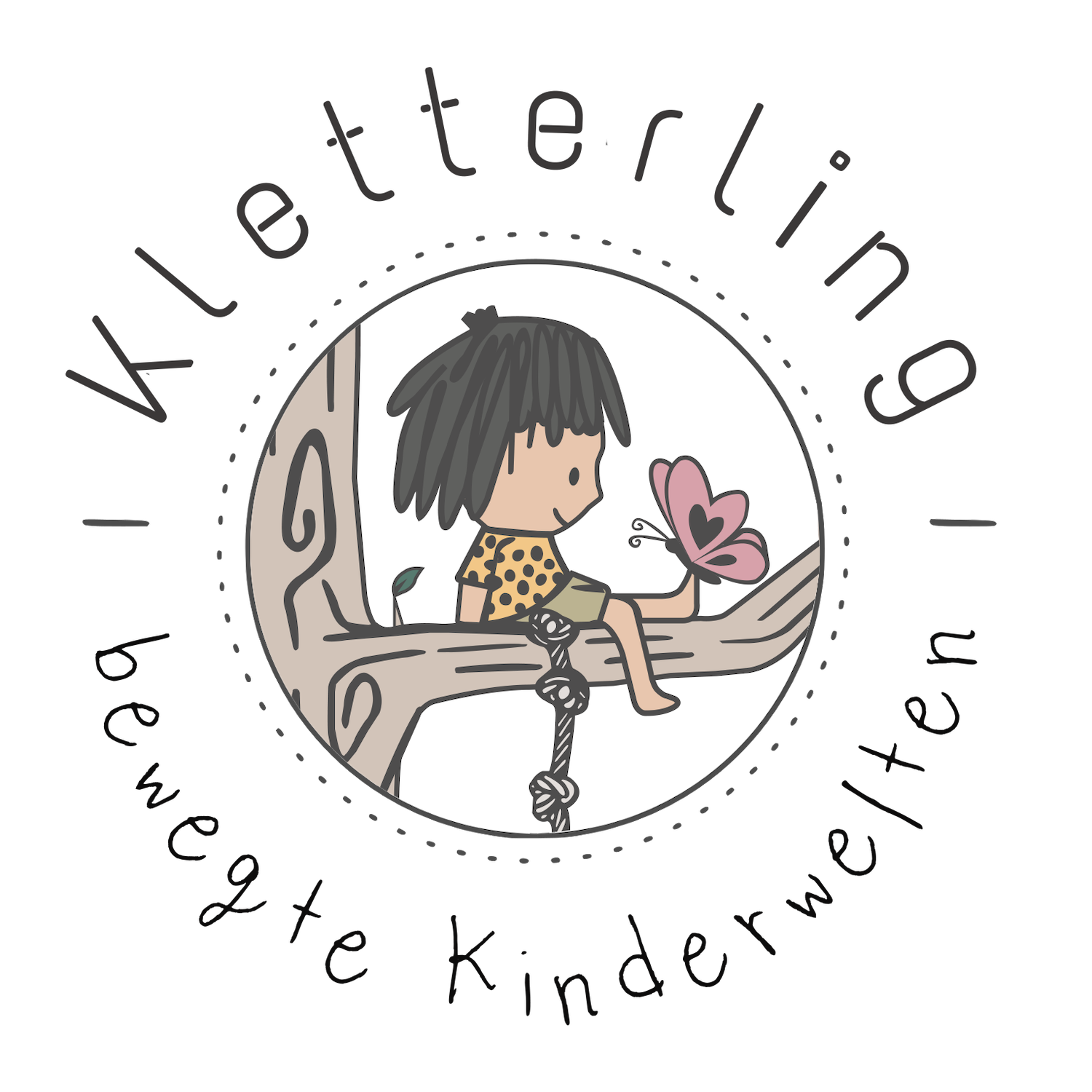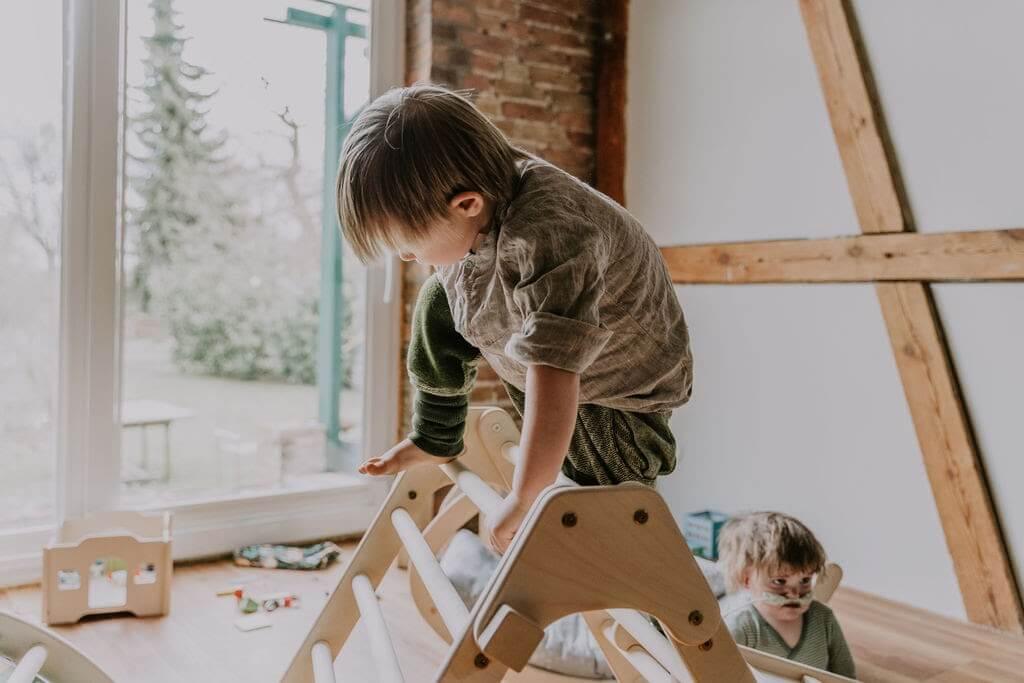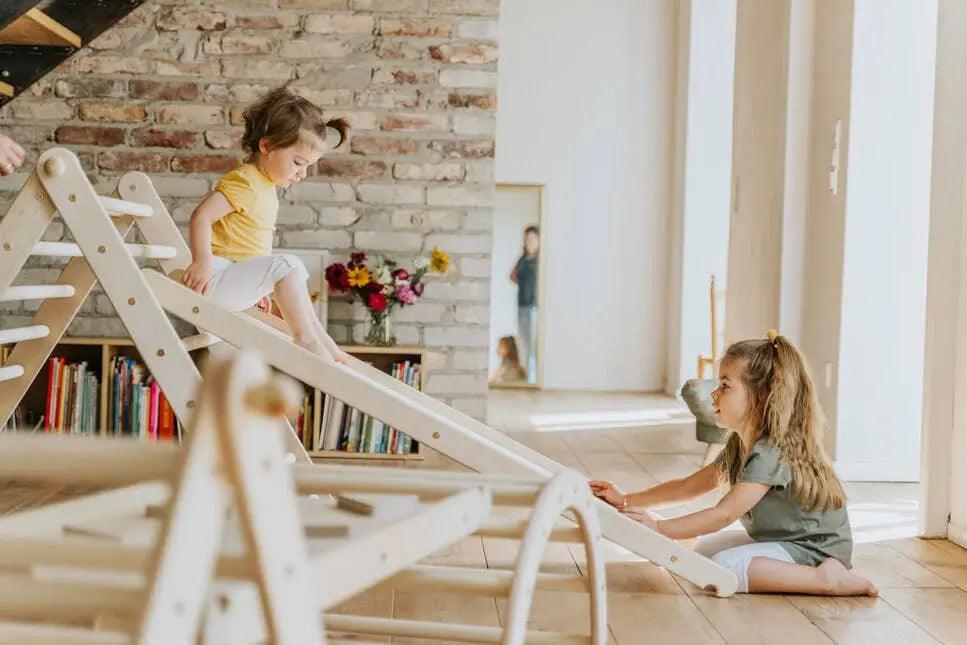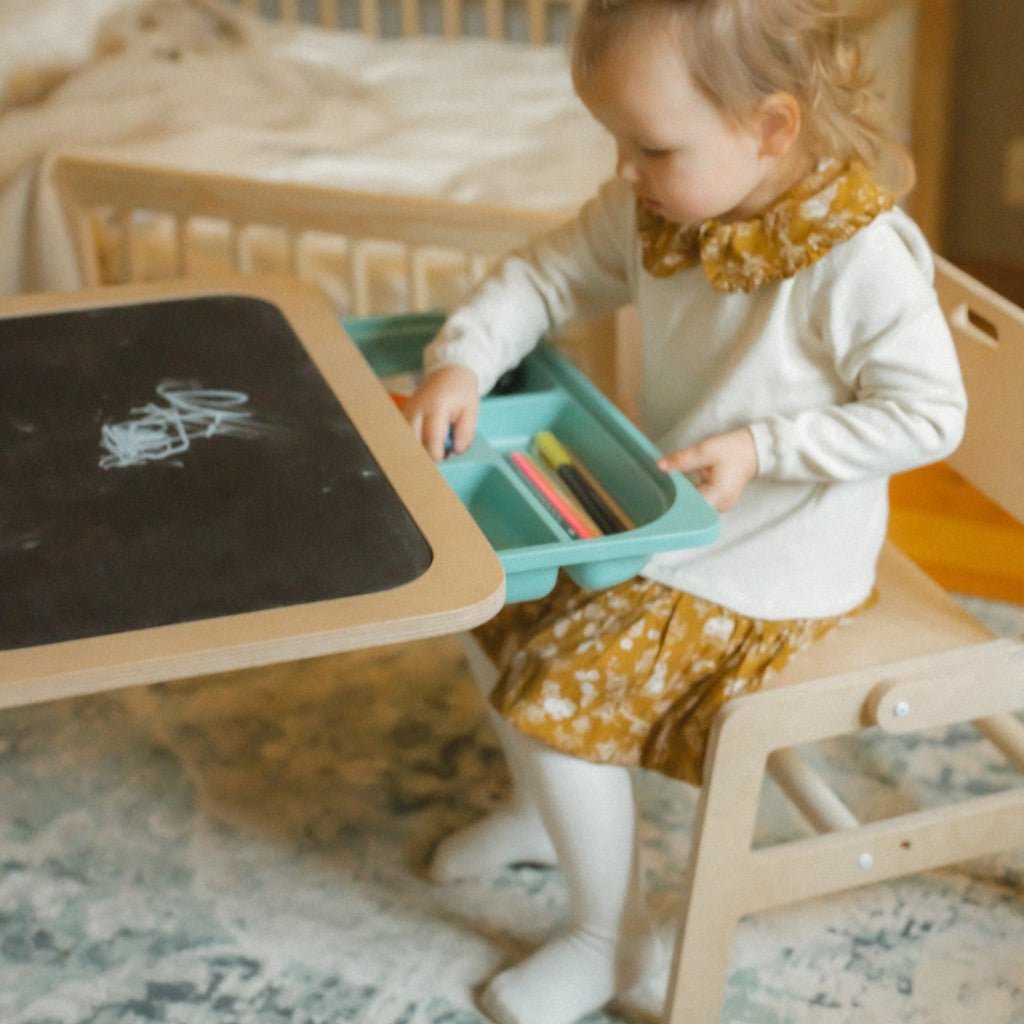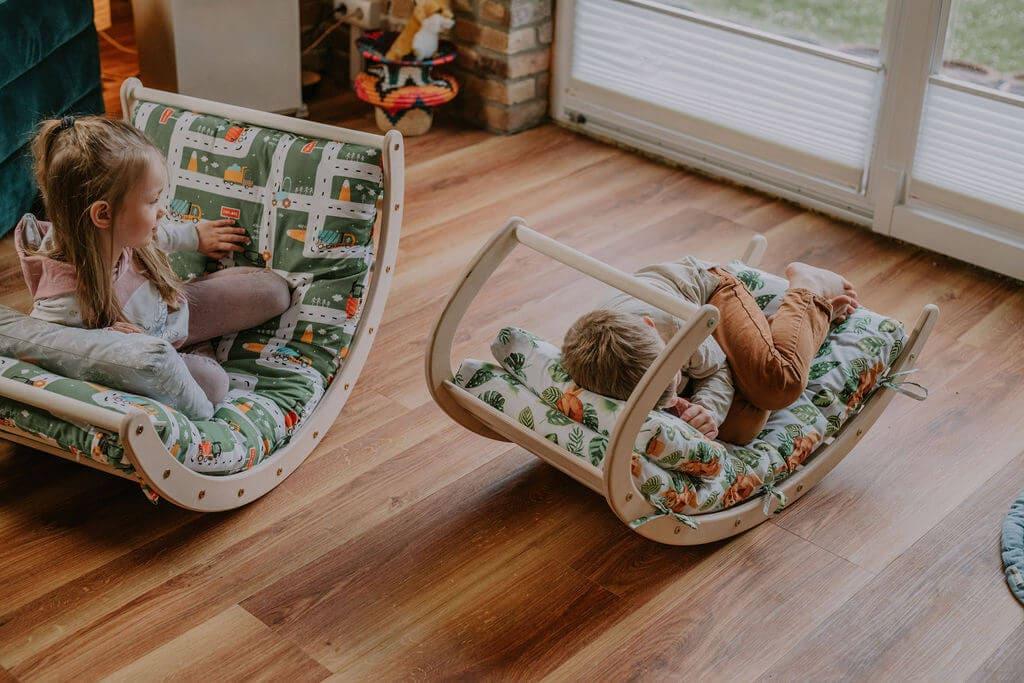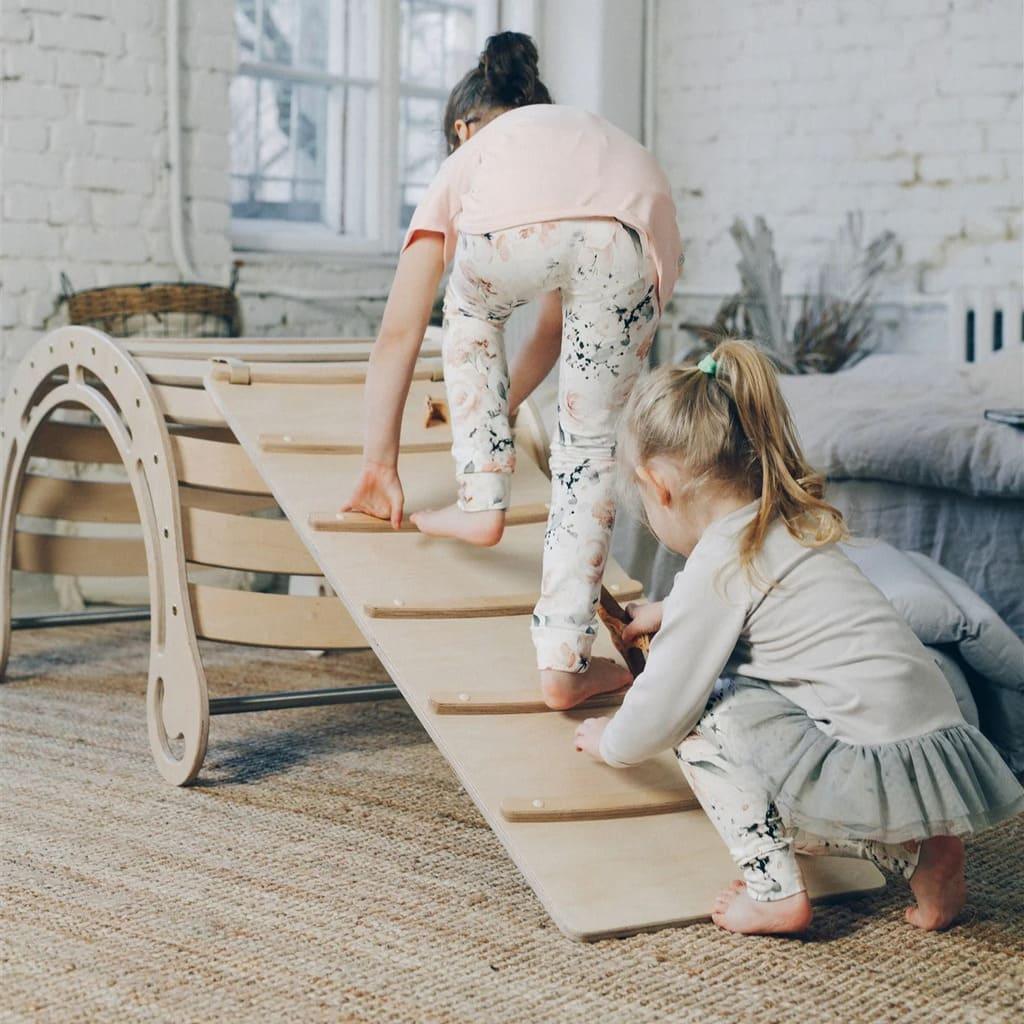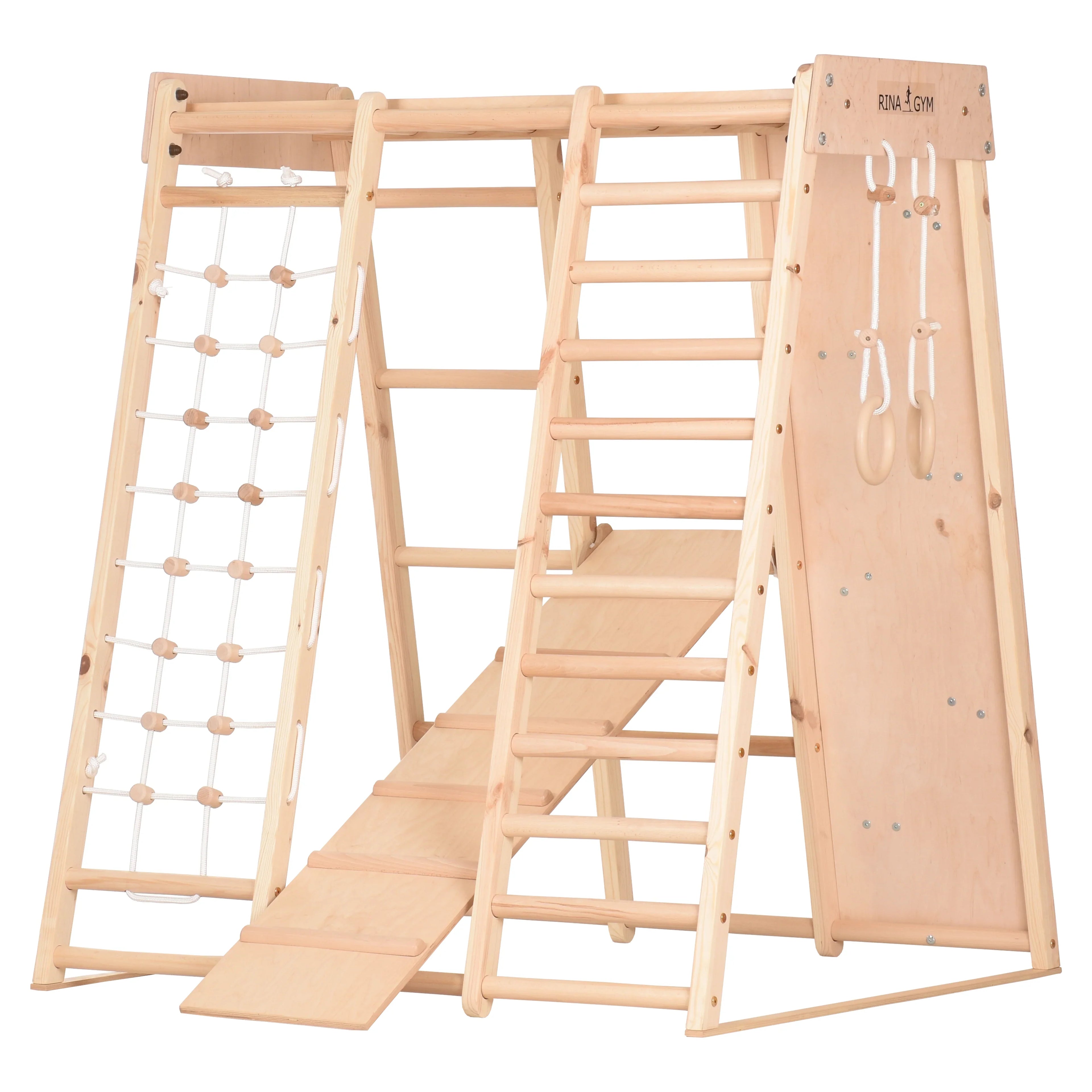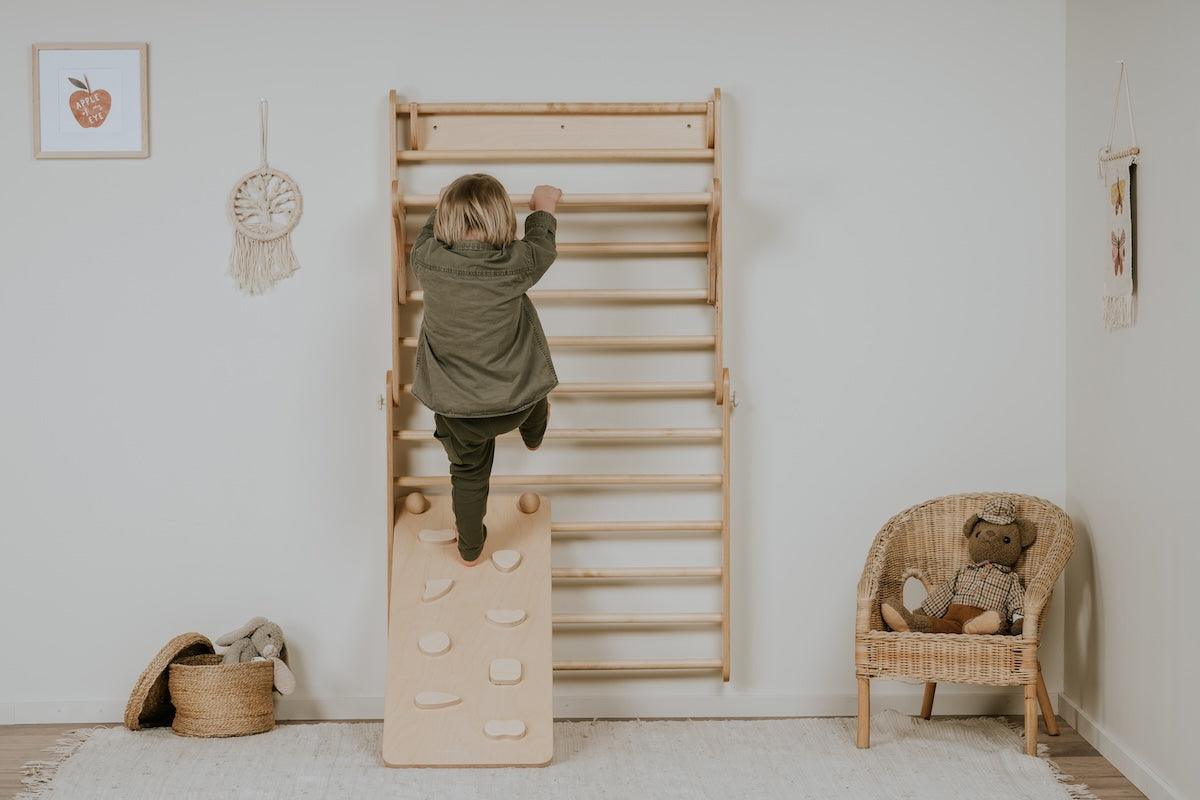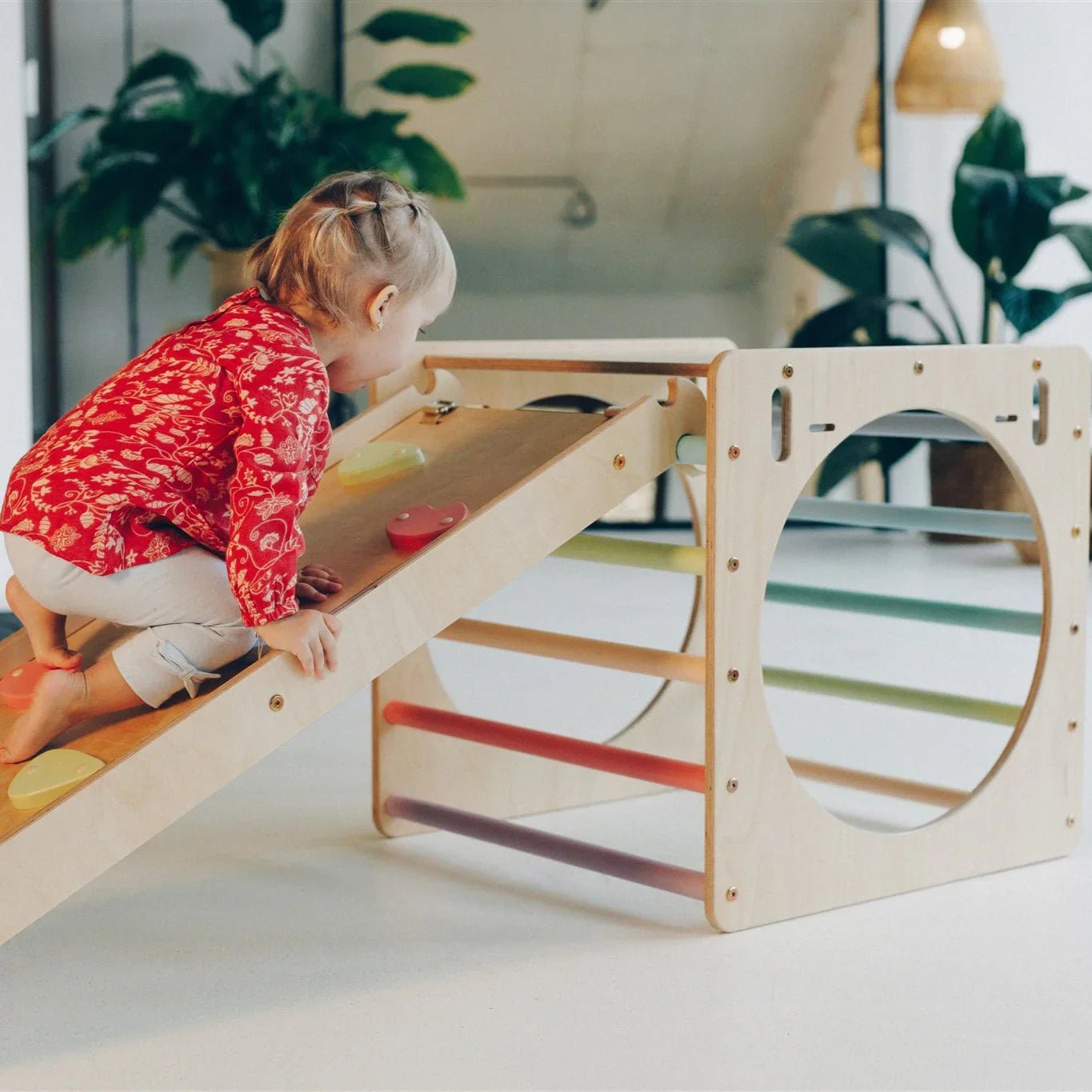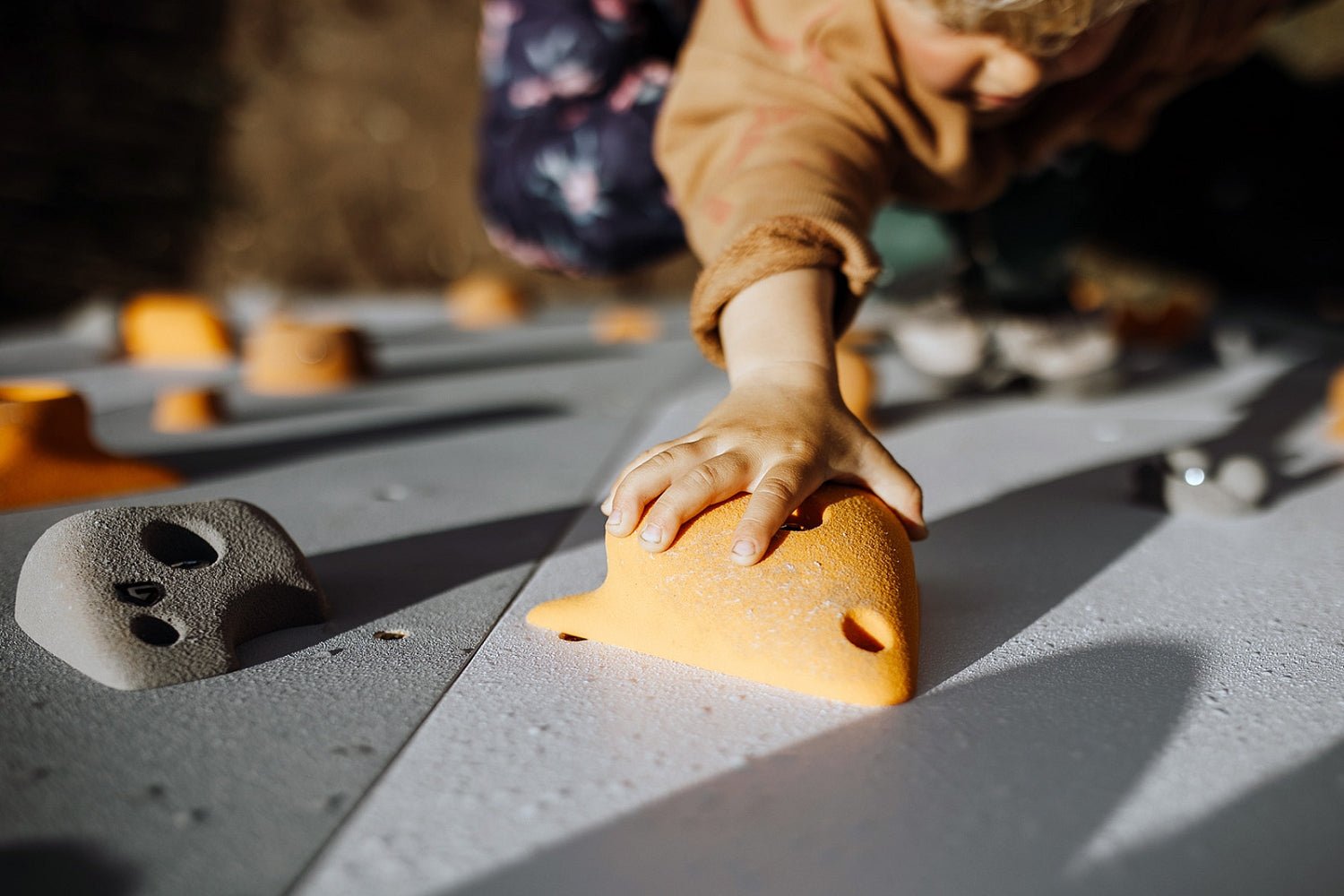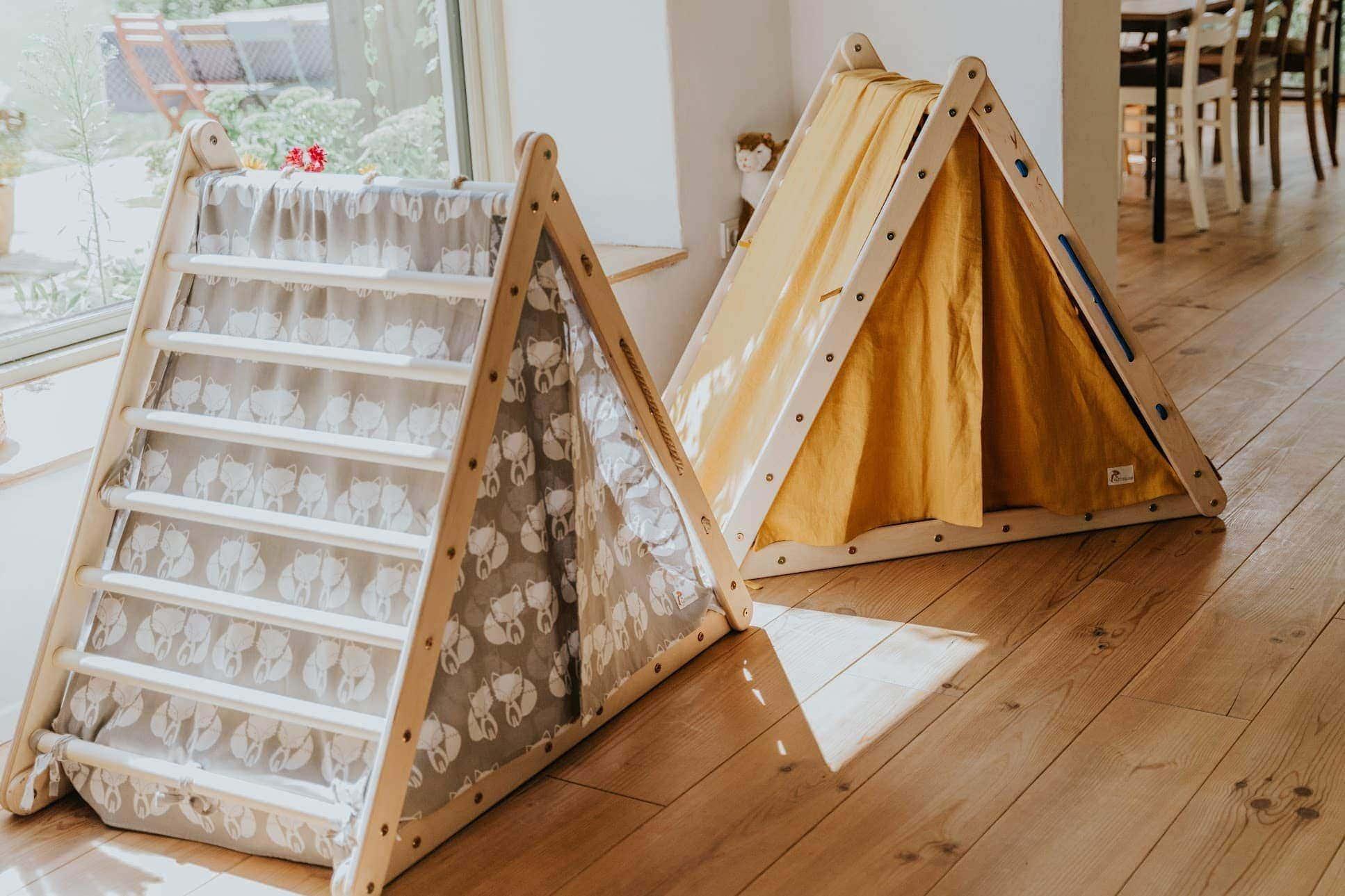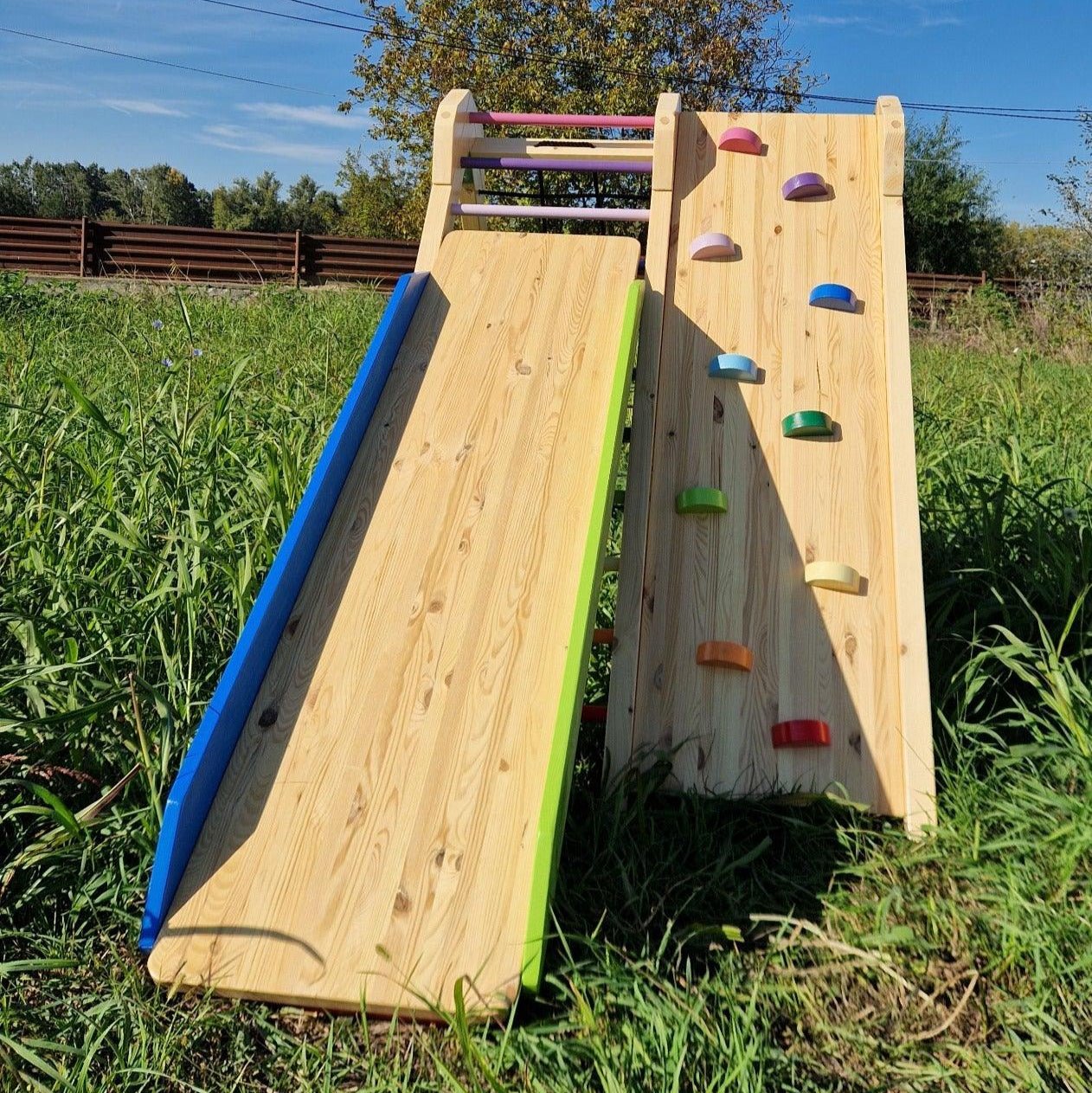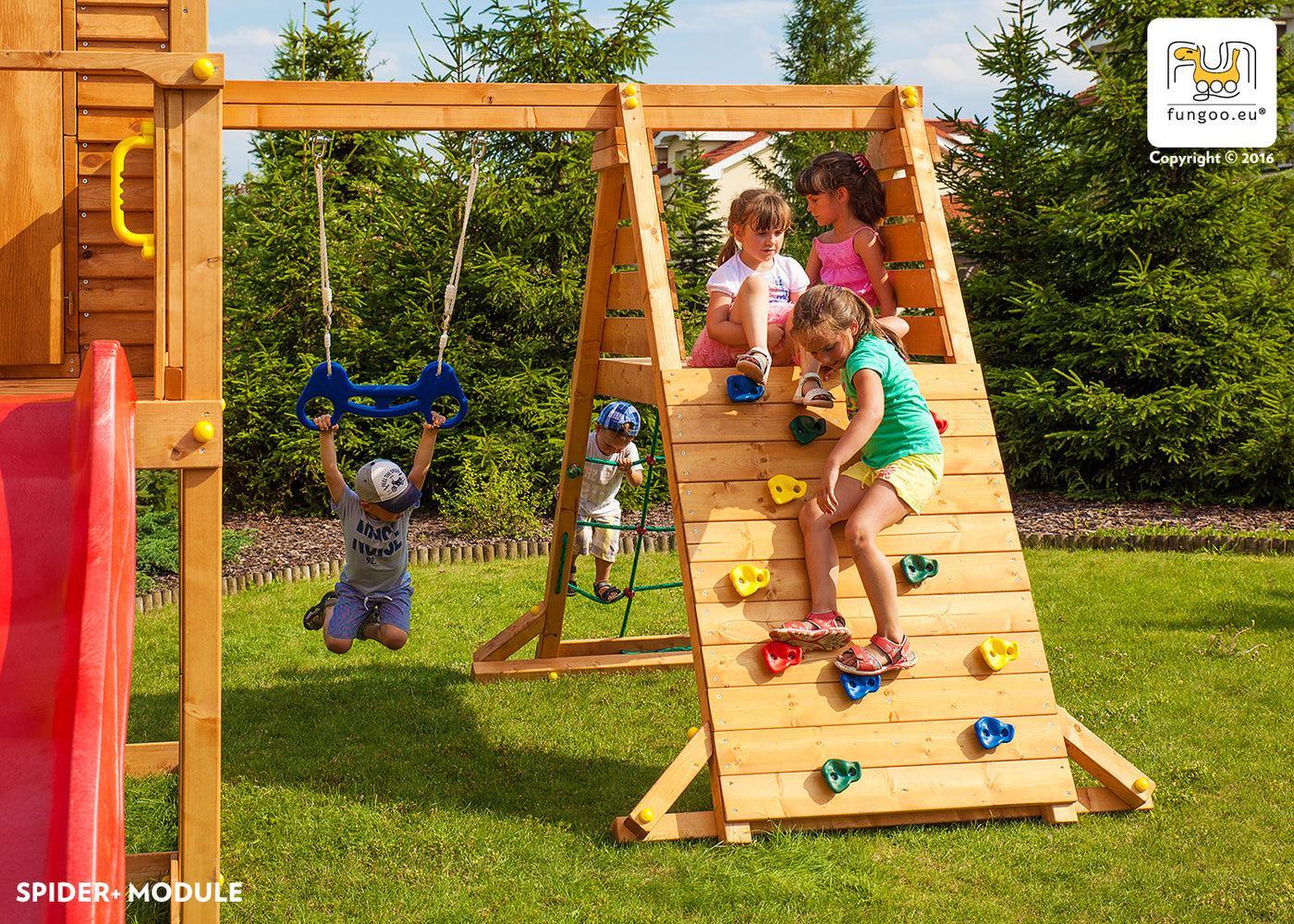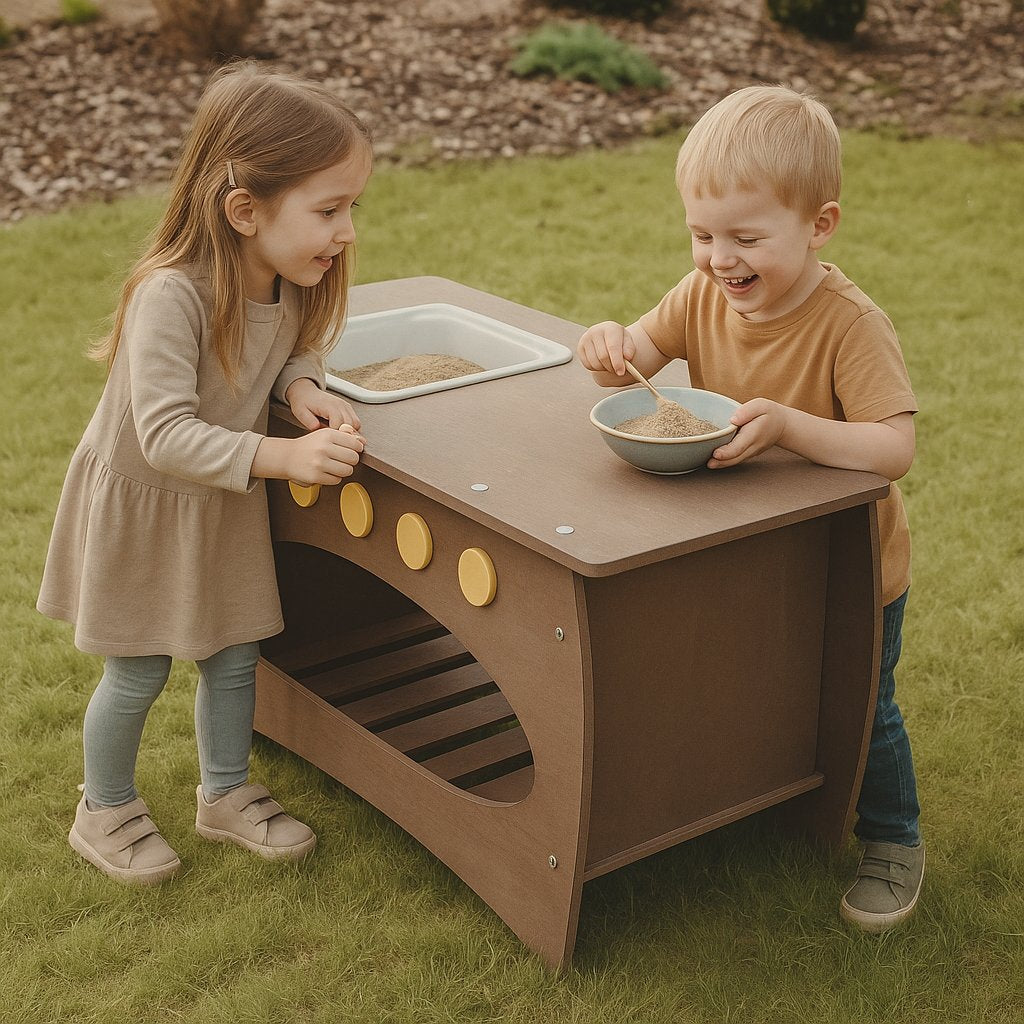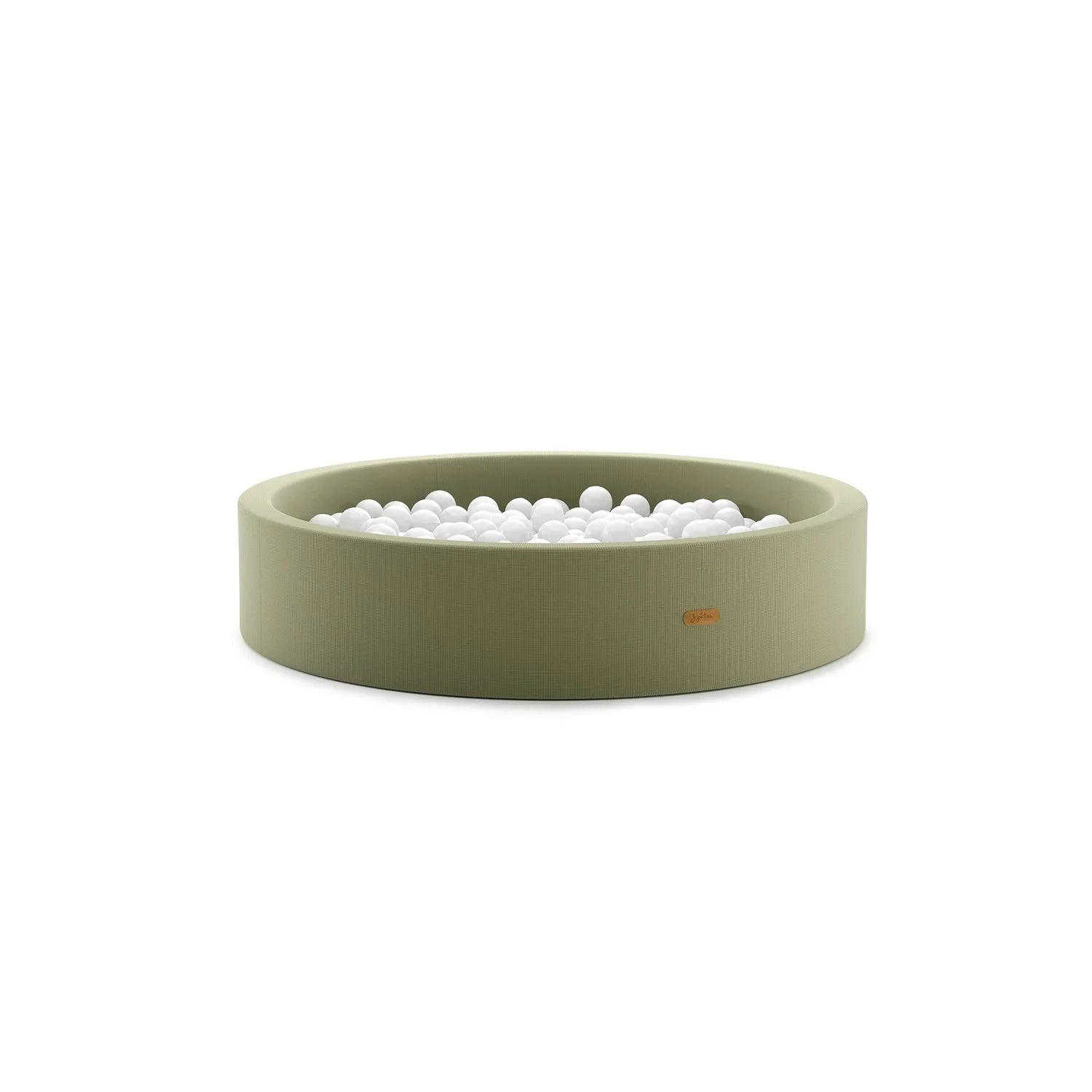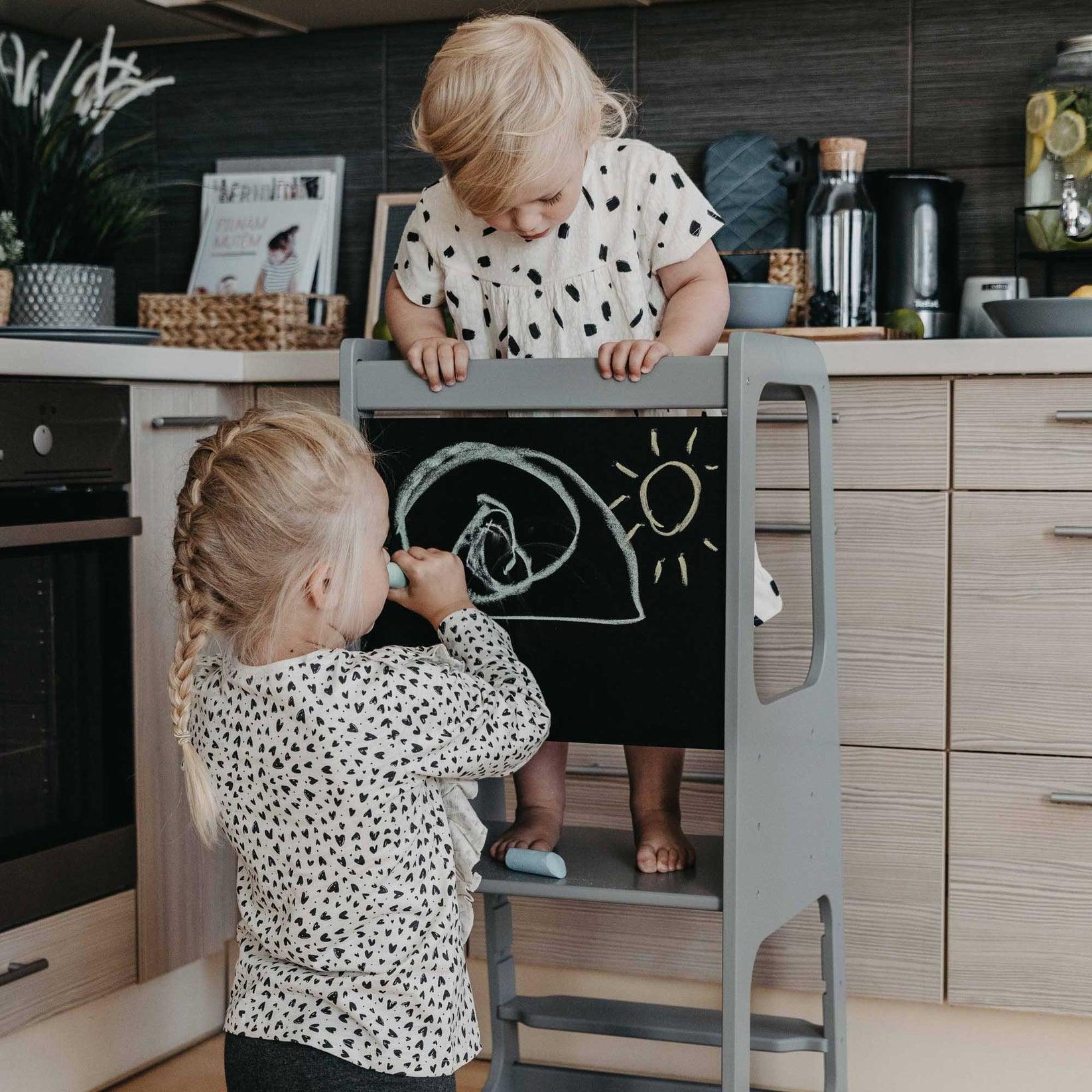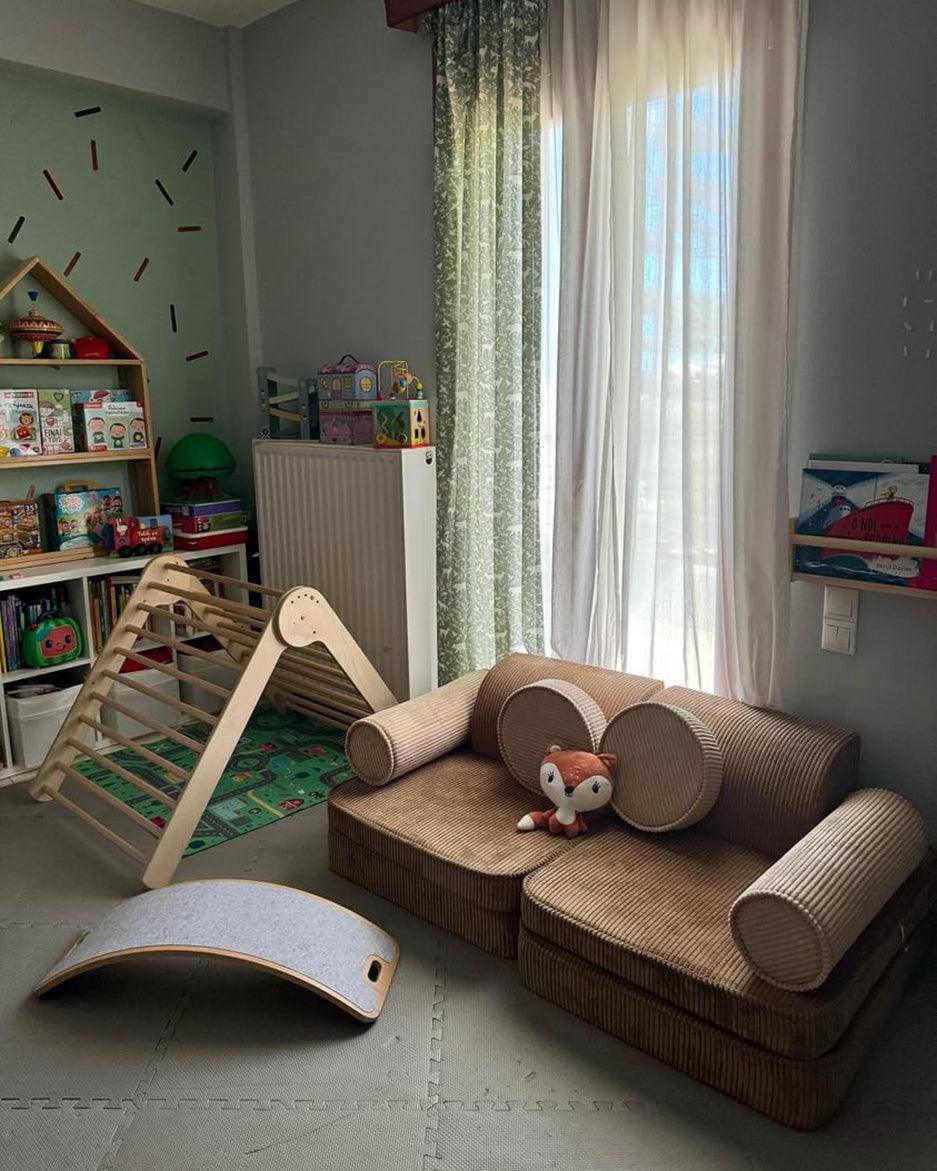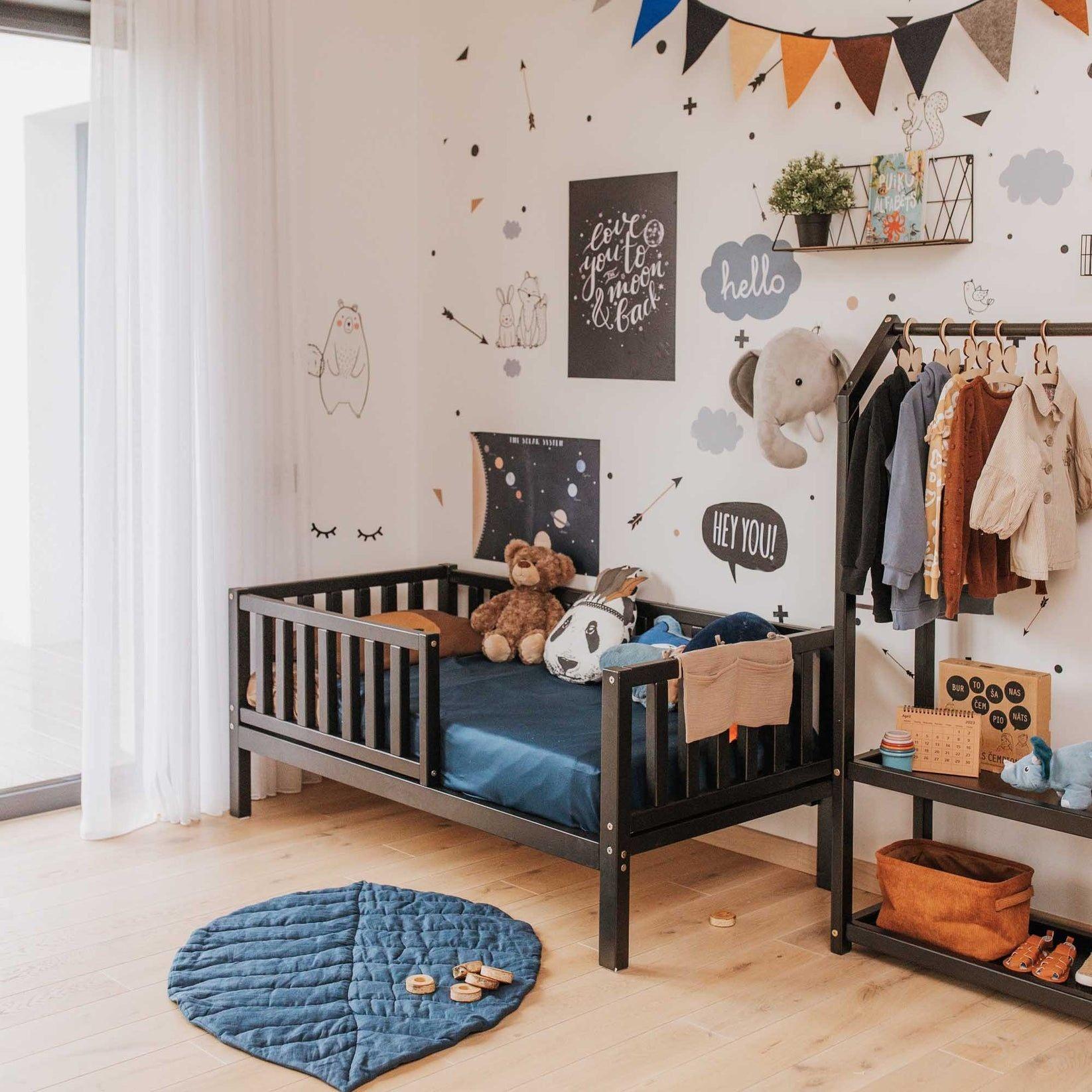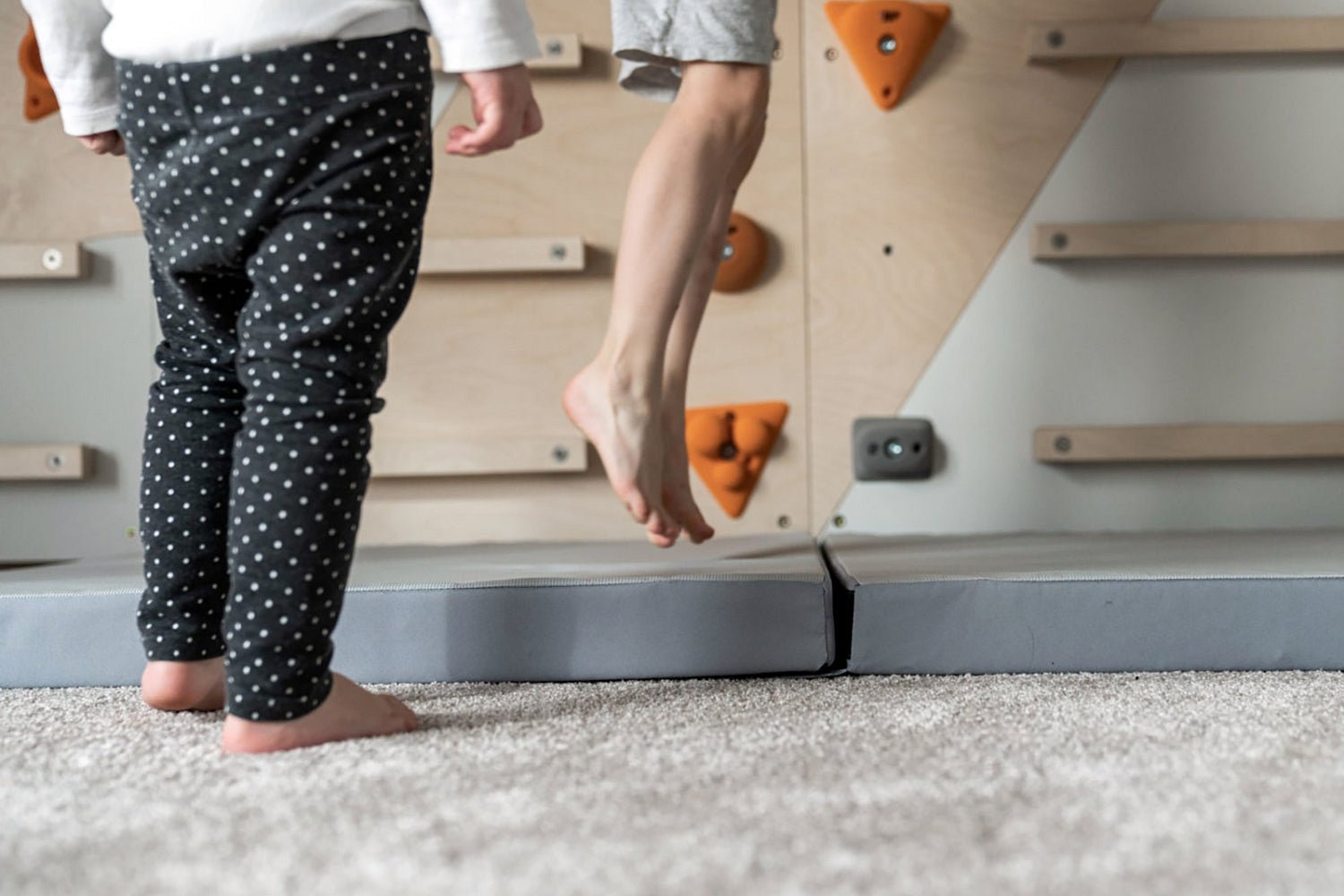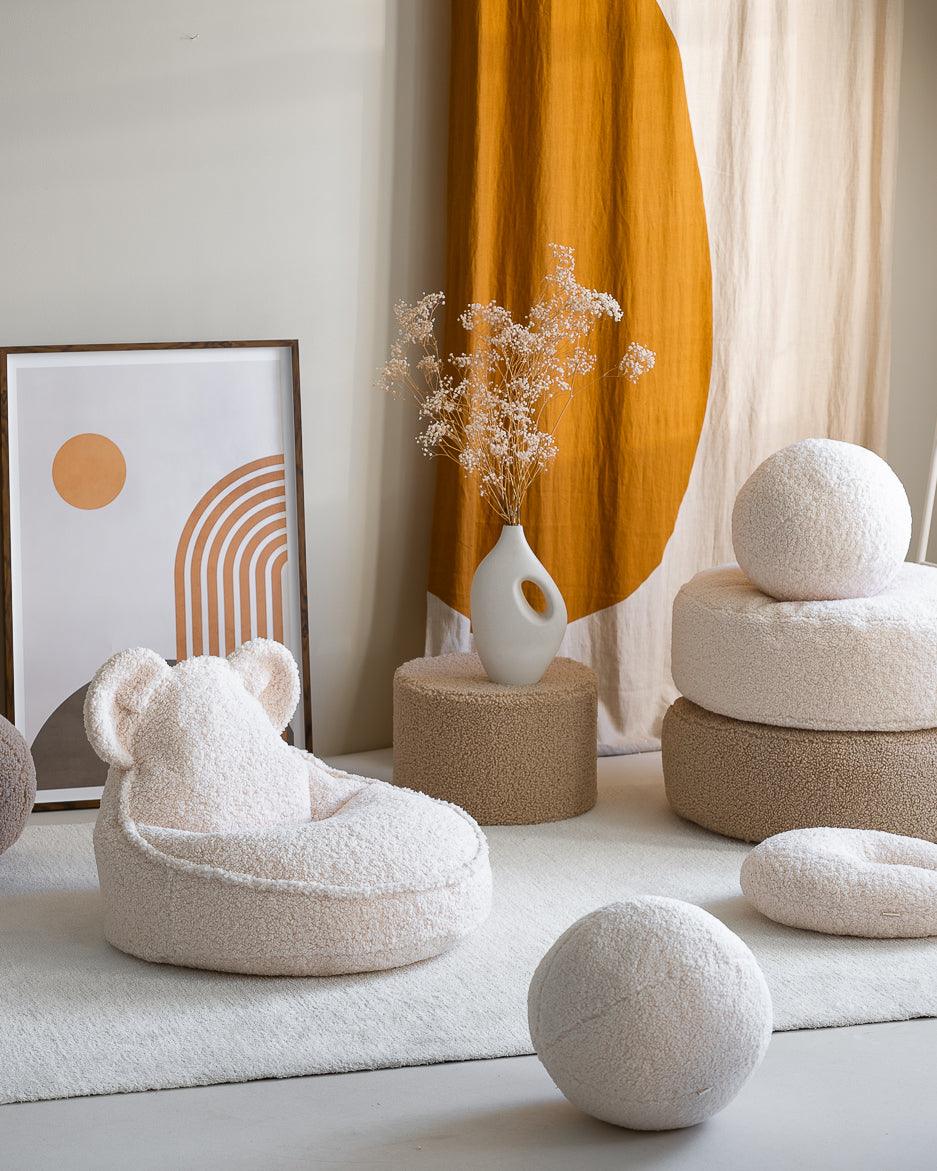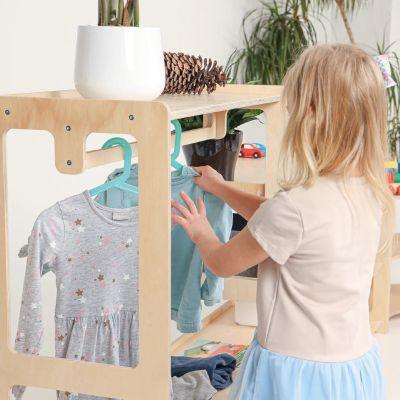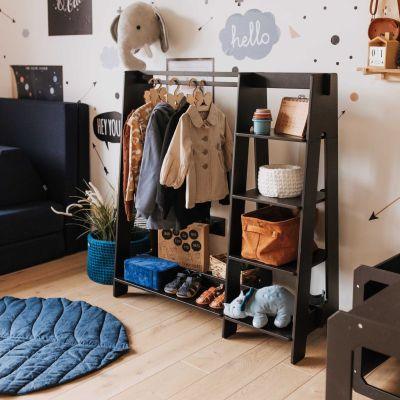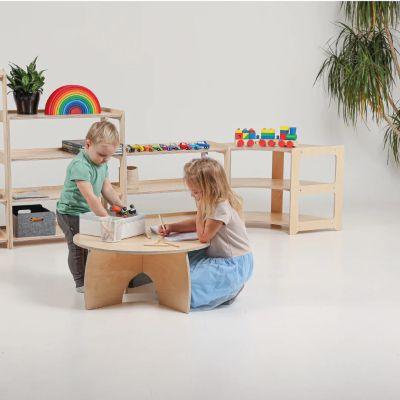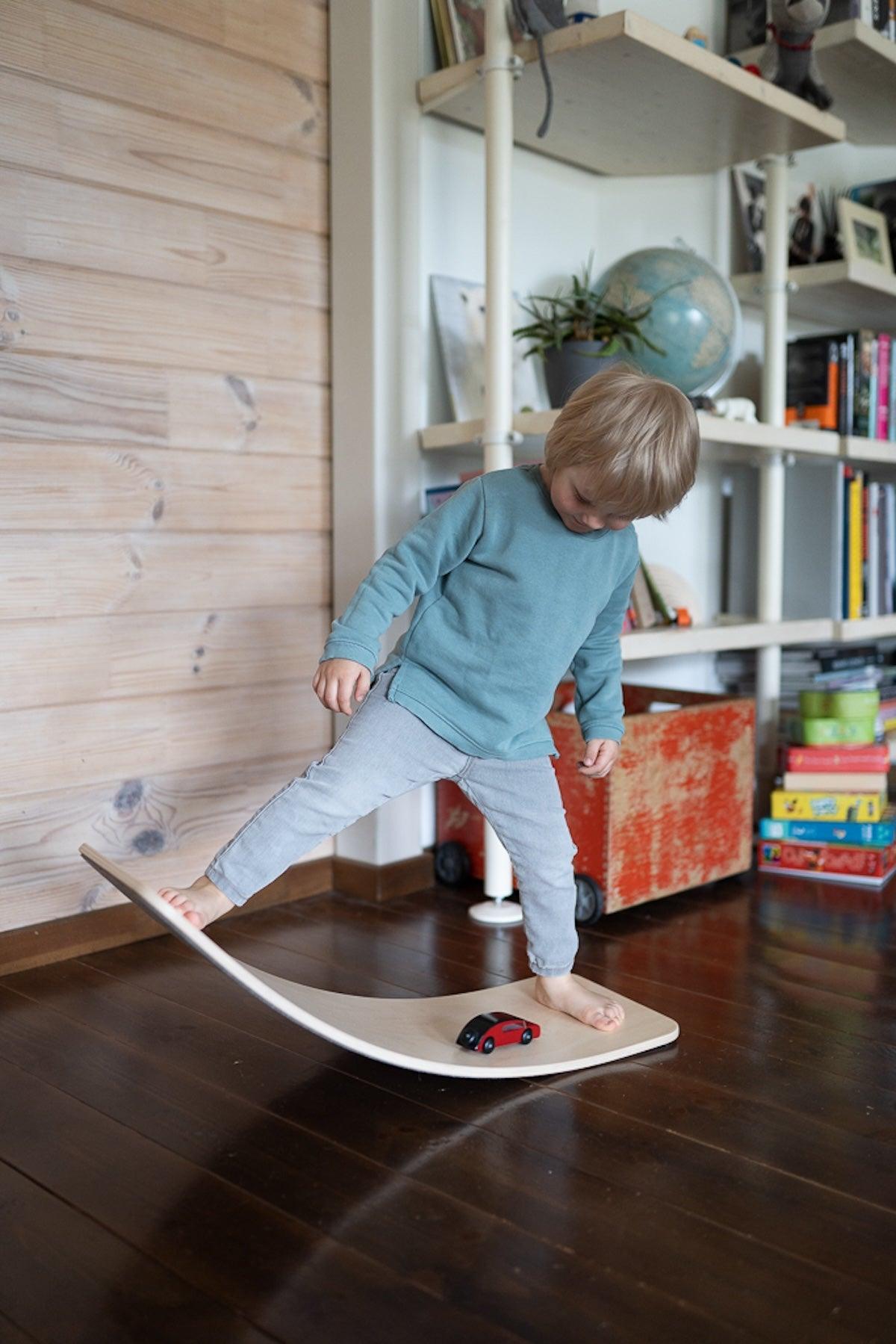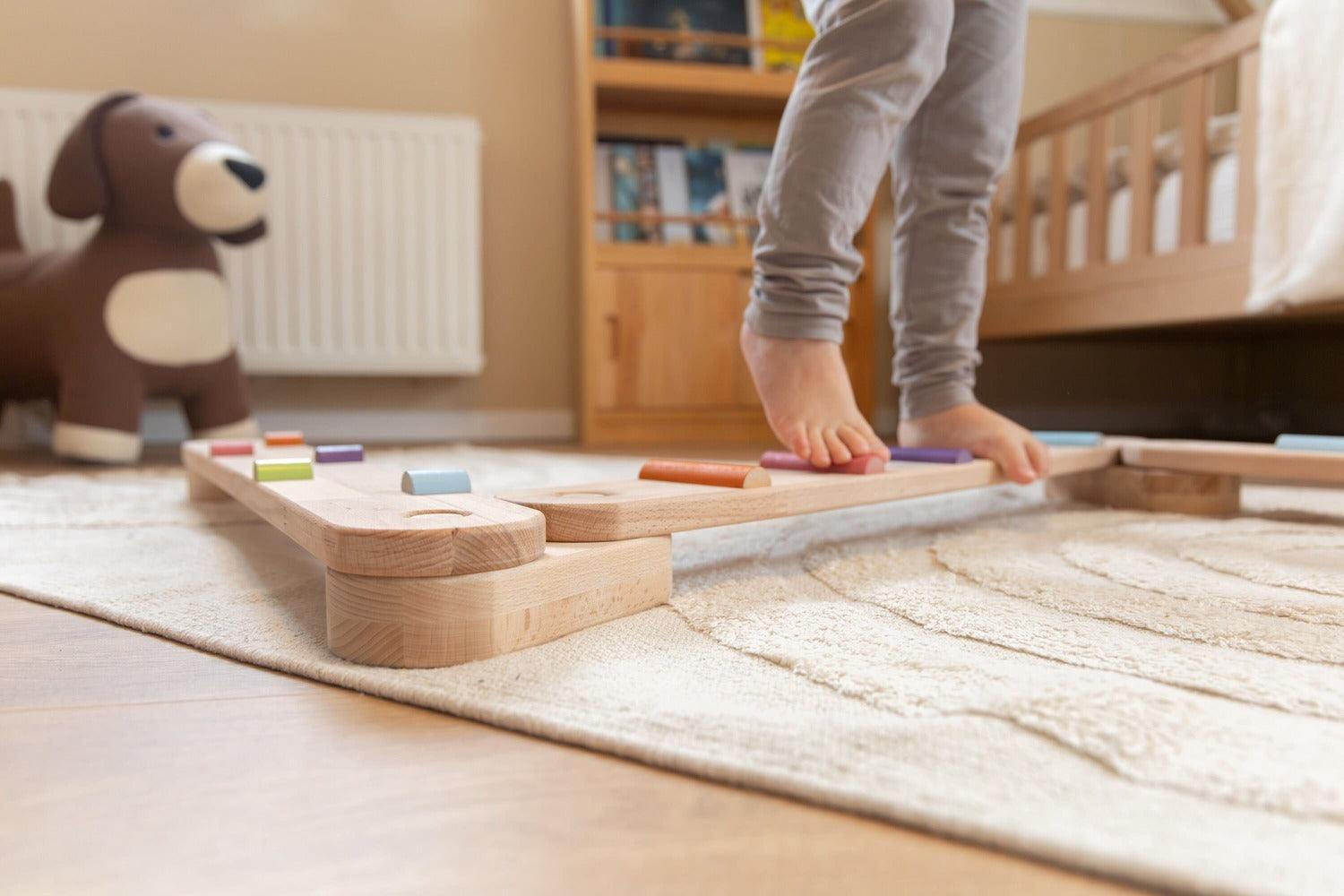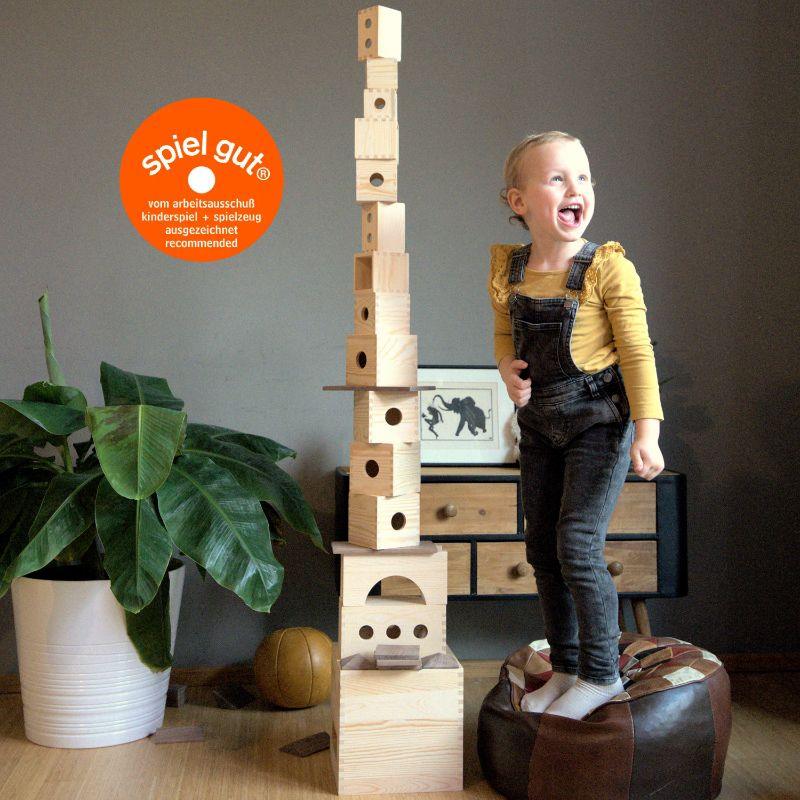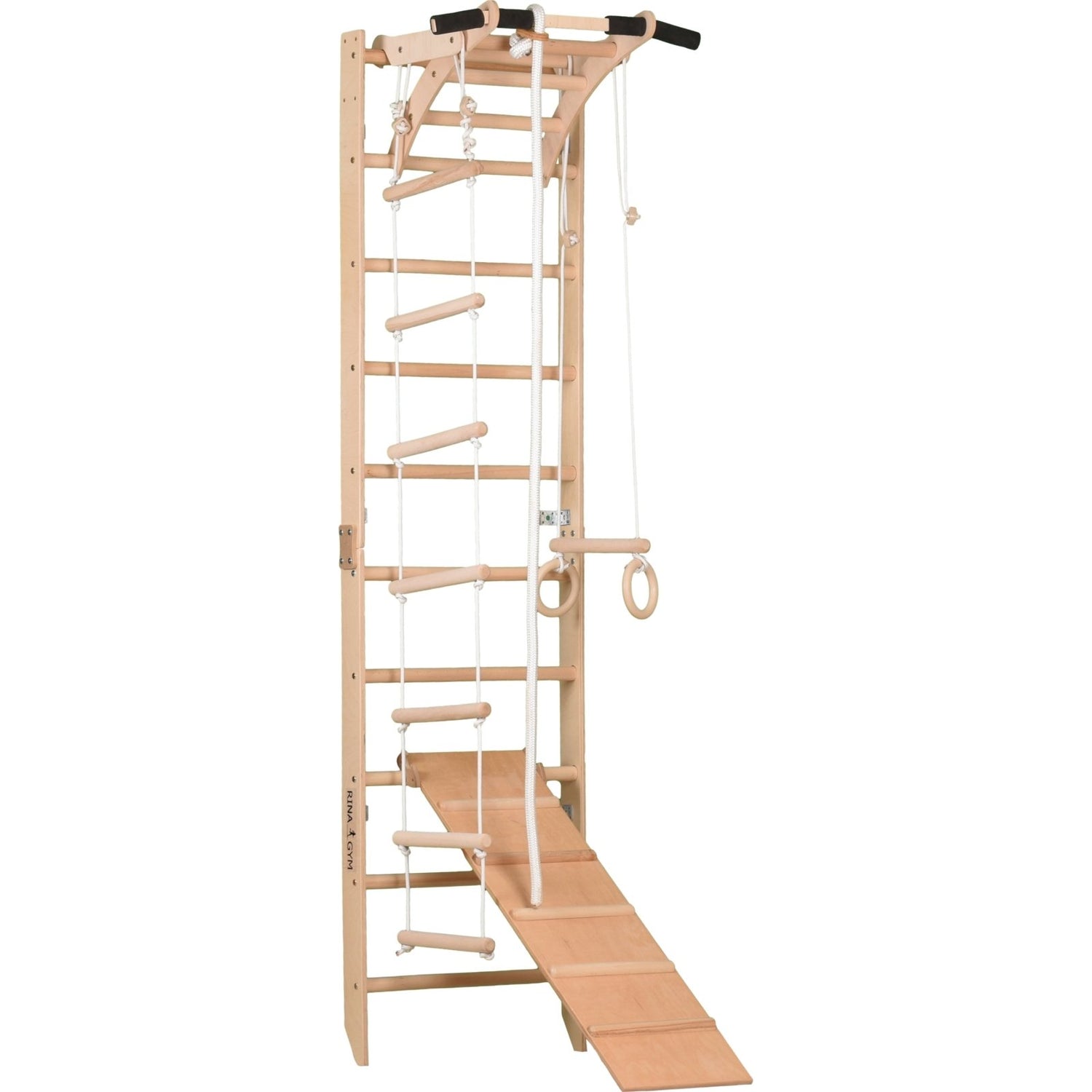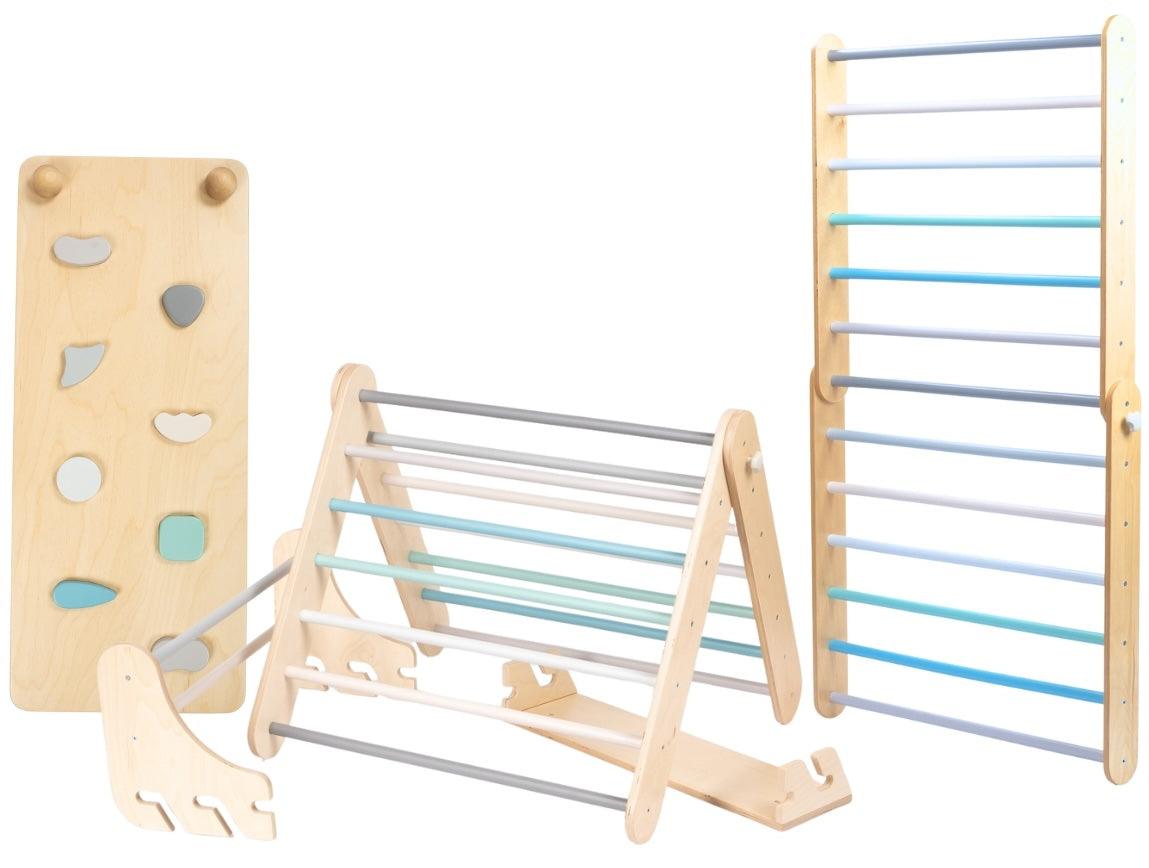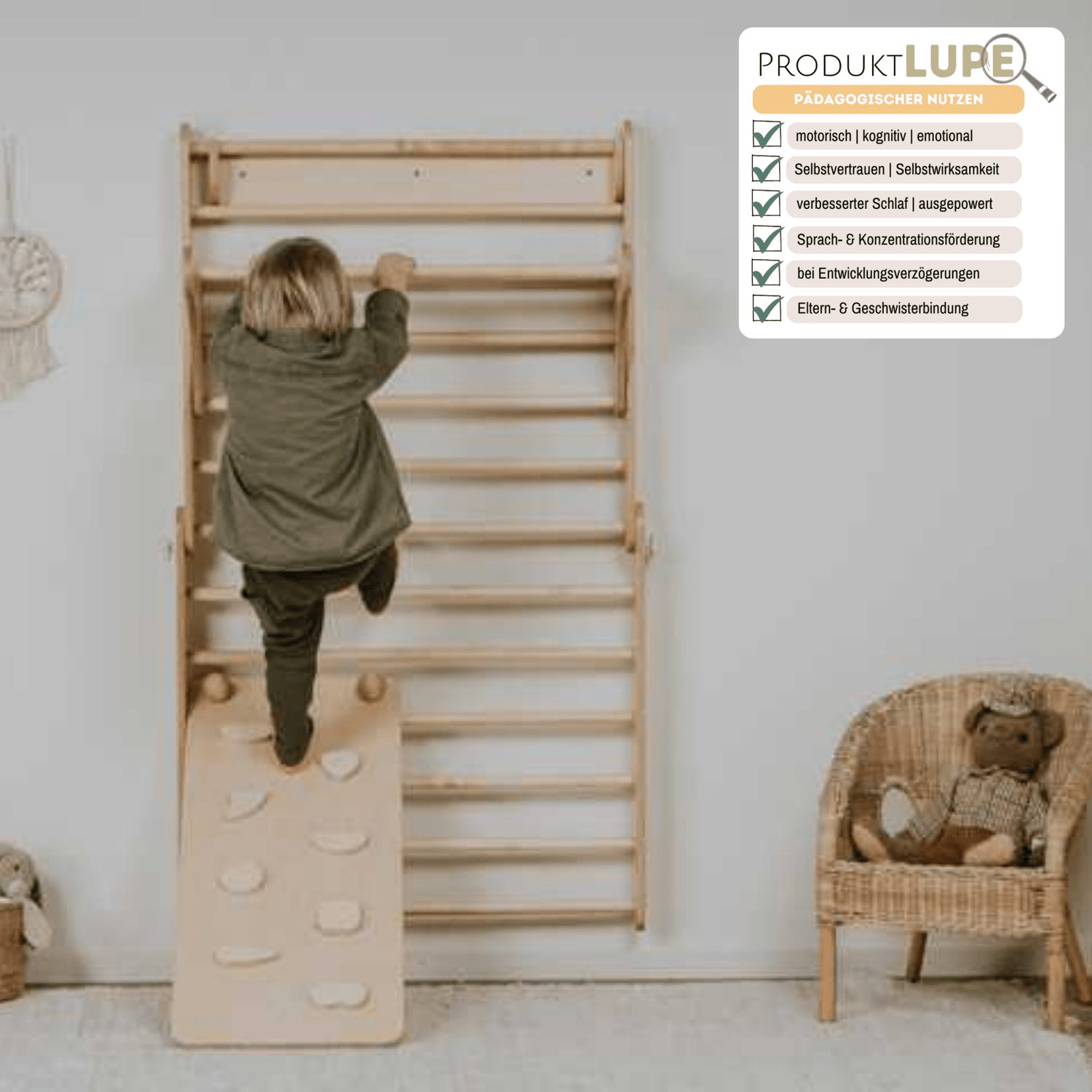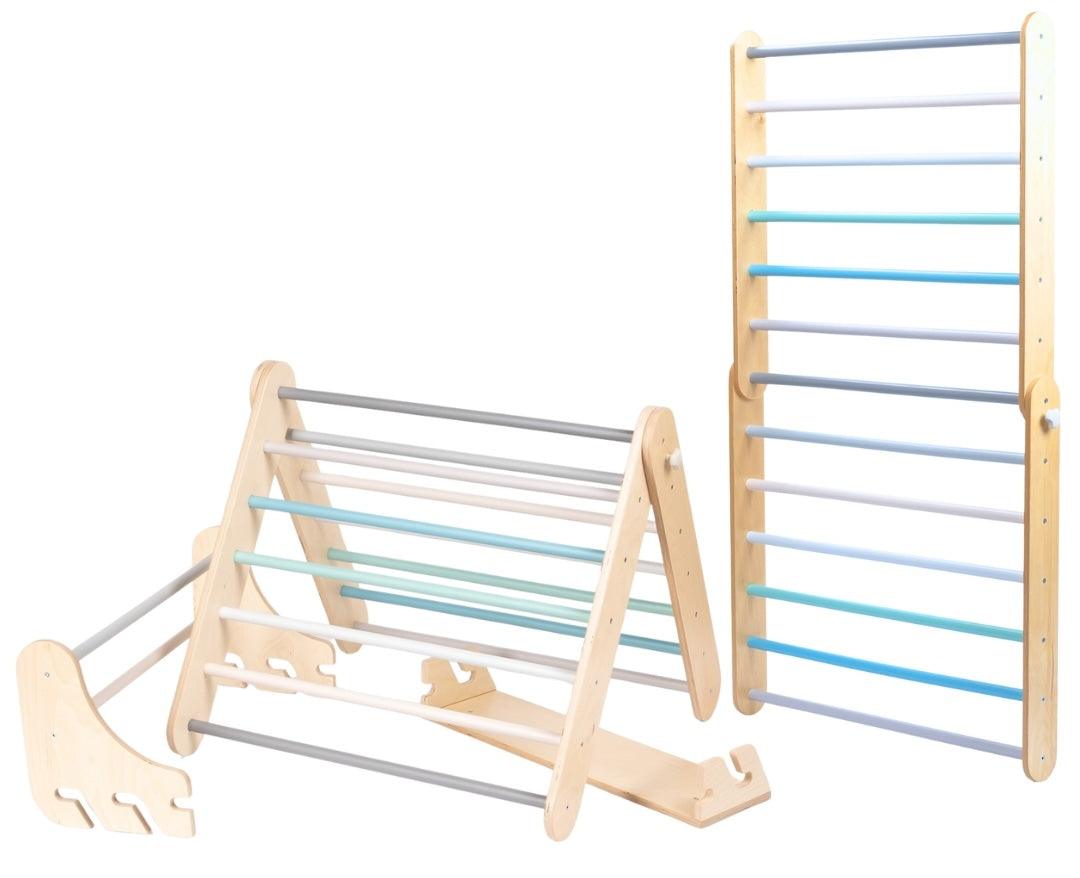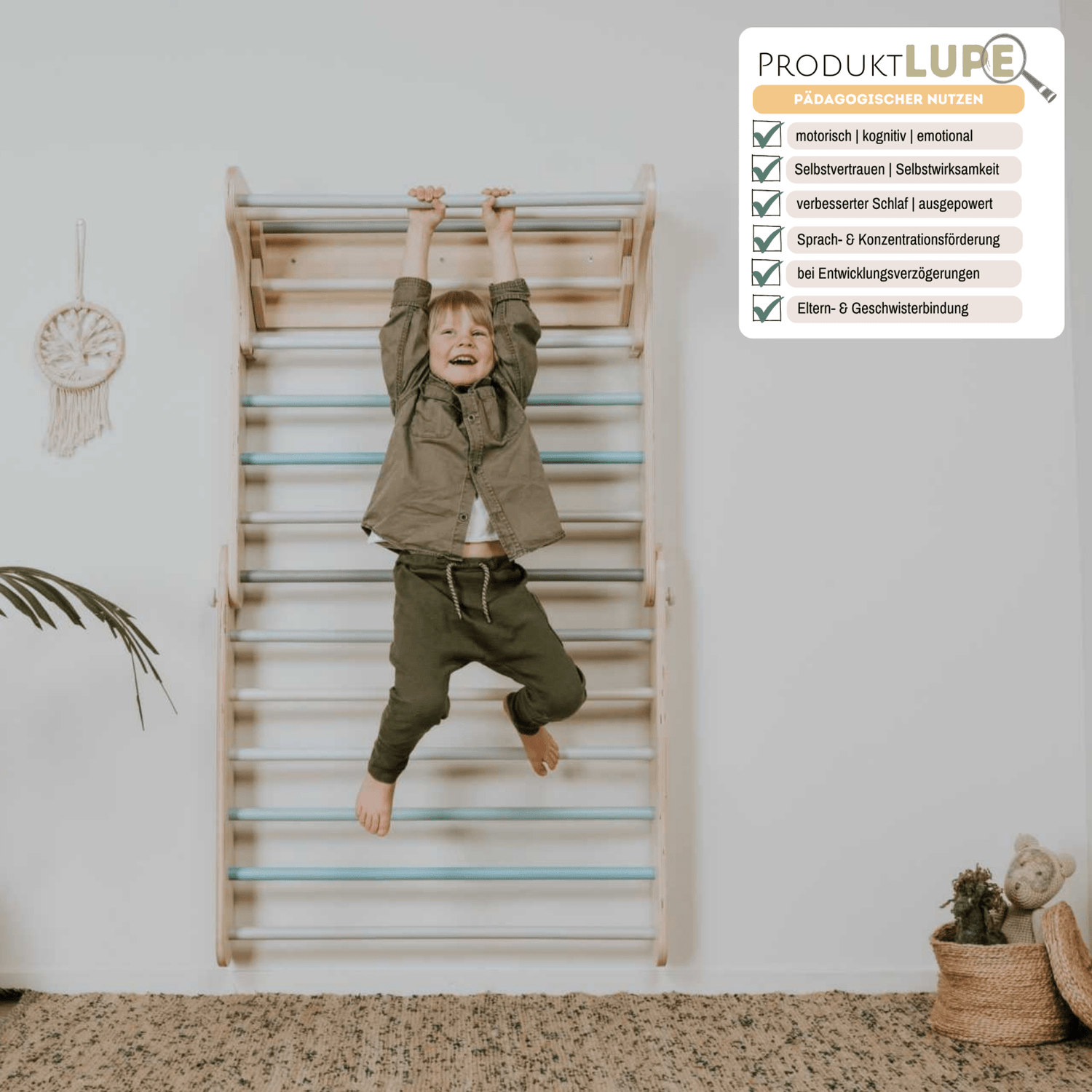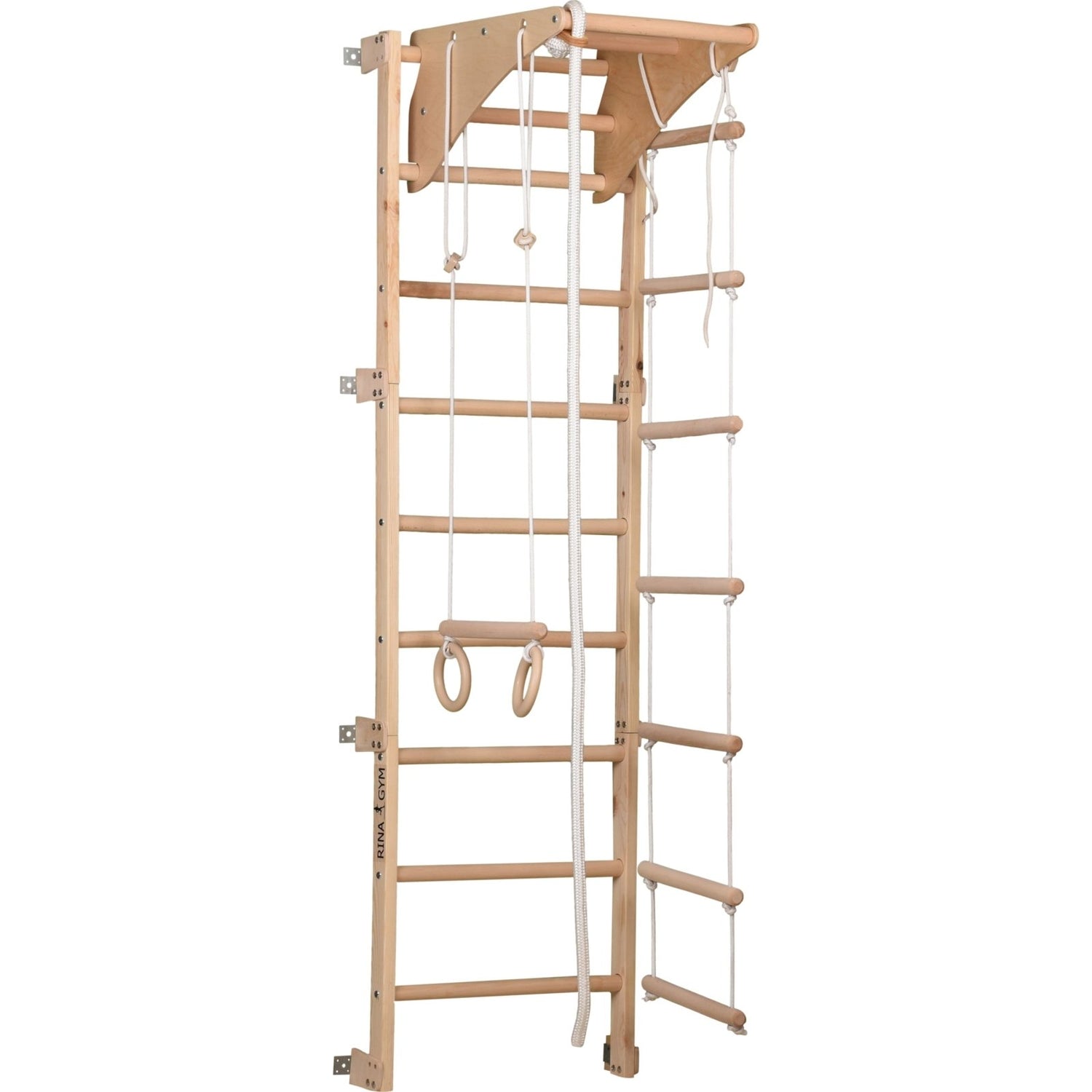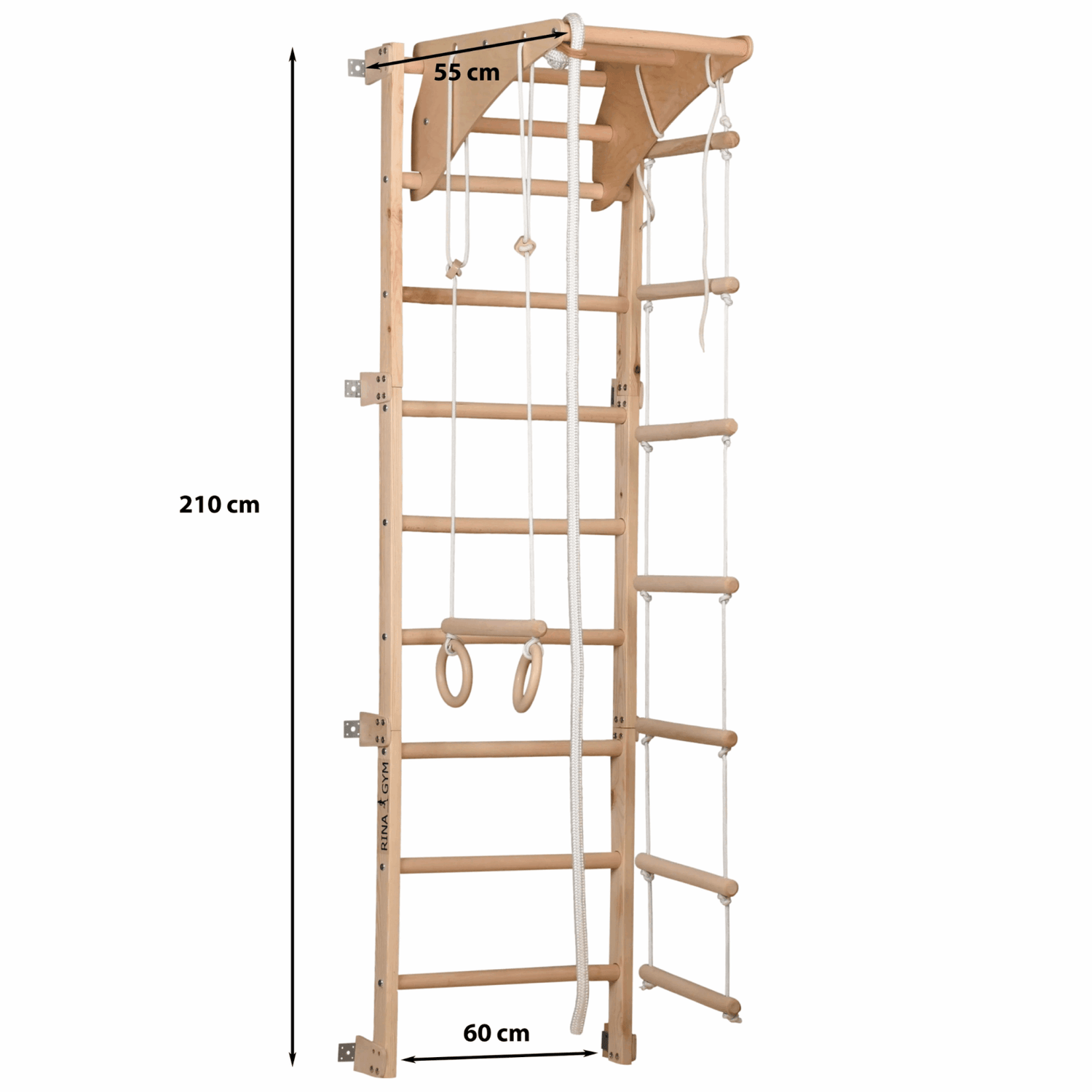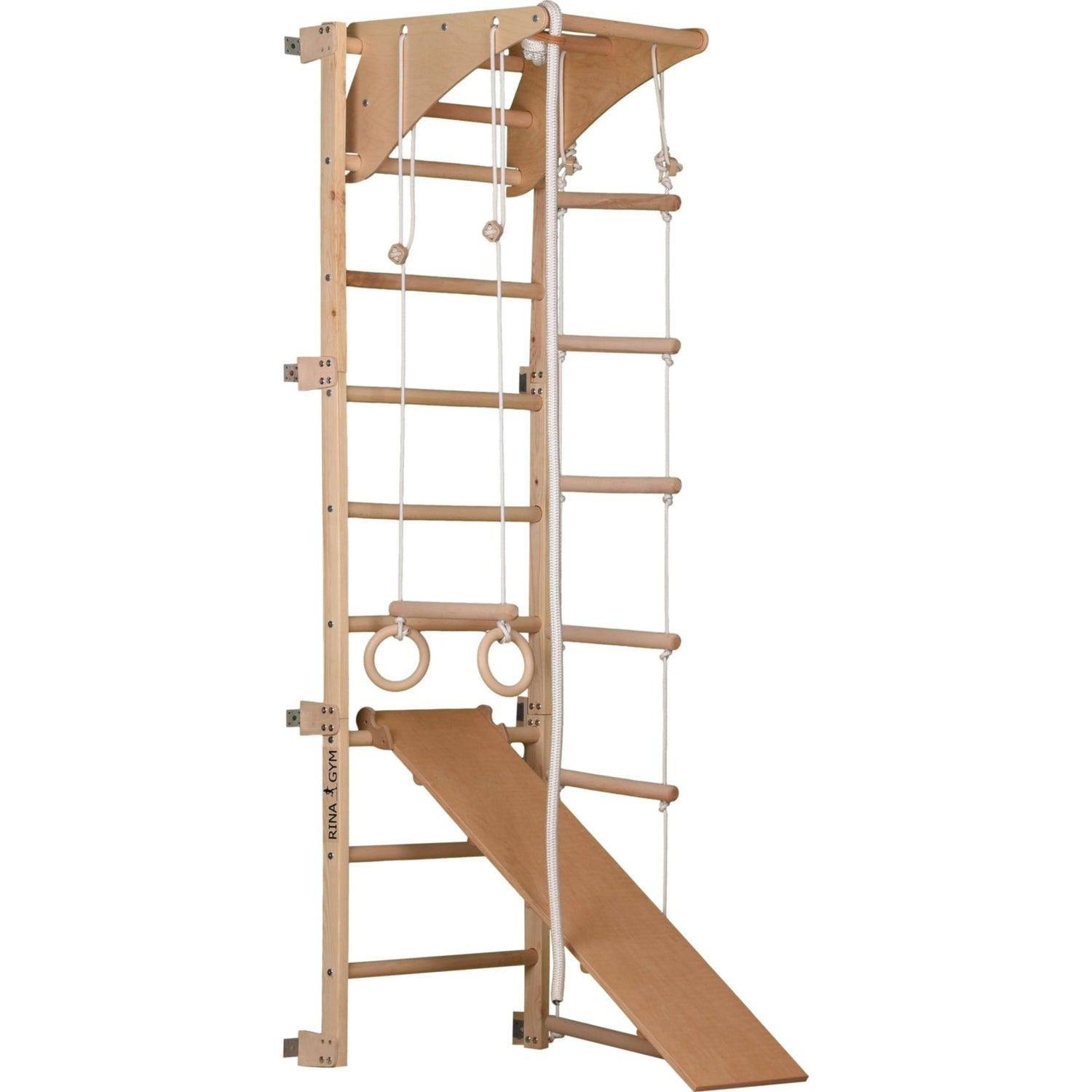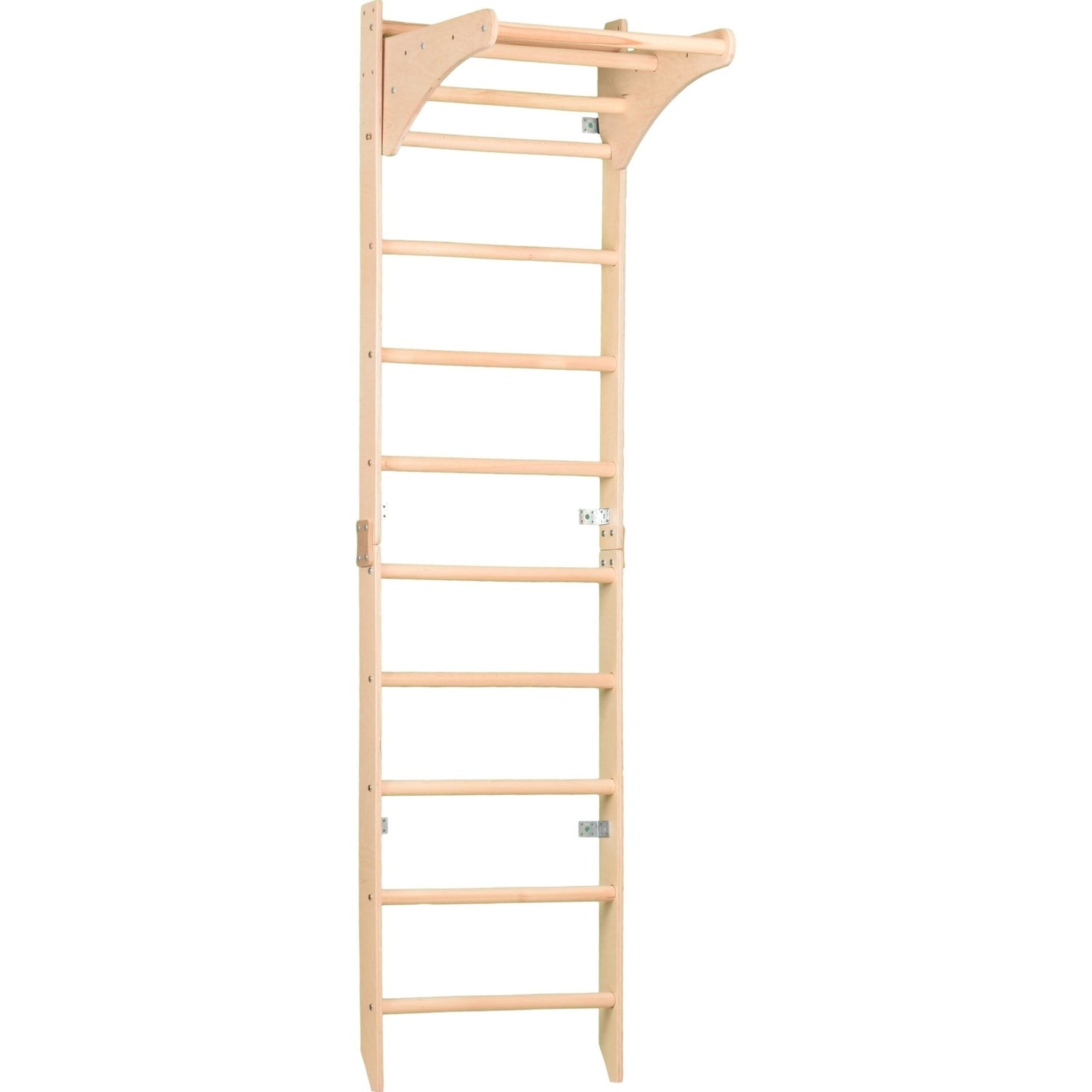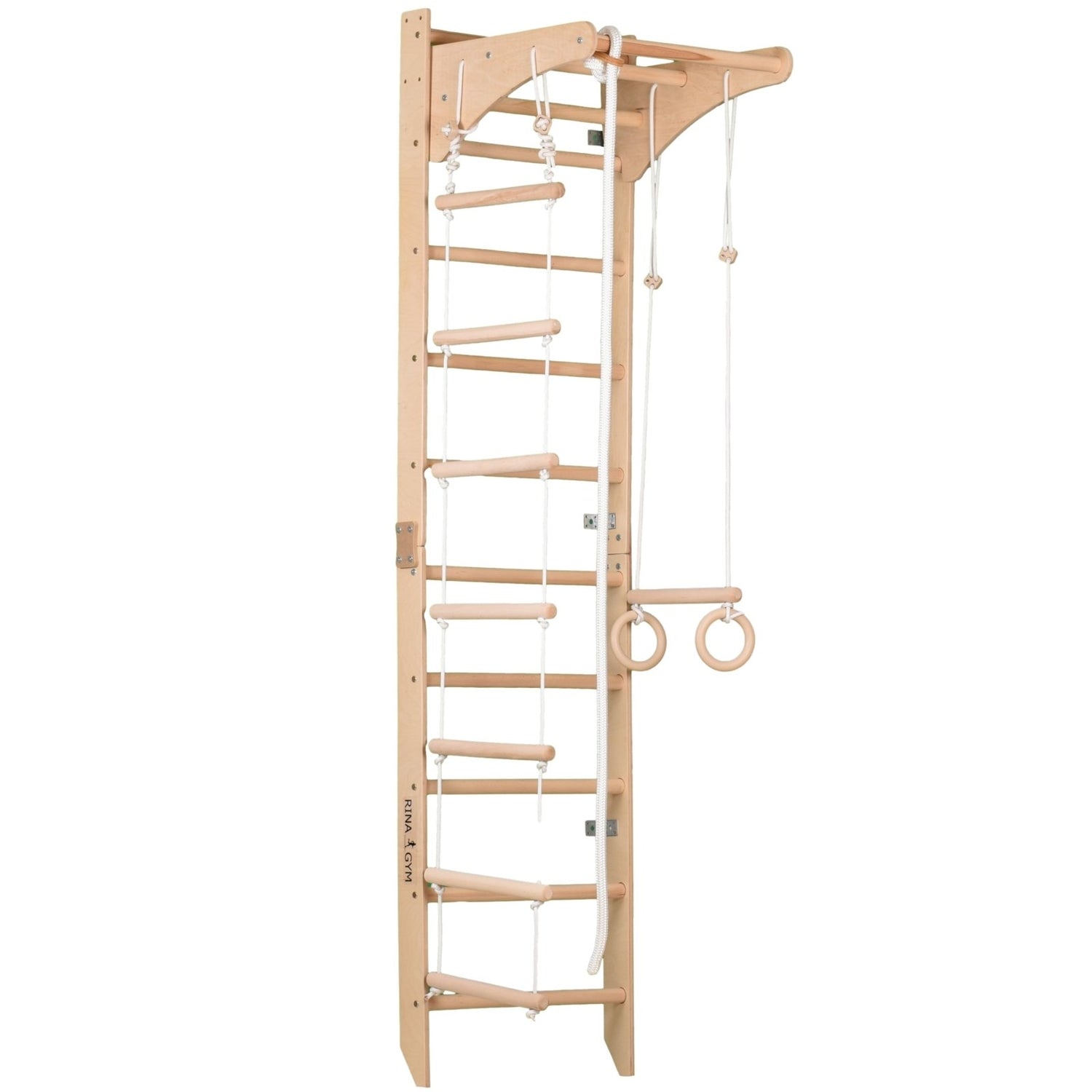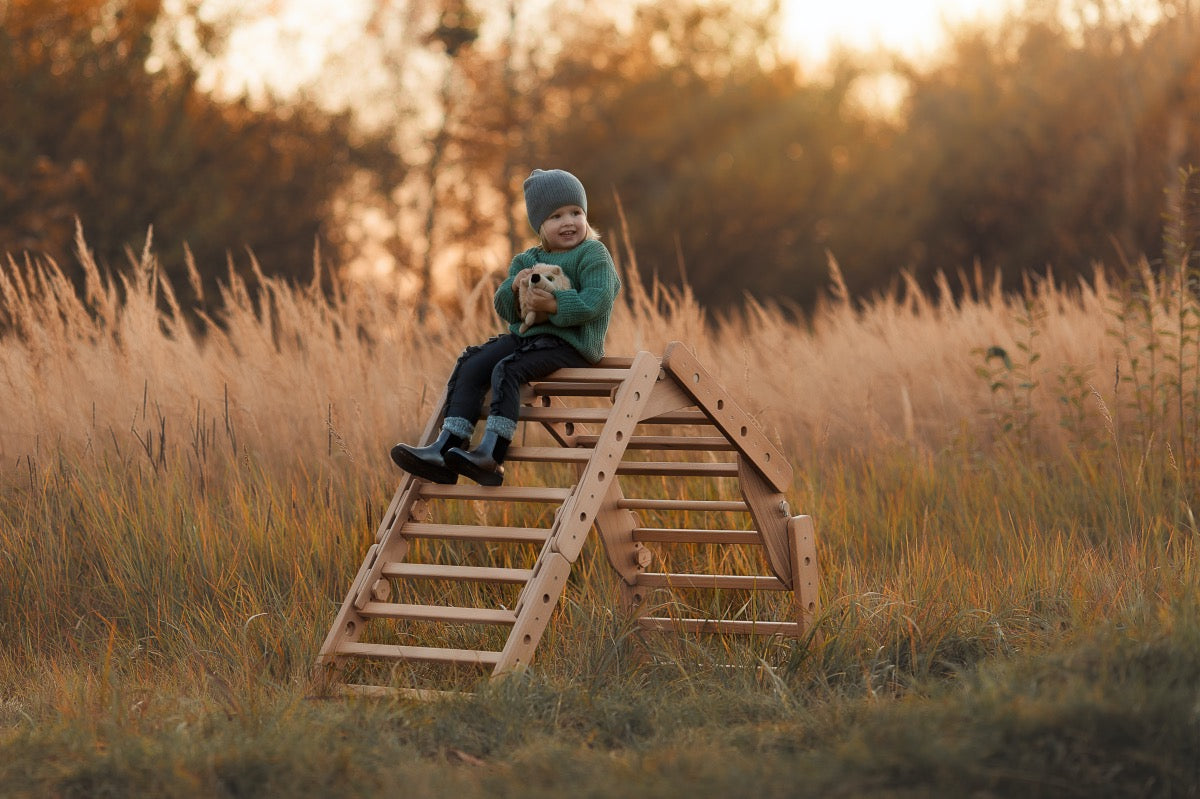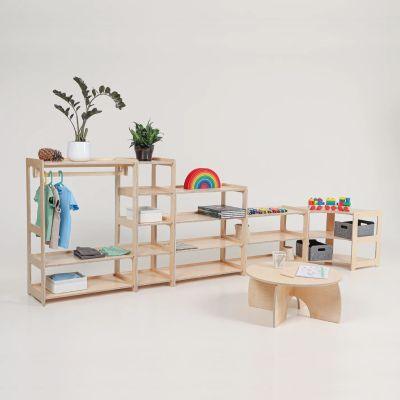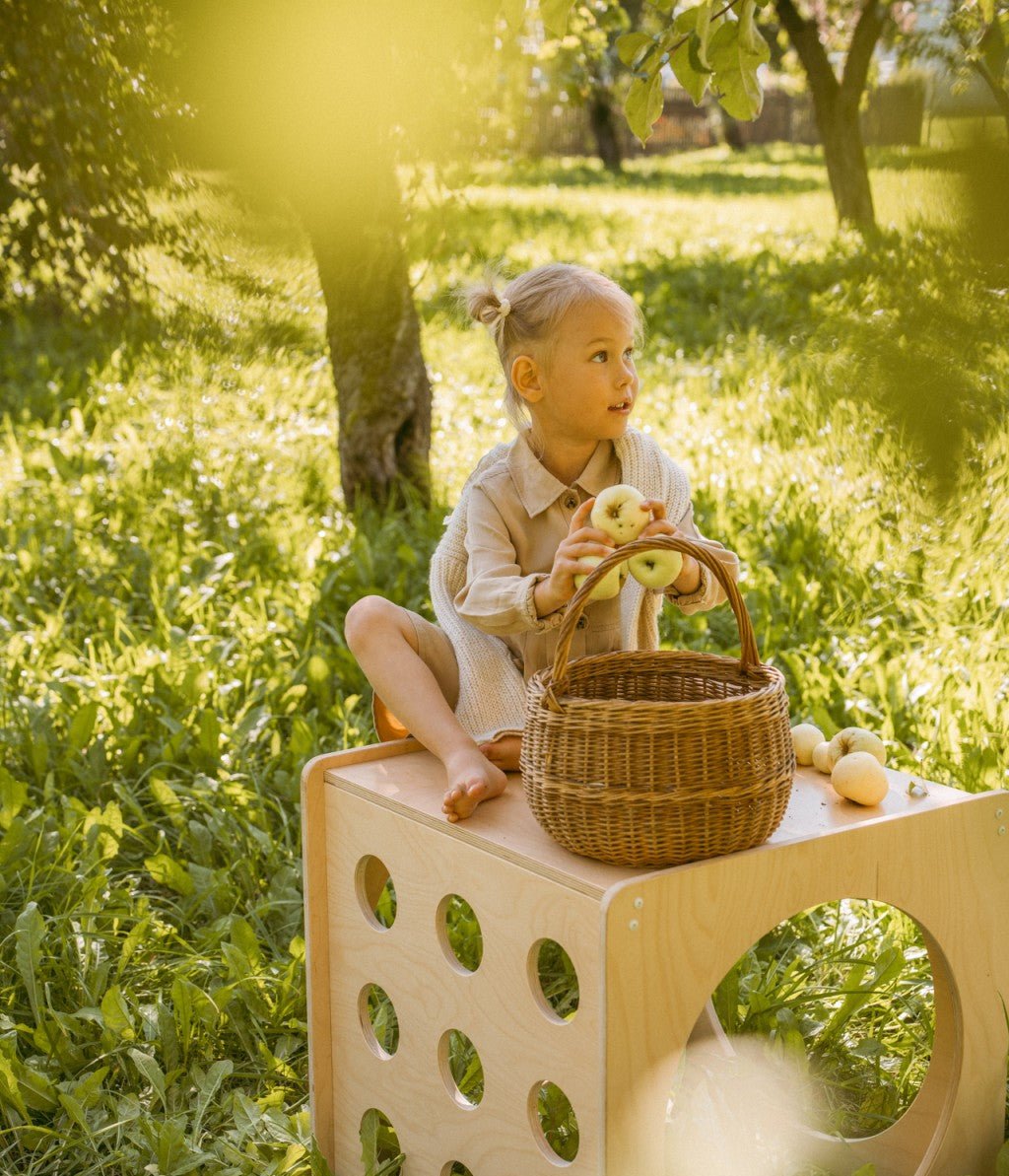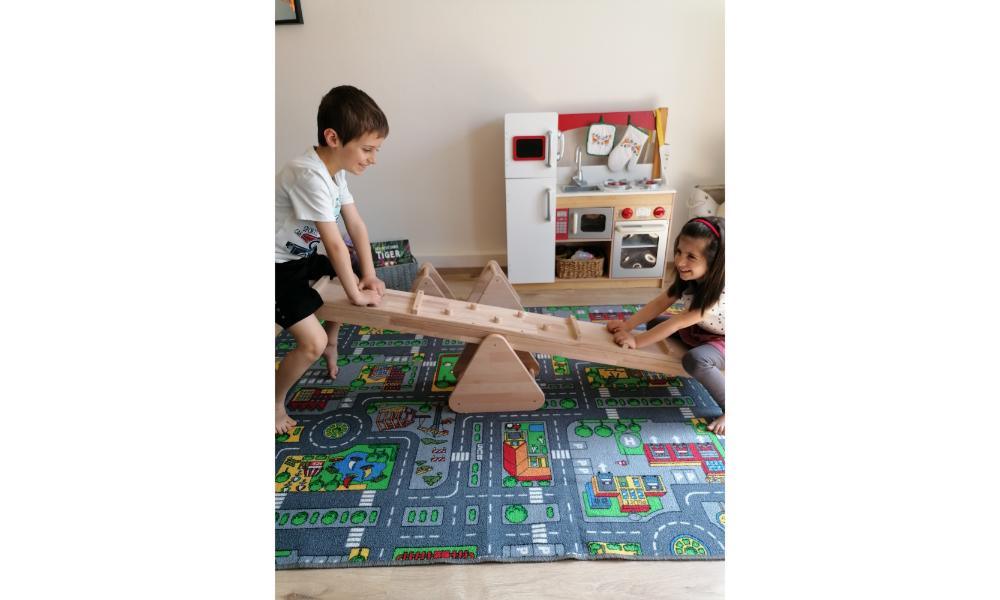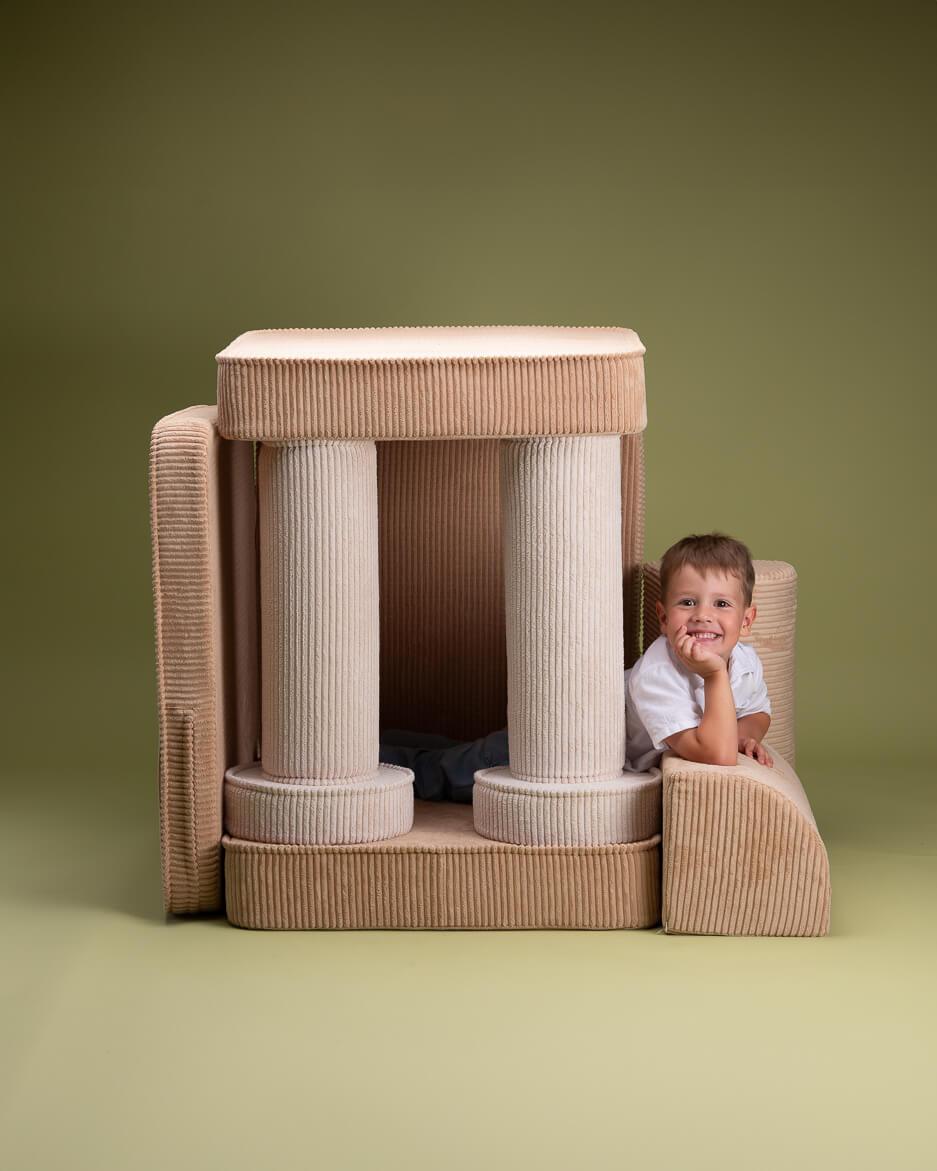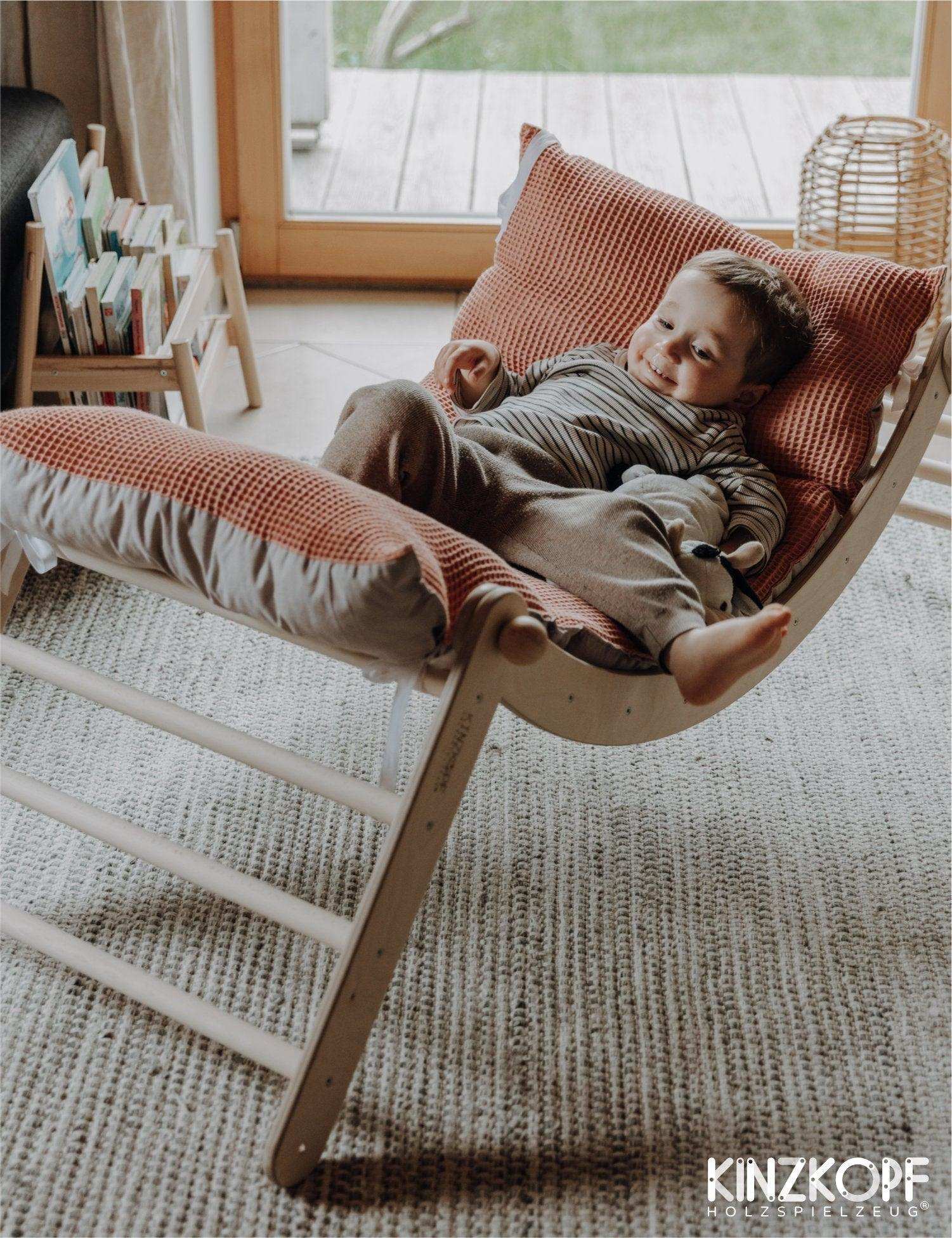Sort by:
30 products
30 products
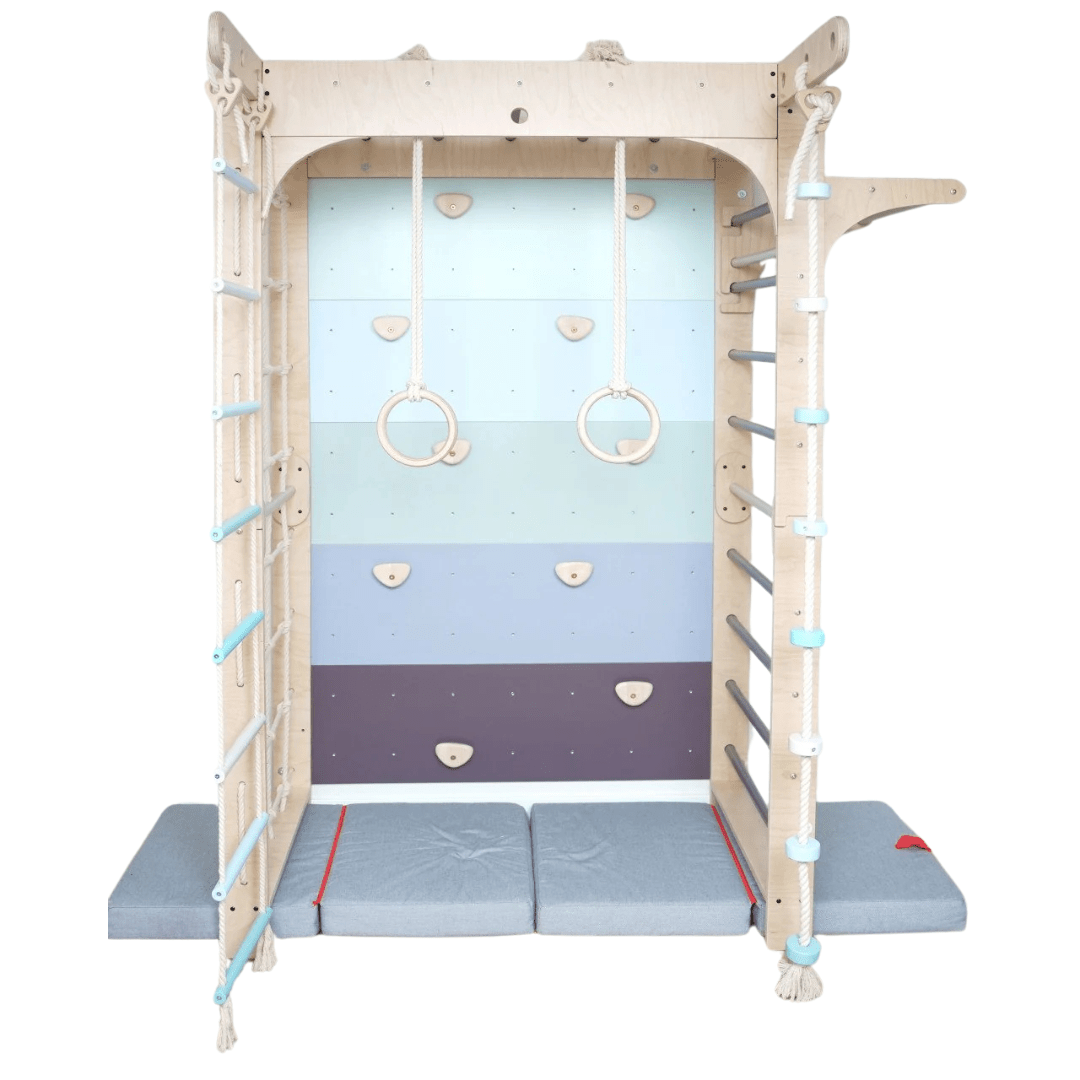

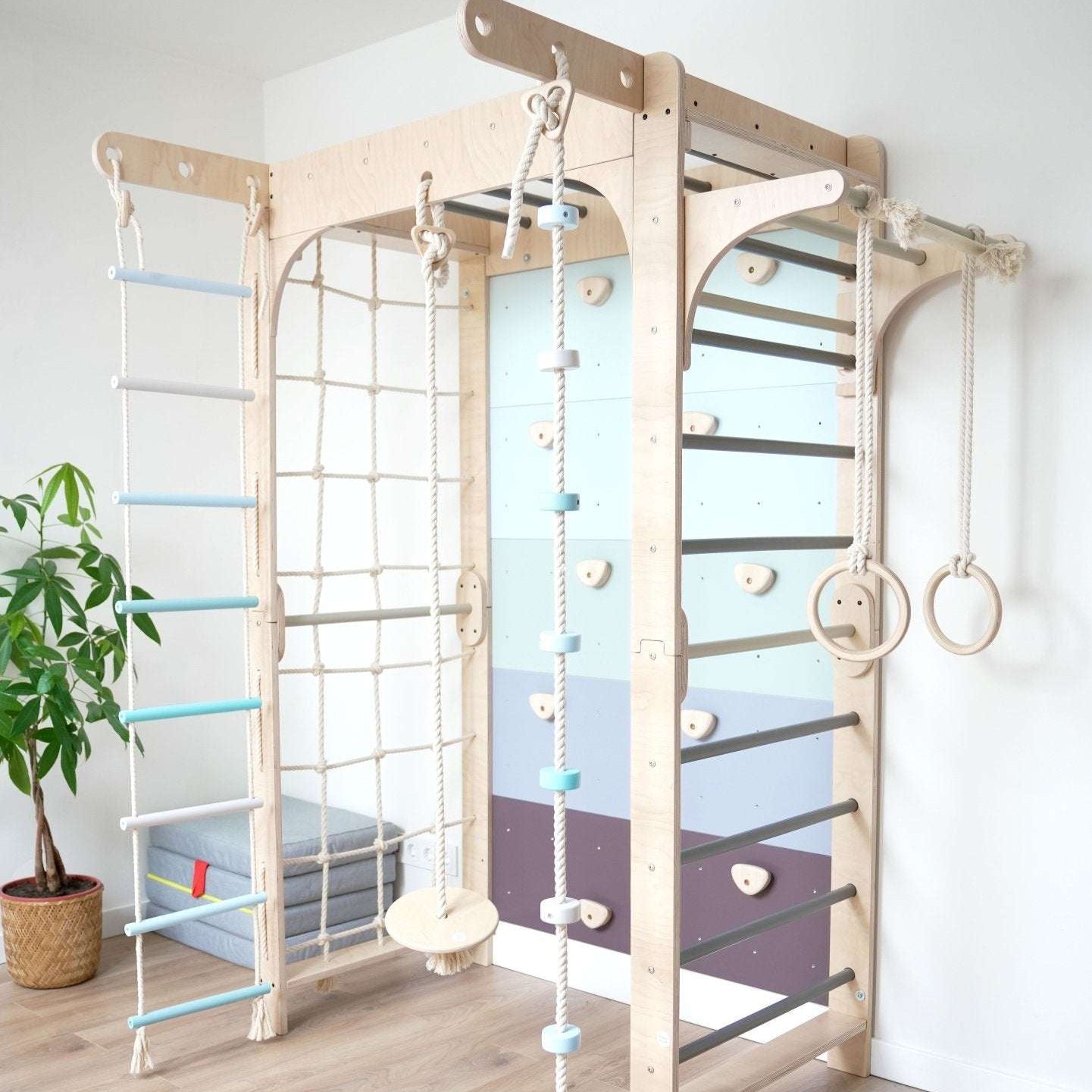
Sprossenwand WOLKENSTIEG BLAU | 50 kg | 204 x 127 cm | multifunktional
From €480,00
Unit price perSprossenwand WOLKENSTIEG BLAU | 50 kg | 204 x 127 cm | multifunktional
From €480,00
Unit price perIndoor-Klettergerüst WOLKENSTIEG – modular, stabil und liebevoll durchdacht für Kinder ab 6 Jahre
Entworfen von einem Vater für seinen Sohn – die Sprossenwand WOLKENSTIEG vereint durchdachtes Design, handwerkliche Qualität und echtes Abenteuerfeeling. Eine Sprossenwand, die bleibt – und mit deinem Kind wächst.
Technische Daten:
• Maße: 204 × 127 × 72 cm
• Breite oben (inkl. Griffstangen): 115 cm
• Maximale Belastung: 50 kg
• Altersempfehlung: ab 6 Jahren
• Materialien: Birken-Multiplex, Baumwollseile
• Oberfläche: Wasserbasierte, kindersichere Lacke
• Herkunft: Handgefertigt in Lettland (EU)
• Pflege: Mit trockenem oder leicht feuchtem Tuch reinigen
• Nutzung: Nur für den Innenbereich geeignet
• 3 Farbdesigns erhältlich: BLAU, GRÜN, ZIMT - in der Kategorie SPROSSENWAND
Varianten zur Auswahl:
• WOLKENSTIEG 1 = Rahmen: Sprossenwand + Kletternetz + Monkey Bars
• WOLKENSTIEG 2 = Rahmen + Kletterwand: mit Bouldergriffen in Naturfarben
• WOLKENSTIEG 3 = Rahmen + Kletterwand + Klimmzugstange: inkl. Pull-Up-Modul
• WOLKENSTIEG 4 = Komplett-Set: Rahmen + Kletterwand + Klimmzugstange inkl. Ringe, Seilleiter, Kletterseil, Tellerschaukel, Klimmzugdreieck
Für Kinder, die hoch hinaus wollen
Kinder haben einen natürlichen Bewegungsdrang – und die Sprossenwand WOLKENSTIEG bietet ihnen die perfekte Bühne dafür. Ob klettern, hangeln, schwingen oder schaukeln: Dieses multifunktionale Klettergerüst verwandelt jeden Innenraum in einen sicheren Spiel- und Trainingsort, der mit dem Kind mitwächst.
Alles, was ein Indoor-Spielplatz braucht
Die Sprossenwand für Kinder vereint gleich mehrere Geräte in einem: Sprossenwand, Kletternetz, Hangelleiste (Monkey Bars) und je nach Variante eine bunte Kletterwand mit Griffen, eine höhenverstellbare Klimmzugstange oder verschiedenes Zubehör wie Schaukel, Seil, Seilleiter und Ringe - in bester Qualität mit Baumwollseilen.
Die farbige Kletterwand zeigt sich in einem ruhigen, natürlichen Verlauf – mit harmonischen Tönen, die sich stilvoll in moderne Kinderzimmer einfügen. Farbvarianten: BLAU, GRÜN, ZIMT
Sicher, stabil und langlebig
Gefertigt aus stabilem Birken-Multiplex und robusten Baumwollseilen, ist die Sprossenwand belastbar bis 50 kg. Alle Oberflächen sind splitterfrei geschliffen und mit wasserbasierten, kindersicheren Lacken behandelt. Durch die modulare Bauweise kann das Set jederzeit erweitert oder an veränderte Bedürfnisse angepasst werden.
Das steckt drin:
• Klettergerüst für Kinder ab 6 Jahren
• Wahlweise mit Kletterwand, Klimmzugdreieck und Zubehör
• Sprossenwand, Kletternetz & Monkey Bars
• Naturfarbenes Design mit weichem Verlauf
• Belastbar bis 50 kg
• Indoor-Nutzung, handgefertigt in der EU (Lettland)
Bitte beachte: Unter Aufsicht! Für den Innenbereich vorgesehen. Holz vor direkter Sonneneinstrahlung und Feuchtigkeit schützen. Keine aggressiven Reinigungsmittel verwenden.
Fazit
Die multifunktionale Sprossenwand WOLKENSTIEG ist mehr als ein Klettergerüst – sie ist ein mitwachsender Bewegungsraum für Kinder, die neugierig, aktiv und voller Energie sind. Ein langlebiges Spielgerät, das nicht nur die Motorik fördert, sondern auch Selbstvertrauen schenkt – Schritt für Schritt, Griff für Griff.
Technische Details:
| Merkmal | Beschreibung |
|---|---|
| Produktart | Multifunktionales Indoor-Klettergerüst |
| Altersempfehlung | Ab 6 Jahren |
| Maximale Belastung | 50 kg |
| Maße (H × B × T) | 204 × 127 × 72 cm |
| Breite oben (inkl. Griffstangen) | 115 cm |
| Varianten | Rahmen / + Kletterwand / + Klimmzugstange / Komplett-Set |
| Material | Birken-Multiplex & Baumwollseile |
| Oberfläche | Wasserbasierte, ungiftige Lacke |
| Pflegehinweis | Mit trockenem oder leicht feuchtem Tuch reinigen |
| Empfohlene Nutzung | Nur für den Innenbereich |
| Besondere Merkmale | Kletternetz, Sprossenwand, Monkey Bars, Kletterwand (optional) |
| Zubehör (im Full Set) | Kletterseil, Seilleiter, Ringe, Tellerschaukel, Klimmzugdreieck |
| Herkunft | Handgefertigt in Lettland (EU) |
The wall bars for home training are a multifunctional piece of exercise equipment ideal for training at home. They allow for a variety of exercises to improve strength, flexibility, and coordination.
Main features:
Height : 230 cm
Width : 58 cm
Maximum load : 100 kg
Materials : plywood, beech stick
Equipment:
Gymnastic rings : Allow exercises to strengthen the arm and shoulder muscles.
Rope ladder : Promotes the development of coordination and dexterity.
Advantages of using:
Versatility : The wall bars are suitable for all ages and fitness levels. They allow for stretching exercises, strength training, and cardio training.
Compactness : Thanks to its size, the wall can be easily installed in any room without taking up much space.
-
Safety : The use of natural materials such as plywood and beechwood ensures the stability and durability of the structure. The maximum load of 100 kg guarantees your safety while performing the exercises.
Supports all muscle groups: The wall bars can be used to train all major muscle groups, including back, stomach, arms and legs.
Equipment : Additional elements such as gymnastic rings and rope ladders make training more varied and interesting.
Training options:
Stretching and flexibility training: Stretching exercises help improve the flexibility and mobility of the joints.
Strength training : The use of gymnastic rings and rope ladders allows for exercises to increase strength and endurance.
-
Cardio training: Intense workouts on the Swedish wall promote cardiovascular health and calorie burning.
Conclusion:
The wall bars for home workouts are an excellent choice for those who want to maintain their physical fitness at home. Combining functionality, safety, and compactness, they are an essential element of any home gym. Regardless of age and fitness level, everyone will find the right exercises on this versatile piece of equipment.
The wall bars come with reliable wall fasteners. Mounting is done using six attachment points , ensuring maximum stability and safety of the structure. The fasteners are made of high-quality materials and are suitable for most wall types. Easy installation ensures durability and reliability.
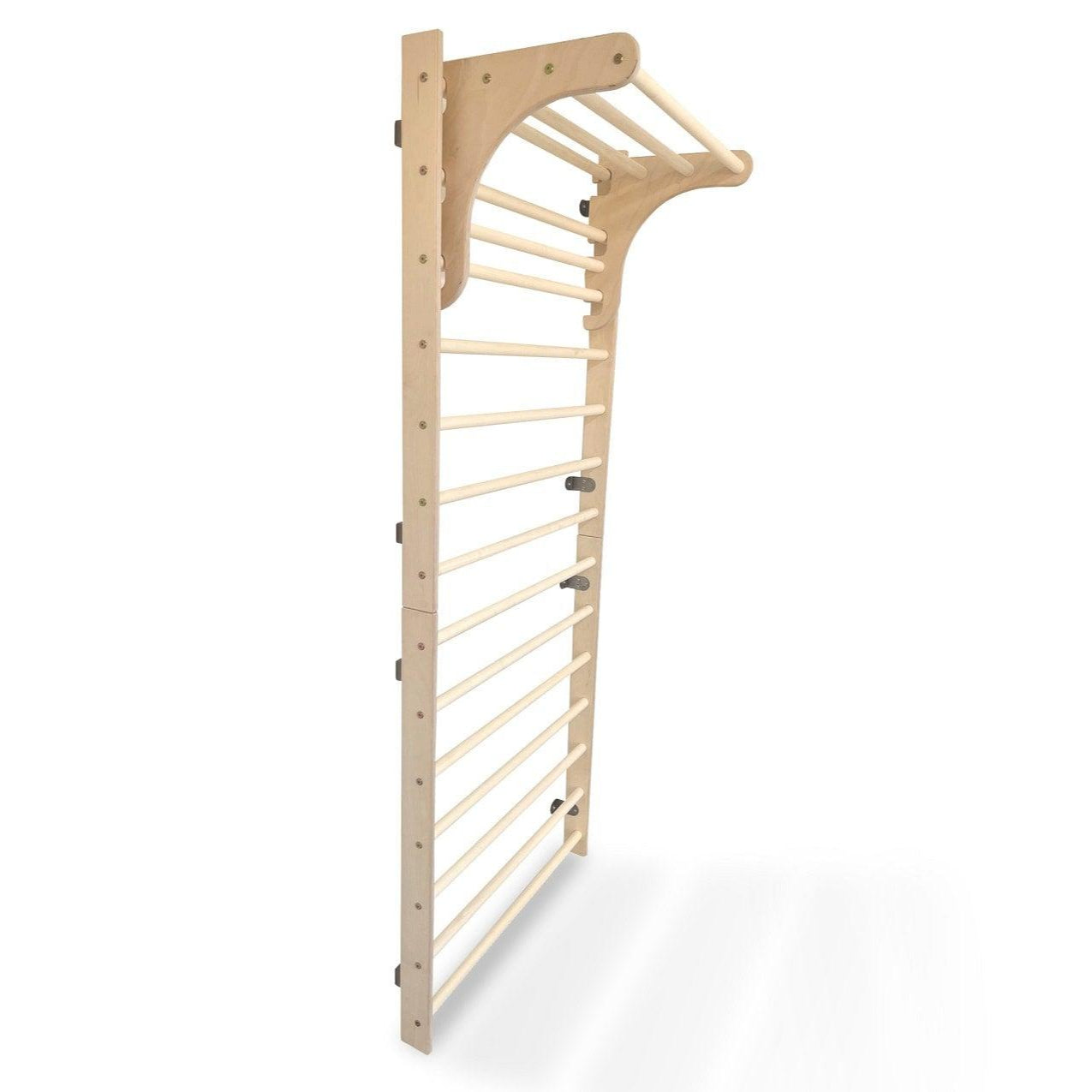

Giraffenling - Wall bars 100 or 200cm high with adjustable pull-up insert
Giraffenling - Wall bars 100 or 200cm high with adjustable pull-up insert
GiraffelingYouasked for it, we have created the Giraffeling. The Giraffenling wall bars for the children's room come in 2 parts and are easy to install. The height can be adjusted and adapted to your little climber with an attachable climbing section. As the wall bars consist of 2 100cm high parts, each of which is attached to the wall with the brackets supplied, the Giraffenling can also be installed just 100cm high at first and extended later. All corners and edges are sanded smooth and rounded so that your child can play safely. Inventory is not included!
Dimensions: total height 200 cm, depth 8 cm, width 82 cm. The wall bars consist of 2 individual parts, each approx. 100 cm high. You can therefore attach the wall bars to the wall at a height of just 100 cm. The pull-up and climbing insert is simply hooked into one of the round bars.
What materials is our "Giraffenling" wall bars made from? The side parts are made of 18 mm thick Baltic birch plywood The round bars are made of 28 mm diameter aspen wood.
Suitable for children from 1.5 years up to teenage age under supervision. Always remember that your child still needs to develop their motor skills. The wall bars are attached vertically to the wall, so your child's motor skills should already be advanced.
Educational benefits: You'll have lots of fun with the climbing frames! And they also encourage creativity. Over time, children will enjoy remodelling and expanding the doll's house with the items you have purchased or creating something completely new, which encourages creativity and free play. Our climbing frames can be used to fulfil the "need for independence, which is an essential feature of child development" (Emmi Pikler and Elfriede Hengstenberg).
Our tip: please do not place, sit or hang your child on the climbing frames as this increases the risk of injury. The climbing frames only fulfil their purpose when your child tries out the climbing triangle, for example, on their own. Gradually, they will first try pulling up, then standing on it and only later climbing. Your baby will learn to climb up from the safety of the ground all by itself and thus gain its own sense of security. Your child will learn to use the new toy and recognise their own limits. You will be amazed at how brave and confident your child can be. Show your baby the new device and be curious and above all patient about what happens and when. Every child has their own pace. Never leave your child unattended and be there to help!
Delivery and assembly: You will receive your wall bars in individual parts for self-assembly including mounting brackets for the wall. You will only need the wall plugs and screws that are suitable for your wall. As we do not know your home and this is relevant to safety, we ask you to seek advice from a DIY store.
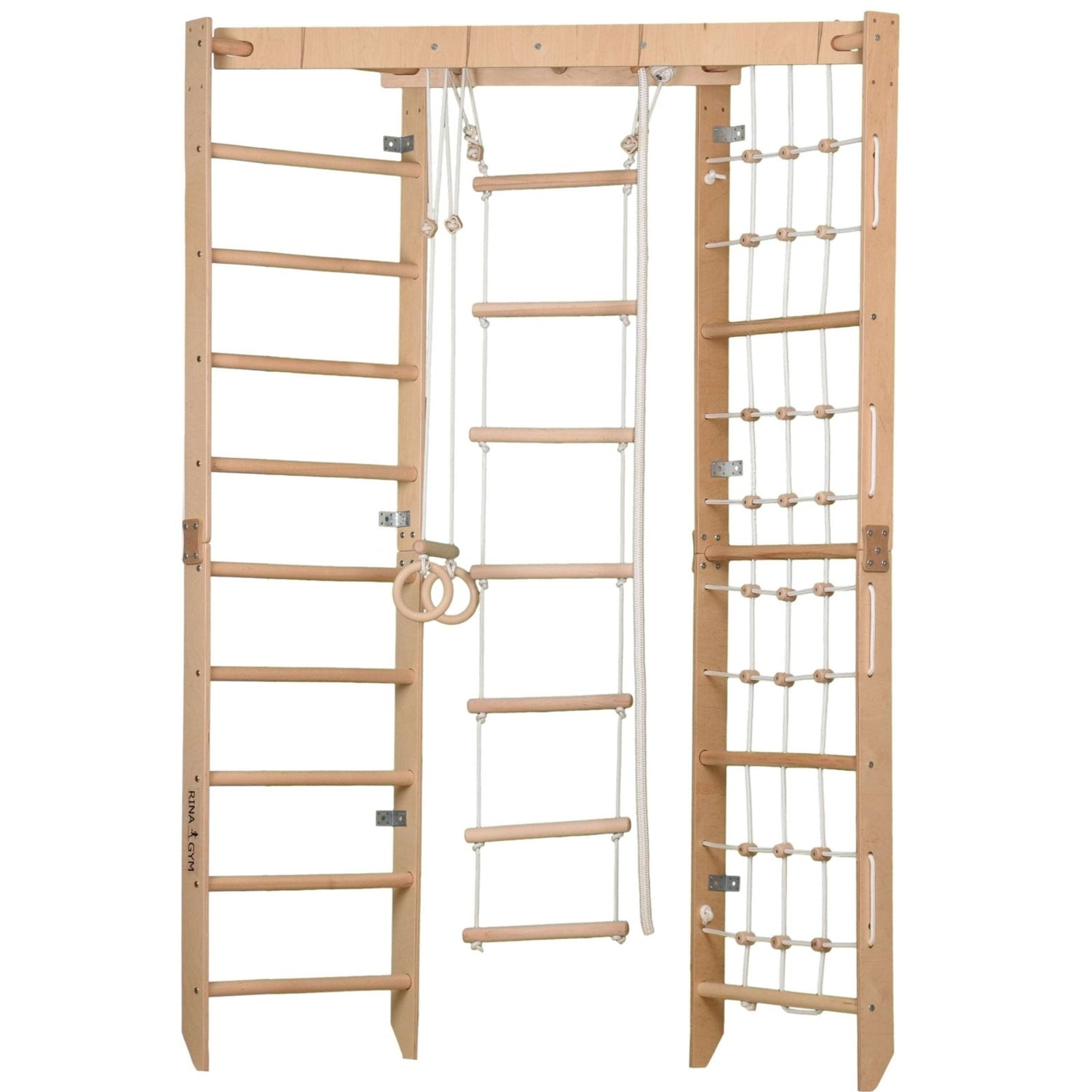

Children's wooden sports complex: The ultimate climbing adventure for your home
€399,00
Unit price perChildren's wooden sports complex: The ultimate climbing adventure for your home
€399,00
Unit price perChildren's wooden sports complex: The ultimate climbing adventure for your home
Promote the joy of movement, strengthen development
Our children's wooden sports complex is the perfect solution for active children who want to unleash their energy even at home. Featuring a combination of wall bars, climbing net, gymnastic rings, and rope ladder, this multifunctional sports complex offers everything your child needs for healthy physical development.
Versatile equipment for unlimited movement
- Robust wall bars : Trains arm, leg, back and abdominal muscles
- Challenging climbing net : Improves coordination and strengthens muscles
- Gymnastic rings : Ideal for shoulder and arm training
- Rope ladder : Promotes balance, dexterity and coordination
Technical details that convince
- Height: 230 cm
- Total width: 150 cm
- Section width: 60 cm each (wall bars and climbing net)
- Maximum load: 100 kg
- Secure mounting system: 12 wall mounting points for maximum stability
Benefits that inspire
- Suitable for all ages : For children of different ages and fitness levels
- Space-saving : Compact design for apartments and small rooms
- Safe & durable : Natural materials and reliable fastening
- Holistic training : Promotes all major muscle groups
- Playful learning : Makes movement fun
Training variety for young athletes
The sports complex offers numerous training options – from stretching exercises on the wall bars to strength training with the gymnastic rings to cardio exercises on the climbing net. Each element has been carefully designed to promote physical development in a playful way.
Easy installation, maximum safety
The included high-quality wall mounting brackets are suitable for most wall types and guarantee a secure, stable installation. With six mounting points per section, the sports complex stands securely and reliably.
leg&go climbing triangle (2in1 wall bars) with ramp: entertainment, play and learning combined
The leg&go wall climbing triangle with ramp is a multifunctional movement toy designed for children from 6 months to 5 years. With its unique wall-mounting function, it expands the play and learning opportunities for your child
Safety and quality come first
Every part of our versatile climbing triangle, the climbing wall and the ramp, are made from sustainably sourced and certified birch wood. This guarantees the highest quality and safety standards. So you don't have to worry about sharp corners or edges or even splinters. The robust construction can support a weight of up to 50 kg, which ensures safety during play
.
Promoting motor skills with the Pikler triangle method
The idea of the climbing triangle is based on the Pikler Triangle Method, which was developed by Dr Emmi Pikler. This method enables children to discover their physical limits and encourage them to enjoy climbing. This activity strengthens balance, increases dexterity and promotes muscle development. The result is strong bones and joints as well as the joy of movement that your child experiences while playing. Measuring 68 cm high, 87 cm long and 78 cm wide, the climbing triangle offers plenty of space for playing and climbing
.Varied play and learning opportunities with the ramp that can be used on both sides
The climbing ramp included in the set has two different sides and therefore offers a variety of play and learning opportunities. The board with a length of approx. 88 cm and a width of 37 cm can either be used as a smooth slide or as a climbing wall on the other side. Both activities promote your child's motor skills.
Further product information:
- Contents: 1x Pikler triangle, 1x climbing ramp, 1x wall attachment
- Material: Birch wood
- Colour: Colourful/natural _x000D_
- Dimensions: Triangle: 68 cm H x 87 cm L x 78 cm W, ramp: 88 x 37 cm
- Weight: Triangle: 7.2 kg; Ramp: 4 kg
- Age: over 3 years
Note: The wall bracket is included in the set. Simply attach the bracket to the wall and attach or detach the triangle as required
Delivery possible within 5-10 working days.
Climbing fun in bright colours with the leg&go climbing triangle , climbing wall (Swedish) 2in1, rainbow
Climbing, learning and having lots of fun - that is the motto of the leg&go climbing triangle in rainbow colours. The design of the versatile and multifunctional play equipment is tailored to the needs of children aged 6 months and over and offers a wealth of learning and entertainment opportunities.
Much more than just a climbing frame
A climbing triangle that grows, changes and grows with your child's abilities. Even babies can use the wooden poles to pull themselves up and make their first attempts at standing. The older your child gets, the more they can explore and climb. And because varied play is important, you can easily convert the climbing triangle into a Swedish ladder
.An investment in the future
The climbing triangle helps your child to develop important skills such as dexterity, enjoyment of movement, a sense of balance, motor skills and courage. At the same time, it promotes healthy joints and muscle development. All of this contributes to improving your child's posture and health
.Sustainable materials for long durability
The climbing triangle is made from sustainably sourced, FSC-certified birch plywood and therefore guarantees a long service life with a maximum load weight of 50 kg.
Withdimensions of 87 cm long, 68 cm high and 78 cm wide for the climbing triangle and 144 cm long, 78 cm wide and 12 cm high for the wall bars, it can be set up in almost any room.
Product details at a glance:
- Contents: 1x leg&go climbing triangle climbing wall 2in1
- Material: FSC-certified birch plywood, aspen wood poles
- Age: Suitable from 6 months
- Climbing triangle dimensions: Length 87cm x width 78cm x height 68cm
- Climbing wall dimensions: Length 144cm x width 78cm x height 12cm
- Maximum load weight: 50kg
Delivery possible within 5-10 working days
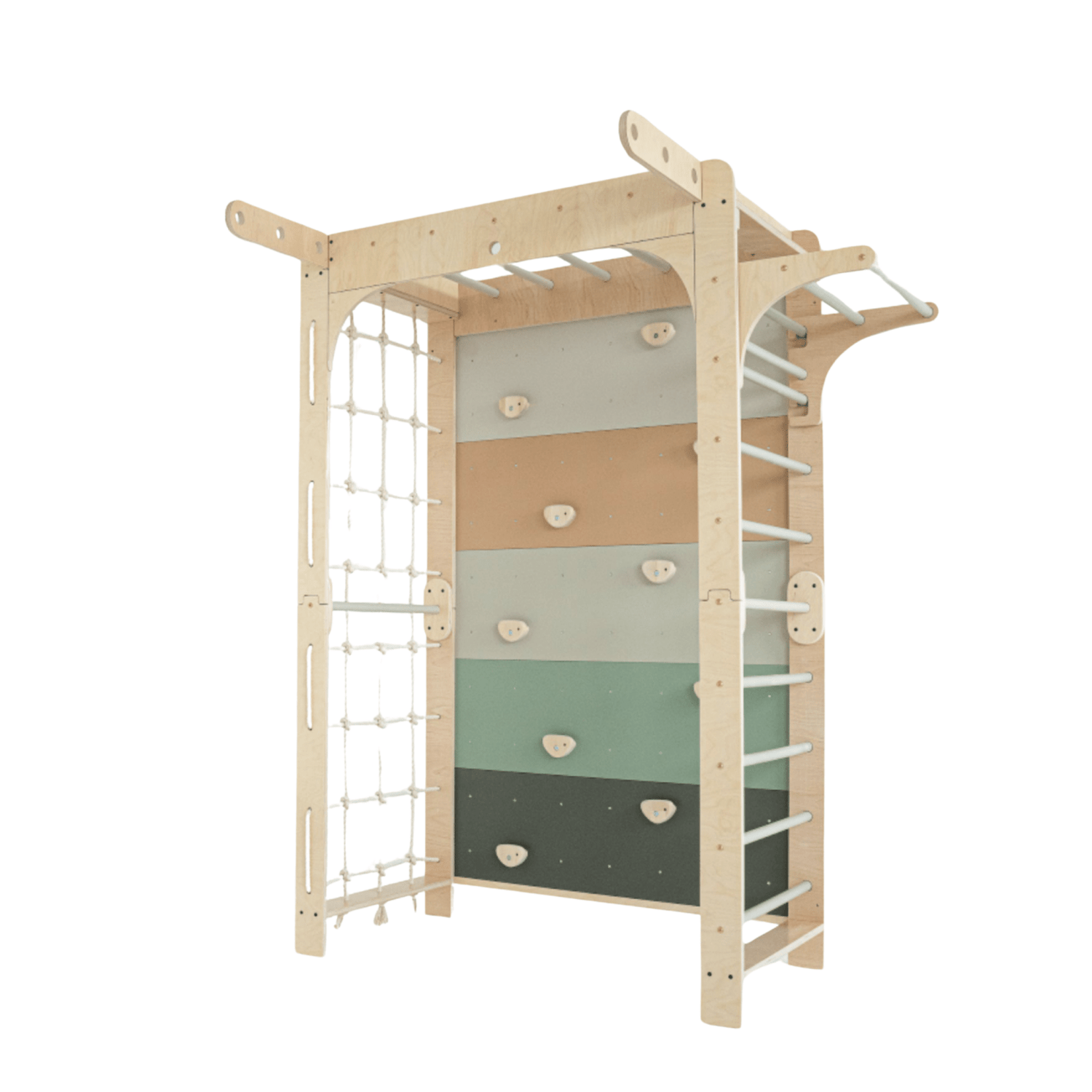
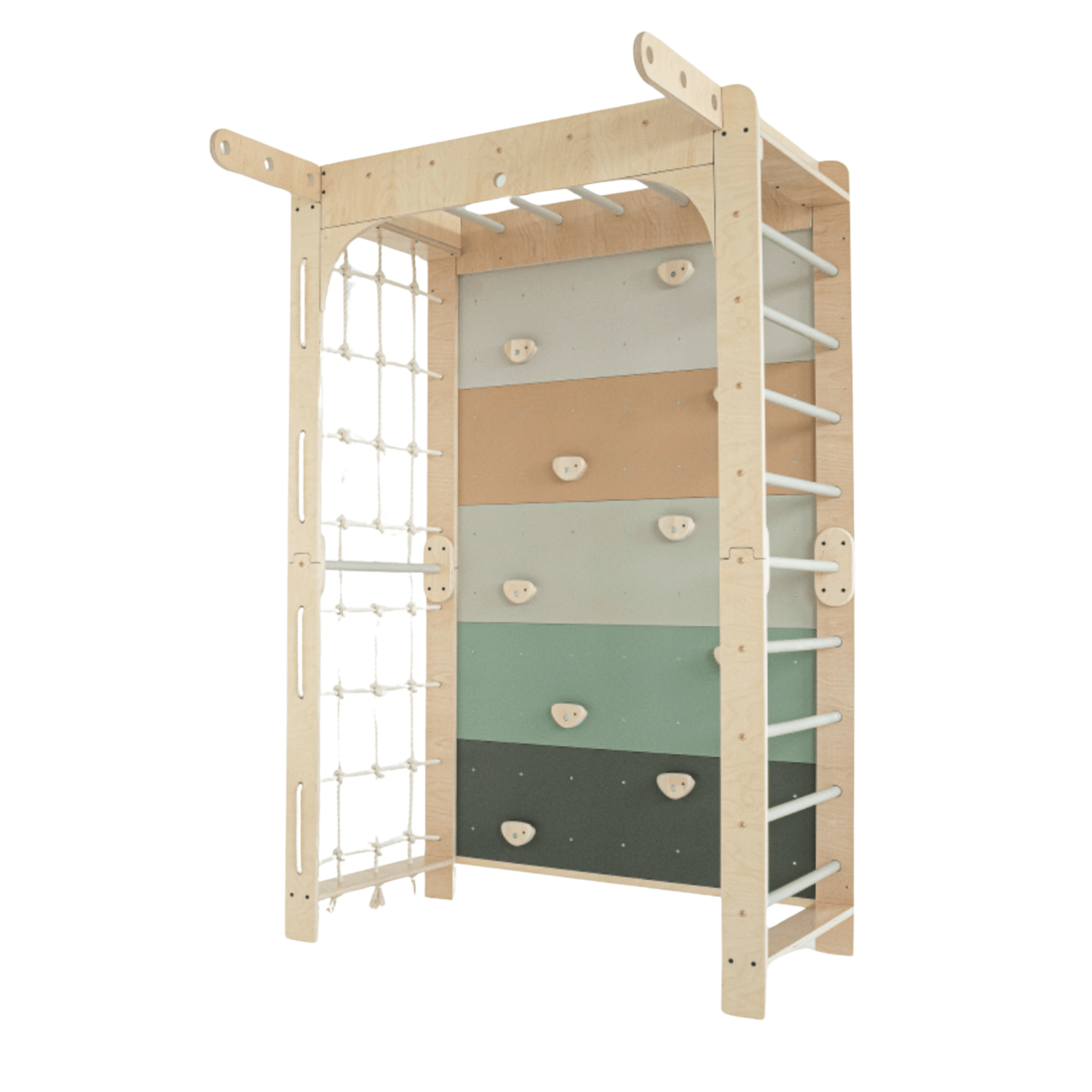
Sprossenwand WOLKENSTIEG ZIMT | 50 kg | 204 x 127 cm | multifunktional
From €480,00
Unit price perSprossenwand WOLKENSTIEG ZIMT | 50 kg | 204 x 127 cm | multifunktional
From €480,00
Unit price perIndoor-Klettergerüst WOLKENSTIEG – modular, stabil und liebevoll durchdacht für Kinder ab 6 Jahre
Entworfen von einem Vater für seinen Sohn – die Sprossenwand WOLKENSTIEG vereint durchdachtes Design, handwerkliche Qualität und echtes Abenteuerfeeling. Eine Sprossenwand, die bleibt – und mit deinem Kind wächst.
Technische Daten:
• Maße: 204 × 127 × 72 cm
• Breite oben (inkl. Griffstangen): 115 cm
• Maximale Belastung: 50 kg
• Altersempfehlung: ab 6 Jahren
• Materialien: Birken-Multiplex, Baumwollseile
• Oberfläche: Wasserbasierte, kindersichere Lacke
• Herkunft: Handgefertigt in Lettland (EU)
• Pflege: Mit trockenem oder leicht feuchtem Tuch reinigen
• Nutzung: Nur für den Innenbereich geeignet
• 3 Farbdesigns erhältlich: BLAU, GRÜN, ZIMT - in der Kategorie SPROSSENWAND
Varianten zur Auswahl:
• WOLKENSTIEG 1 = Rahmen: Sprossenwand + Kletternetz + Monkey Bars
• WOLKENSTIEG 2 = Rahmen + Kletterwand: mit Bouldergriffen in Naturfarben
• WOLKENSTIEG 3 = Rahmen + Kletterwand + Klimmzugstange: inkl. Pull-Up-Modul
• WOLKENSTIEG 4 = Komplett-Set: Rahmen + Kletterwand + Klimmzugstange inkl. Ringe, Seilleiter, Kletterseil, Tellerschaukel, Klimmzugdreieck
Für Kinder, die hoch hinaus wollen
Kinder haben einen natürlichen Bewegungsdrang – und die Sprossenwand WOLKENSTIEG bietet ihnen die perfekte Bühne dafür. Ob klettern, hangeln, schwingen oder schaukeln: Dieses multifunktionale Klettergerüst verwandelt jeden Innenraum in einen sicheren Spiel- und Trainingsort, der mit dem Kind mitwächst.
Alles, was ein Indoor-Spielplatz braucht
Die Sprossenwand für Kinder vereint gleich mehrere Geräte in einem: Sprossenwand, Kletternetz, Hangelleiste (Monkey Bars) und je nach Variante eine bunte Kletterwand mit Griffen, eine höhenverstellbare Klimmzugstange oder verschiedenes Zubehör wie Schaukel, Seil, Seilleiter und Ringe - in bester Qualität mit Baumwollseilen.
Die farbige Kletterwand zeigt sich in einem ruhigen, natürlichen Verlauf – mit harmonischen Tönen, die sich stilvoll in moderne Kinderzimmer einfügen. Farbvarianten: BLAU, GRÜN, ZIMT
Sicher, stabil und langlebig
Gefertigt aus stabilem Birken-Multiplex und robusten Baumwollseilen, ist die Sprossenwand belastbar bis 50 kg. Alle Oberflächen sind splitterfrei geschliffen und mit wasserbasierten, kindersicheren Lacken behandelt. Durch die modulare Bauweise kann das Set jederzeit erweitert oder an veränderte Bedürfnisse angepasst werden.
Das steckt drin:
• Klettergerüst für Kinder ab 6 Jahren
• Wahlweise mit Kletterwand, Klimmzugdreieck und Zubehör
• Sprossenwand, Kletternetz & Monkey Bars
• Naturfarbenes Design mit weichem Verlauf
• Belastbar bis 50 kg
• Indoor-Nutzung, handgefertigt in der EU (Lettland)
Bitte beachte: Unter Aufsicht! Für den Innenbereich vorgesehen. Holz vor direkter Sonneneinstrahlung und Feuchtigkeit schützen. Keine aggressiven Reinigungsmittel verwenden.
Fazit
Die multifunktionale Sprossenwand WOLKENSTIEG ist mehr als ein Klettergerüst – sie ist ein mitwachsender Bewegungsraum für Kinder, die neugierig, aktiv und voller Energie sind. Ein langlebiges Spielgerät, das nicht nur die Motorik fördert, sondern auch Selbstvertrauen schenkt – Schritt für Schritt, Griff für Griff.
Technische Details:
| Merkmal | Beschreibung |
|---|---|
| Produktart | Multifunktionales Indoor-Klettergerüst |
| Altersempfehlung | Ab 6 Jahren |
| Maximale Belastung | 50 kg |
| Maße (H × B × T) | 204 × 127 × 72 cm |
| Breite oben (inkl. Griffstangen) | 115 cm |
| Varianten | Rahmen / + Kletterwand / + Klimmzugstange / Komplett-Set |
| Material | Birken-Multiplex & Baumwollseile |
| Oberfläche | Wasserbasierte, ungiftige Lacke |
| Pflegehinweis | Mit trockenem oder leicht feuchtem Tuch reinigen |
| Empfohlene Nutzung | Nur für den Innenbereich |
| Besondere Merkmale | Kletternetz, Sprossenwand, Monkey Bars, Kletterwand (optional) |
| Zubehör (im Full Set) | Kletterseil, Seilleiter, Ringe, Tellerschaukel, Klimmzugdreieck |
| Herkunft | Handgefertigt in Lettland (EU) |

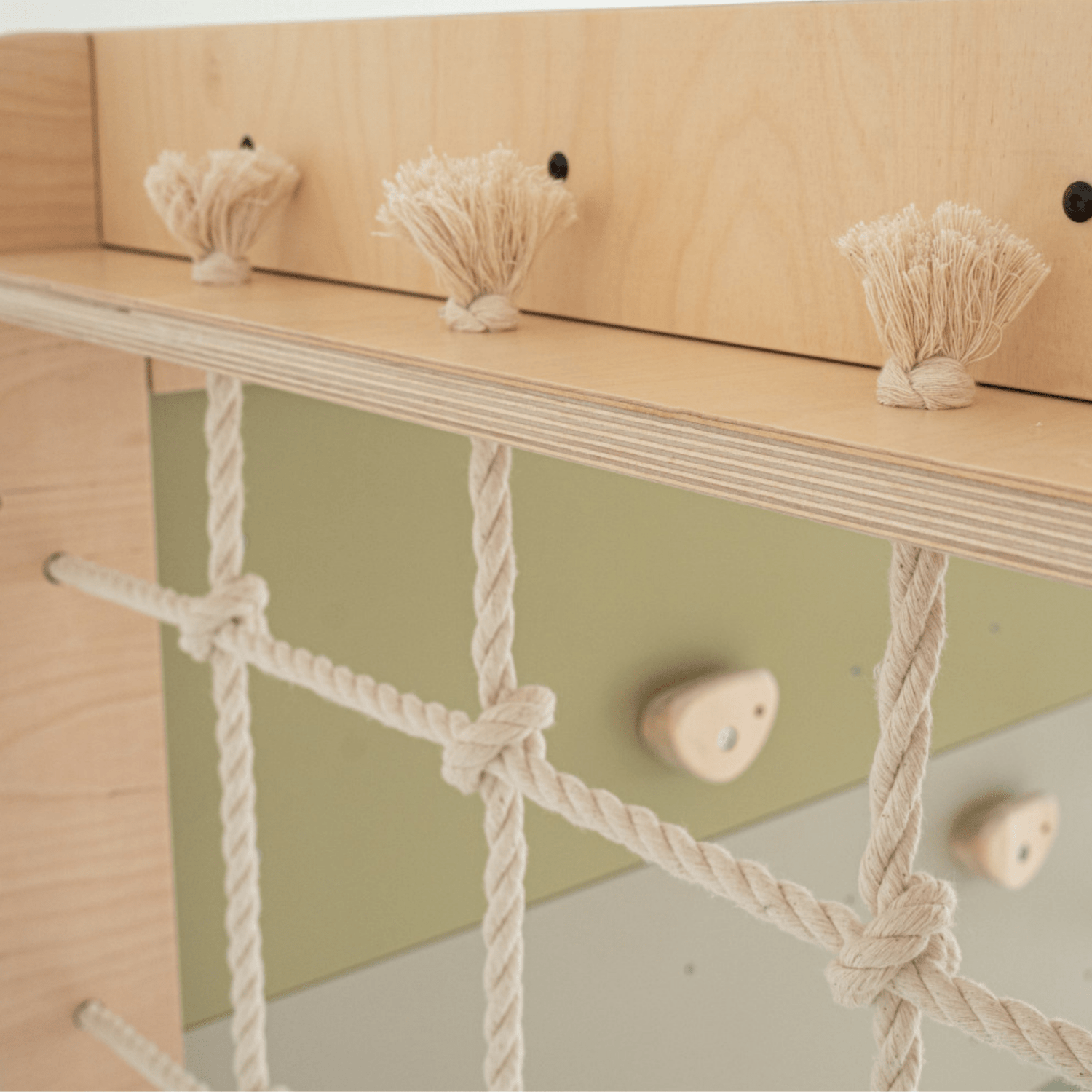
Sprossenwand WOLKENSTIEG GRÜN | 50 kg | 204 x 127 cm | multifunktional
From €480,00
Unit price perSprossenwand WOLKENSTIEG GRÜN | 50 kg | 204 x 127 cm | multifunktional
From €480,00
Unit price perIndoor-Klettergerüst WOLKENSTIEG – modular, stabil und liebevoll durchdacht für Kinder ab 6 Jahren
Entworfen von einem Vater für seinen Sohn – die Sprossenwand WOLKENSTIEG vereint durchdachtes Design, handwerkliche Qualität und echtes Abenteuerfeeling. Eine Sprossenwand, die bleibt – und mit deinem Kind wächst.
Technische Daten:
• Maße: 204 × 127 × 72 cm
• Breite oben (inkl. Griffstangen): 115 cm
• Maximale Belastung: 50 kg
• Altersempfehlung: ab 6 Jahren
• Materialien: Birken-Multiplex, Baumwollseile
• Oberfläche: Wasserbasierte, kindersichere Lacke
• Herkunft: Handgefertigt in Lettland (EU)
• Pflege: Mit trockenem oder leicht feuchtem Tuch reinigen
• Nutzung: Nur für den Innenbereich geeignet
• 3 Farbdesigns erhältlich: BLAU, GRÜN, ZIMT - in der Kategorie SPROSSENWAND
Varianten zur Auswahl:
• WOLKENSTIEG 1 = Rahmen: Sprossenwand + Kletternetz + Monkey Bars
• WOLKENSTIEG 2 = Rahmen + Kletterwand: mit Bouldergriffen in Naturfarben
• WOLKENSTIEG 3 = Rahmen + Kletterwand + Klimmzugstange: inkl. Pull-Up-Modul
• WOLKENSTIEG 4 = Komplett-Set: Rahmen + Kletterwand + Klimmzugstange inkl. Ringe, Seilleiter, Kletterseil, Tellerschaukel, Klimmzugdreieck
Für Kinder, die hoch hinaus wollen
Kinder haben einen natürlichen Bewegungsdrang – und die Sprossenwand WOLKENSTIEG bietet ihnen die perfekte Bühne dafür. Ob klettern, hangeln, schwingen oder schaukeln: Dieses multifunktionale Klettergerüst verwandelt jeden Innenraum in einen sicheren Spiel- und Trainingsort, der mit dem Kind mitwächst.
Alles, was ein Indoor-Spielplatz braucht
Die Sprossenwand für Kinder vereint gleich mehrere Geräte in einem: Sprossenwand, Kletternetz, Hangelleiste (Monkey Bars) und je nach Variante eine bunte Kletterwand mit Griffen, eine höhenverstellbare Klimmzugstange oder verschiedenes Zubehör wie Schaukel, Seil, Seilleiter und Ringe - in bester Qualität mit Baumwollseilen.
Die farbige Kletterwand zeigt sich in einem ruhigen, natürlichen Verlauf – mit harmonischen Tönen, die sich stilvoll in moderne Kinderzimmer einfügen. Farbvarianten: BLAU, GRÜN, ZIMT
Sicher, stabil und langlebig
Gefertigt aus stabilem Birken-Multiplex und robusten Baumwollseilen, ist die Sprossenwand belastbar bis 50 kg. Alle Oberflächen sind splitterfrei geschliffen und mit wasserbasierten, kindersicheren Lacken behandelt. Durch die modulare Bauweise kann das Set jederzeit erweitert oder an veränderte Bedürfnisse angepasst werden.
Das steckt drin:
• Klettergerüst für Kinder ab 6 Jahren
• Wahlweise mit Kletterwand, Klimmzugdreieck und Zubehör
• Sprossenwand, Kletternetz & Monkey Bars
• Naturfarbenes Design mit weichem Verlauf
• Belastbar bis 50 kg
• Indoor-Nutzung, handgefertigt in der EU (Lettland)
Bitte beachte: Unter Aufsicht! Für den Innenbereich vorgesehen. Holz vor direkter Sonneneinstrahlung und Feuchtigkeit schützen. Keine aggressiven Reinigungsmittel verwenden.
Fazit
Die multifunktionale Sprossenwand WOLKENSTIEG ist mehr als ein Klettergerüst – sie ist ein mitwachsender Bewegungsraum für Kinder, die neugierig, aktiv und voller Energie sind. Ein langlebiges Spielgerät, das nicht nur die Motorik fördert, sondern auch Selbstvertrauen schenkt – Schritt für Schritt, Griff für Griff.
Technische Details:
| Merkmal | Beschreibung |
|---|---|
| Produktart | Multifunktionales Indoor-Klettergerüst |
| Altersempfehlung | Ab 6 Jahren |
| Maximale Belastung | 50 kg |
| Maße (H × B × T) | 204 × 127 × 72 cm |
| Breite oben (inkl. Griffstangen) | 115 cm |
| Varianten | Rahmen / + Kletterwand / + Klimmzugstange / Komplett-Set |
| Material | Birken-Multiplex & Baumwollseile |
| Oberfläche | Wasserbasierte, ungiftige Lacke |
| Pflegehinweis | Mit trockenem oder leicht feuchtem Tuch reinigen |
| Empfohlene Nutzung | Nur für den Innenbereich |
| Besondere Merkmale | Kletternetz, Sprossenwand, Monkey Bars, Kletterwand (optional) |
| Zubehör (im Full Set) | Kletterseil, Seilleiter, Ringe, Tellerschaukel, Klimmzugdreieck |
| Herkunft | Handgefertigt in Lettland (EU) |
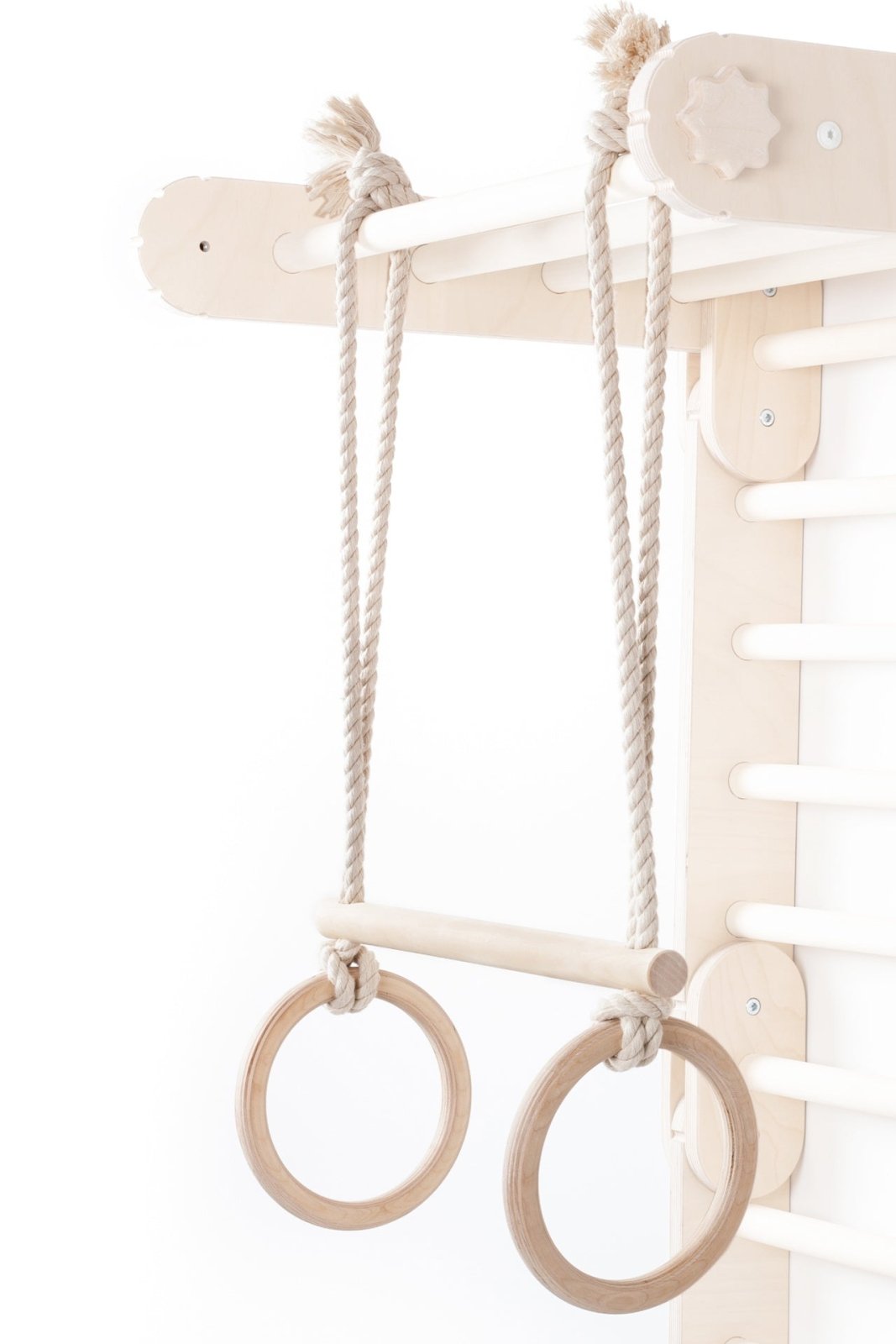

Turninge & Trapez MOON GYM | 2 in 1 | max. 50 kg | für Sprossenwand & Co
€64,00
Unit price perTurninge & Trapez MOON GYM | 2 in 1 | max. 50 kg | für Sprossenwand & Co
€64,00
Unit price perMOON GYM Turnringe & Trapezstange – Erweiterung für Eure Sprossenwand
Die Turnringe und die Trapezstange bringen neue Bewegung und Trainingsmöglichkeiten in Eurem Indoor-Spielsystem. Perfekt für Kinder ab 3 Jahren, um Kraft, Balance und Körperkontrolle spielerisch zu entwickeln.
Technische Daten:
• Produktgewicht: 1 kg
• Paketmaße: 49 × 24 × 6 cm
• Farbe: Natur
• Altersempfehlung: ab 3 Jahren
• Material: Hochwertiges baltisches Birkensperrholz, geflochtene Baumwollseile
Lieferumfang:
• 2 × geflochtene Baumwollseile
• 2 × Turnringe
• 1 × Trapezstange
Vielseitige Nutzungsmöglichkeiten:
Ob Turnringe, Trapezstange oder beides zusammen – die Aufhängung an der MOON Klimmzugstange ist einfach und flexibel. Du kannst die Länge der Seile individuell anpassen und die Elemente schnell ein- oder aushängen.
Platzsparende Aufbewahrung:
Wenn du die MOON Wandhalterung für deine Sprossenwand nutzt, kannst du die Ringe dort gut verstauen, wenn sie gerade nicht gebraucht werden.
Fördert wichtige Fähigkeiten:
• Verbesserung von Gleichgewicht, Koordination und Beweglichkeit
• Stärkung der Muskulatur und Erwerb motorischer Fähigkeiten
• Förderung von Selbstvertrauen und kognitiver Entwicklung
• Sorgt für Ausgeglichenheit, guten Schlaf und beste Laune
Montagehinweis:
Die Gymnastikringe mit Trapezstange wird gebrauchsfertig geliefert. Die Montage und das sichere Anbringen an der Wandhalterung sollten ausschließlich durch Erwachsene erfolgen – Kinder dürfen aber gerne beim Anbringen helfen und das Ganze zu einem gemeinsamen Erlebnis machen.
Pflege & Verwendung:
• Für den Innenbereich geeignet, sollte nicht im Freien aufbewahrt werden
• Holz und Baumwolle vor Feuchtigkeit schützen
• Reinigung mit trockenem oder leicht feuchtem Tuch (keine aggressiven Reinigungsmittel verwenden)
Sicherheit:
Für ein sicheres Spielvergnügen empfehlen wir, dass Kinder jederzeit von einem Erwachsenen begleitet werden. Unsere Produkte sind sorgfältig getestet – dennoch bitten wir um Verständnis, dass wir keine Verantwortung für etwaige Unfälle übernehmen können.
Handgemachte Qualität – gefertigt in der EU:
Wie alle MOON Produkte werden auch Ringe und Trapezstange mit viel Liebe zum Detail in Lettland (EU) hergestellt. Hochwertige Materialien, sorgfältige Handwerkskunst und die Prinzipien von Montessori, Pikler und Waldorf stehen dabei im Mittelpunkt – für langlebige, sichere und fantasievolle Spielgeräte.
.
Videos

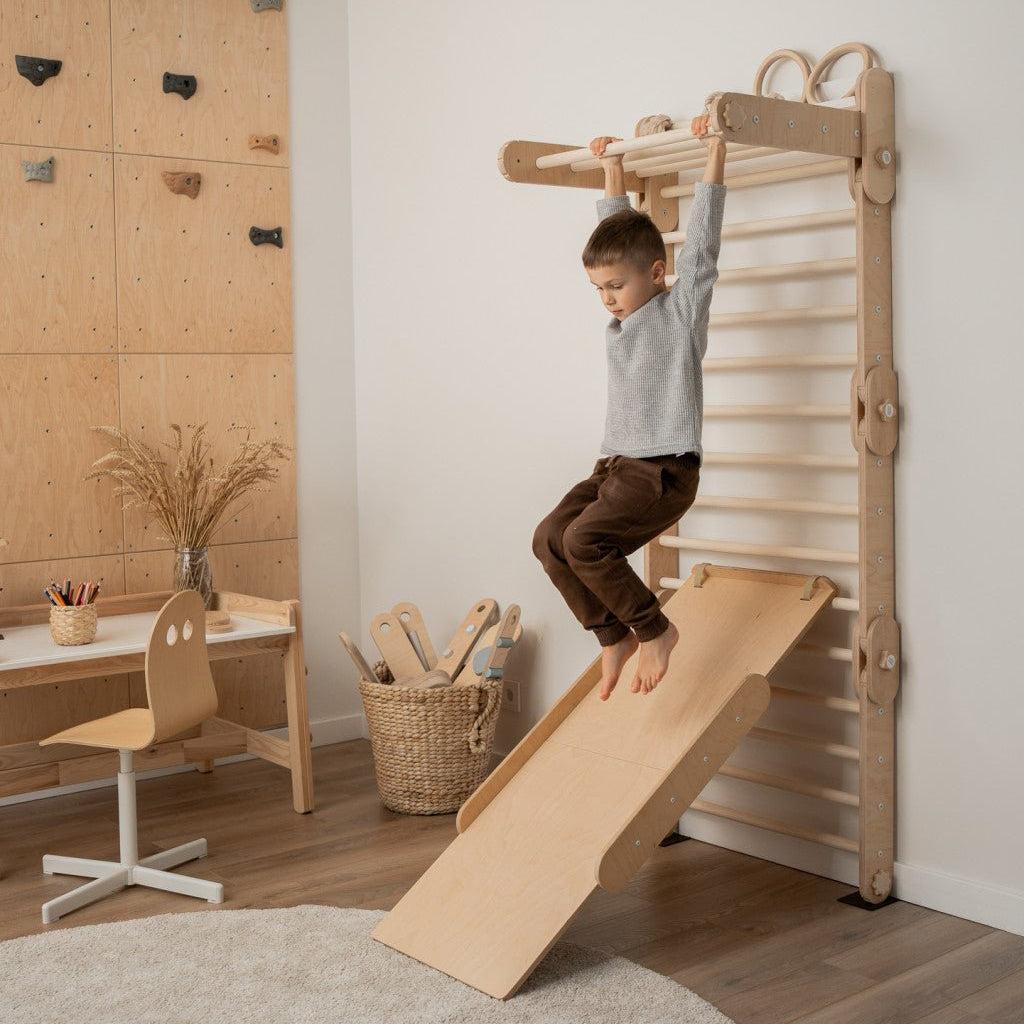
Wandhalterung FULL MOON | verwandelt dein Kletterdreieck in eine Sprossenwand
€84,00
Unit price perWandhalterung FULL MOON | verwandelt dein Kletterdreieck in eine Sprossenwand
€84,00
Unit price perWandhalterung für FULL MOON Kletterdreiecke – verwandel Dein Kletterdreieck in eine Sprossenwand
Mit der cleveren Wandhalterung wird Euer MOON Kletterdreieck im Handumdrehen zur Sprossenwand! Die stabile Befestigung ermöglicht ein sicheres, flexibles und platzsparendes Spielen – ideal für noch mehr Bewegung, Kreativität und Kletterspaß im Kinderzimmer.
Technische Daten:
• Größe Paket: 78 × 12 × 12 cm
• Produktgewicht: 3 kg
• Farbe: Natur
• Altersempfehlung: ab 3 Jahren
• Material: Hochwertiges baltisches Birkensperrholz
Lieferumfang:
• 1 × Moon Wandhalterung (Hinweis: kein Kletterdreieck oder Sprossenwand ist nicht enthalten)
Erweitere dein Spielsystem
Die Wandhalterung verwandelt die MOON Kletterdreiecke in eine Sprossenwand und bietet neue Möglichkeiten: Befestige Dein Kletterdreieck vertikal an der Wand und kombiniere sie flexibel mit Zubehör wie Rutschen, Schreibtischen, Ringen oder der Trapezstange. So entsteht ein echtes Indoor-Spielparadies – perfekt angepasst an die Entwicklungsschritte deines Kindes.
Platzsparend & vielseitig
Die Wandhalterung ist kompakt gebaut und kann auch als Regal verwendet werden, wenn das Kletterdreieck HALF MOON gerade nicht montiert ist. Damit bleibt dein Kinderzimmer ordentlich und flexibel nutzbar.
Montagehinweis:
Die Wandhalterung ist ausschließlich für massive Wände (z. B. Beton, Mauerwerk, Vollholz) geeignet. Bitte nicht auf Gipskarton, Verkleidungen oder dünne Wände montieren.
Die Montage sollte ausschließlich durch Erwachsene erfolgen – Kinder dürfen aber gerne mithelfen und so den Aufbau zu einem gemeinsamen Erlebnis machen.
Sicherheit:
Damit dein Kind rundum geschützt ist, empfehlen wir die Nutzung immer unter Aufsicht eines Erwachsenen. Unsere Produkte sind sorgfältig getestet – dennoch bitten wir um Verständnis, dass wir keine Verantwortung für etwaige Unfälle übernehmen können.
Material & Pflege:
• Hochwertiges baltisches Birkensperrholz
• Nur für den Innenbereich geeignet
• Holz vor Feuchtigkeit und direkter Sonneneinstrahlung schützen
• Reinigung mit einem trockenen oder leicht feuchten Tuch (keine scharfen Reinigungsmittel verwenden)
Hochwertige Handwerkskunst – Made in EU
Gefertigt in liebevoller Handarbeit in Lettland (EU), nach den Prinzipien von Montessori, Pikler und Waldorf. Strenge Qualitätskontrollen in jeder Produktionsphase stellen sicher, dass jedes Produkt höchsten Ansprüchen gerecht wird.
Videos:
The wall bars for home training are a multifunctional piece of exercise equipment ideal for training at home. They allow for a variety of exercises to improve strength, flexibility, and coordination.
Main features:
Height : 210 cm
Width : 70 cm
Maximum load : 80 kg
Materials : pine wood, beech stick
Equipment:
Gymnastic rings : Allow exercises to strengthen the arm and shoulder muscles.
Rope ladder : Promotes the development of coordination and dexterity.
Advantages of using:
Versatility : The wall bars are suitable for all ages and fitness levels. They allow for stretching exercises, strength training, and cardio training. The removable pull-up bar allows the wall to be adapted for various exercises.
-
Compactness : Thanks to its size, the wall can be easily installed in any room without taking up much space.
Safety : The use of natural materials such as plywood and beechwood ensures the stability and durability of the structure. The maximum load of 80 kg guarantees your safety while performing the exercises.
Supports all muscle groups: The wall bars can be used to train all major muscle groups, including back, stomach, arms and legs.
Equipment : Additional elements such as gymnastic rings and rope ladders make training more varied and interesting.
Training options:
Stretching and flexibility training: Stretching exercises help improve the flexibility and mobility of the joints.
-
Strength training : The use of gymnastic rings and rope ladders allows for exercises to increase strength and endurance.
Cardio training: Intense workouts on the Swedish wall promote cardiovascular health and calorie burning.
Conclusion:
The wall bars for home workouts are an excellent choice for those who want to maintain their physical fitness at home. Combining functionality, safety, and compactness, they are an essential element of any home gym. Regardless of age and fitness level, everyone will find the right exercises on this versatile piece of equipment.
The wall bars come with reliable wall mountings. Mounting is done using six attachment points , ensuring maximum stability and safety of the structure. The mounting elements are made of high-quality materials and are suitable for most wall types. Easy installation ensures durability and reliability.
The wall bars for home training are a multifunctional piece of exercise equipment ideal for training at home. They allow for a variety of exercises to improve strength, flexibility, and coordination.
Main features:
Height : 210 cm
Width : 60 cm
Maximum load : 80 kg
Materials : pine wood, beech stick
Equipment:
Gymnastic rings : Allow exercises to strengthen the arm and shoulder muscles.
-
Rope ladder : Promotes the development of coordination and dexterity.
Slide : Adds a playful aspect to training and is especially useful for children.
Advantages of using:
Versatility : The wall bars are suitable for all ages and fitness levels. They allow for stretching exercises, strength training, and cardio training. The removable pull-up bar allows the wall to be adapted for various exercises.
Compactness : Thanks to its size, the wall can be easily installed in any room without taking up much space.
Safety : The use of natural materials such as plywood and beechwood ensures the stability and durability of the structure. The maximum load of 80 kg guarantees your safety while performing the exercises.
-
Supports all muscle groups: The wall bars can be used to train all major muscle groups, including back, stomach, arms and legs.
Equipment : Additional elements such as gymnastic rings, rope ladder and slide make training more varied and interesting.
Training options:
Stretching and flexibility training: Stretching exercises help improve the flexibility and mobility of the joints.
Strength training : The use of gymnastic rings and rope ladders allows for exercises to increase strength and endurance.
Cardio training: Intense workouts on the Swedish wall promote cardiovascular health and calorie burning.
Playful elements : The slide and the rope ladder are especially popular with children and make training fun and attractive.
Conclusion:
The wall bars for home workouts are an excellent choice for those who want to maintain their physical fitness at home. Combining functionality, safety, and compactness, they are an essential element of any home gym. Regardless of age and fitness level, everyone will find the right exercises on this versatile piece of equipment.
The wall bars come with reliable wall mountings. Mounting is done using six attachment points , ensuring maximum stability and safety of the structure. The mounting elements are made of high-quality materials and are suitable for most wall types. Easy installation ensures durability and reliability.
The wall bars for home training are a multifunctional piece of exercise equipment ideal for training at home. They allow for a variety of exercises to improve strength, flexibility, and coordination.
Main features:
Height : 230 cm
Width : 58 cm
Maximum load : 100 kg
Materials : plywood, beech stick
Advantages of using:
Versatility : The wall bars are suitable for all ages and fitness levels. They allow for stretching exercises, strength training, and cardio training. The removable pull-up bar allows the wall to be adapted for various exercises.
Compactness : Thanks to its size, the wall can be easily installed in any room without taking up much space.
-
Safety : The use of natural materials such as plywood and beechwood ensures the stability and durability of the structure. The maximum load of 100 kg guarantees your safety while performing the exercises.
Supports all muscle groups: The wall bars can be used to train all major muscle groups, including back, stomach, arms and legs.
Training options:
Stretching and flexibility training: Stretching exercises help improve the flexibility and mobility of the joints.
Cardio training: Intense workouts on the Swedish wall promote cardiovascular health and calorie burning.
Conclusion:
The wall bars for home workouts are an excellent choice for those who want to maintain their physical fitness at home. Combining functionality, safety, and compactness, they are an essential element of any home gym. Regardless of age and fitness level, everyone will find the right exercises on this versatile piece of equipment.
The wall bars come with reliable wall fasteners. Mounting is done using six attachment points , ensuring maximum stability and safety of the structure. The fasteners are made of high-quality materials and are suitable for most wall types. Easy installation ensures durability and reliability.

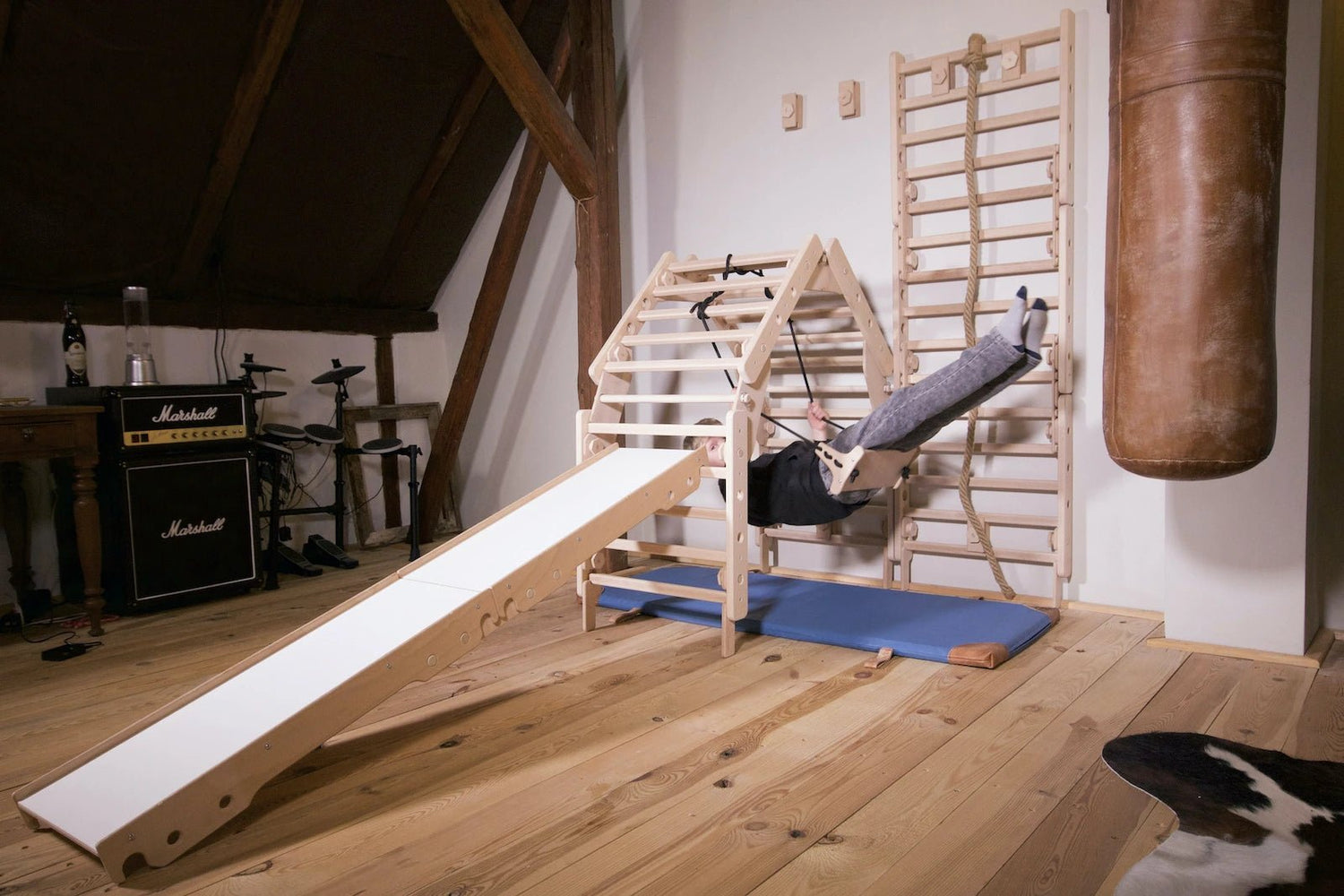
Sprossenwand | EMMA | 40-in-1 | EMMA | 200Kg belastbar I 3–99 Jahre | 40 Aufbauvarianten
€1.299,00
Unit price perSprossenwand | EMMA | 40-in-1 | EMMA | 200Kg belastbar I 3–99 Jahre | 40 Aufbauvarianten
€1.299,00
Unit price perSprossenwand EMMA 40-in-1 | 200 kg belastbar | 3–99 Jahre | 40 Aufbauvarianten
Das modulare Kletter- und Bewegungssystem für Kinder ab 3 Jahren – für Spiel, Bewegung und Kreativität in unzähligen Varianten.
Das EMMA 40-in-1 ist unser vielseitigstes Kletter-Set – ein echtes Multitalent für Bewegung, Fantasie und Abenteuer. Mit bis zu 40 verschiedenen Aufbaumöglichkeiten lässt sich das Set immer wieder neu kombinieren: Ob als Klettergerüst, Spielplatz, Rutsche, Schaukelstation oder Turnlandschaft – der Fantasie sind keine Grenzen gesetzt.
Täglich neu entdecken
Zwei Schaukeln, eine Doppelrutsche, zahlreiche Verbindungselemente und stabile Holzbauteile ermöglichen immer neue Kombinationen. Kinder erleben aktive Bewegung und gestalten ihre eigenen Abenteuer – eine spielerische Alternative zum Bildschirm, die Körperwahrnehmung, Gleichgewicht und Selbstvertrauen fördert.
Für die ganze Familie
Das Set ist für Kinder ab 3 Jahren geeignet und durch seine hohe Belastbarkeit bis zu 200 kg auch von Jugendlichen und Erwachsenen mitnutzbar. Die hochwertigen Materialien aus Massivbuche sowie Buchen- und Birkensperrholz sind langlebig, stabil und nachhaltig.
Produktdetails auf einen Blick
| Altersempfehlung | 3–99 Jahre |
| Belastbarkeit | bis 200 kg (Details siehe Anleitung) |
| Material | Massivbuche, Buchen- & Birkensperrholz |
| Oberfläche | naturbelassen, pflegeleicht abwischbar |
| Gesamtgewicht | ca. 47,8 kg |
| Anzahl der möglichen Konstruktionen | mind. 40 |
Beispiele für Aufbauvarianten
- Großes & kleines Kletterdreieck
- Brücken, Überhänge & Verstecke
- Wandmontierte Kletterelemente
- Schaukelstationen mit Classic- & Poma-Schaukel
- Doppelrutsche & Kletterseil
- Turnelemente wie Trapez oder Klimmzugstange
Im Set enthalten
- 7 × Loopo-Paneele
- 2 × Rutschbahnen
- 2 × Schaukeln (Classic & Poma)
- 1 × Kletterseil
- Verbindungselemente, Schrauben & Zubehör
- Wandhalterungen, Stabilisierungsriemen, Holzstangen
- 📄 Aufbauanleitung (PDF)
Zertifizierte Sicherheit
- EN 71-1:2014+A1:2018 – Mechanische & physikalische Eigenschaften
- EN 71-8:2018 – Sicherheit für Bewegungsspielzeuge
Pflegehinweise
Die unbehandelten Holzoberflächen können mit einem trockenen oder leicht feuchten Tuch gereinigt werden. Keine aggressiven Reinigungsmittel oder Scheuerschwämme verwenden. Kratzer oder Farbrückstände lassen sich mit feinem Schleifpapier (Körnung 180–240, in Faserrichtung) entfernen.
EMMA 40-in-1 – Bewegung erleben, Vielfalt entdecken.
Ein Bausatz, unzählige Möglichkeiten – und jeden Tag ein neues Abenteuer.


Sprossenwand LOOPO JUNGLE 20in1 | 200 kg belastbar | 2–99 Jahre | 20 Aufbauvariante
€959,00
Unit price perSprossenwand LOOPO JUNGLE 20in1 | 200 kg belastbar | 2–99 Jahre | 20 Aufbauvariante
€959,00
Unit price perSprossenwand LOOPO 20in1 | 200 kg belastbar | 2–99 Jahre | 20 Aufbauvarianten
Klettern, Bauen, Toben – ein Set, unendliche Abenteuer.
Das LOOPO JUNGLE 20in1 ist das perfekte Set für kleine Entdecker mit großem Bewegungsdrang. Es bietet bis zu 20 verschiedene Aufbauvarianten und verwandelt jedes Kinderzimmer oder jeden Garten in eine abenteuerliche Kletterlandschaft. Vom geheimen Versteck bis zum actionreichen Spielparcours – mit nur wenigen Handgriffen wird das Set immer wieder neu erfunden.
Ein echtes Abenteuer-Spielsystem
Dieses vielseitige Klettergerüst fördert aktives Spielen, körperliche Entwicklung und kreative Problemlösung. Ob Schaukeln, Klettern, Rutschen oder eine neue Welt bauen – das Set inspiriert zum eigenständigen Spiel, zur Teamarbeit und zu viel Bewegung abseits des Bildschirms.
Robust & sicher für Klein und Groß
Empfohlen ab 2 Jahren, ist das Set durch seine Belastbarkeit bis zu 200 kg auch für ältere Kinder, Jugendliche und Erwachsene geeignet. Die Bauteile bestehen aus stabiler Massivbuche sowie Buchen- und Birkensperrholz und sind für den intensiven täglichen Gebrauch gemacht.
Produktdetails auf einen Blick
| Altersempfehlung | 2–99 Jahre |
| Belastbarkeit | bis 200 kg (Details siehe Anleitung) |
| Material | Massivbuche, Buchen- & Birkensperrholz |
| Oberfläche | naturbelassen, pflegeleicht abwischbar |
| Gesamtgewicht | ca. 33,5 kg |
| Anzahl möglicher Konstruktionen | mind. 20 |
Beispiele für Aufbauvarianten
- Kletterdreiecke & Brücken
- Wandmontierte Schaukel- & Kletterelemente
- Überhänge & Abenteuerverstecke
- Turnelemente wie Trapez, Sprossenwand & Klimmzugstange
Im Set enthalten
- Modular einsetzbare Holzpaneele und Verbindungselemente
- Schaukel- & Rutschkombinationen
- Holzstangen, Wandhalterungen, Schraubensets
- 📄 Aufbauanleitung (PDF)
Geprüft & zertifiziert
- EN 71-1:2014+A1:2018 – Mechanische & physikalische Sicherheit
- EN 71-8:2018 – Sicherheit für Spielzeuge zur aktiven Bewegung
Pflegehinweise
Die unbehandelten Holzoberflächen lassen sich mit einem trockenen oder leicht feuchten Tuch reinigen. Bitte keine aggressiven Reinigungsmittel oder raue Schwämme verwenden. Kratzer oder Flecken lassen sich sanft mit feinem Schleifpapier (Körnung 180–240) in Faserrichtung entfernen.
LOOPO JUNGLE 20in1 – Spielraum für echte Abenteuer.
Wechselnde Aufbauten, aktive Bewegung und kreative Freiheit – Tag für Tag aufs Neue.


Sprossenwand LOOPO MINI GYM 5in1 | 180 kg belastbar | 2–99 Jahre | 5+ Aufbauvarianten
€539,00
Unit price perSprossenwand LOOPO MINI GYM 5in1 | 180 kg belastbar | 2–99 Jahre | 5+ Aufbauvarianten
€539,00
Unit price perSprossenwand LOOPO MINI GYM - 180 kg belastbar und damit für Groß und Klein geeignet mit 5+ Aufbauvarianten
Das kompakte Kletterset mit maximaler Bewegungsfreiheit – ideal für Kinder ab 2 Jahren.
Das MINI GYM ist ein mittelgroßes Kletterset, das eine Vielzahl an Bewegungsmöglichkeiten bietet – ob als kleines oder großes Pikler-Dreieck, , klassisches Kletterelement am Boden oder als Wandmontage mit Klimmzugstange. In wenigen Handgriffen passt sich das Set dem Alter, den Fähigkeiten und den Interessen des Kindes an – perfekt für wachsende Bewegungsbedürfnisse.
Für die natürliche Entwicklung
Dieses Set fördert Koordination, Kraft und Selbstvertrauen auf spielerische Weise. Es ist ideal geeignet für die ersten Kletterversuche bis hin zu gezieltem Training am Reck. Gleichzeitig ist es durch seinen modularen Aufbau mit anderen EMMA-Sets erweiterbar und bildet so eine stabile Grundlage für den eigenen Indoor-Spielplatz.
Stabil & platzsparend
Mit einer Belastbarkeit bis zu 180 kg und einem Gesamtgewicht von nur rund 18 kg ist das LOOPO MINI GYM besonders stabil, dabei aber leicht umzubauen. Die Bauteile bestehen aus hochwertiger massiver Buche und langlebigem Buchensperrholz – für viele Jahre voller Kletterfreude.
Produktdetails auf einen Blick
| Altersempfehlung | 2–99 Jahre |
| Belastbarkeit | bis 180 kg (Details siehe Anleitung) |
| Material | Massivbuche & Buchensperrholz |
| Oberfläche | naturbelassen, pflegeleicht abwischbar |
| Gesamtgewicht | ca. 18,2 kg |
| Hergestellt | in Tschechien |
Mögliche Varianten
- Kleines & großes Pikler-Dreieck
- „Clicker“-Gerüst
- Leiter mit Trapez
- Wandmontierte Kletterelemente mit Klimmzugstange
Packungsinhalt
- 4 × Paneele
- 4 × Verbindungsstück E1
- 2 × Verbindungsstück Winkel T2
- 3 × Wandhalterung W1
- 2 × Verbindungsstück Füße F1
- 1 × Reckstütze H1
- 12 × Schrauben (35 mm)
- 4 × Schrauben (50 mm)
- 1 × Unterlegscheibe
- 1 × Holzstange mit Splinten
- 1 × Schlüssel
Aufbau & Anleitung
- 📄 Aufbauanleitung: im Lieferumfang enthalten (PDF)
Geprüft & zertifiziert
- EN 71-1:2014+A1:2018 – Sicherheit mechanischer Eigenschaften
- EN 71-8:2018 – Sicherheit für aktive Bewegungsspielzeuge
Pflegehinweise
Die Holzoberflächen sind naturbelassen und lassen sich mit einem trockenen oder leicht feuchten Tuch reinigen. Aggressive Reinigungsmittel oder raue Schwämme sollten vermieden werden. Leichte Kratzer oder Farbspuren lassen sich durch vorsichtiges Schleifen (Körnung 180–240, in Faserrichtung) entfernen.
Fazit
Das MINI GYM ist das perfekte Einstiegsset in die modulare Spielwelt. Es begleitet dein Kind über viele Jahre, fördert Bewegung, Selbstständigkeit und Kreativität – und lässt sich jederzeit erweitern. Ein langlebiges, mitwachsendes System, das sich flexibel an den Alltag und die Fantasie deines Kindes anpasst.
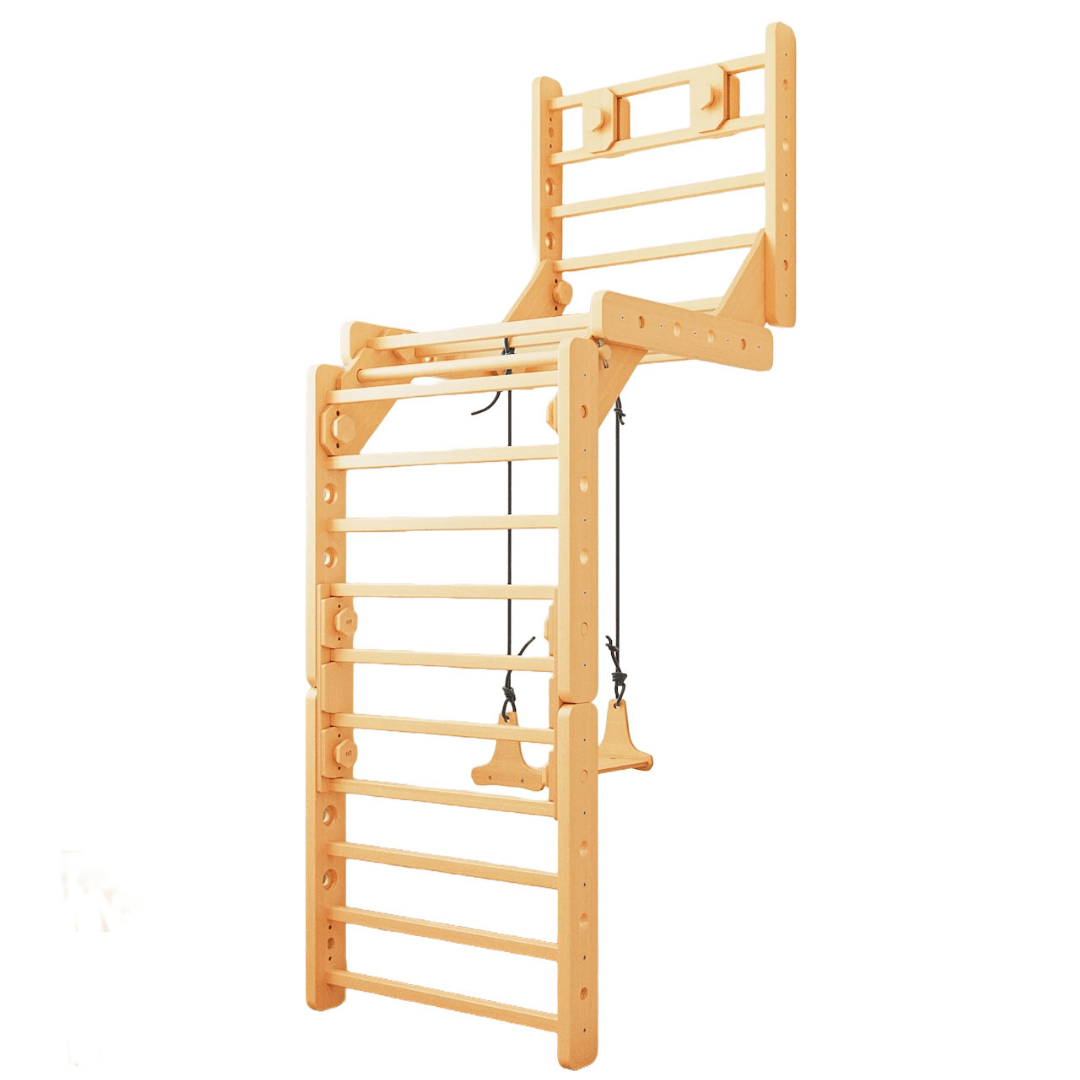

Sprossenwand LOOPO CLIFF + Schaukel | 4 Module | 200 kg belastbar | 6 Aufbauvarianten | modulares System
€449,00
Unit price perSprossenwand LOOPO CLIFF + Schaukel | 4 Module | 200 kg belastbar | 6 Aufbauvarianten | modulares System
€449,00
Unit price perSprossenwand LOOPO CLIFF - Kletterdreieck & Sprossenwand
Kletterspaß mit Mut-Faktor – das Abenteuer-Set für Kinder ab 2 Jahren. Von Kletterdreieck bis Sprossenwand mit Hangel-Brücke - mit 6 verschiedenen Aufbauvarianten kommt Abwechslung ins Haus und macht Kinder und mit einer Belastbarkeit von 220 kg Erwachsene ebenso glücklich.
Das LOOPO CLIFF ist ein kompaktes, aber herausforderndes Kletterset, das Kinder zum aktiven Spielen, Balancieren und Kraftaufbau einlädt. Mit bis zu sechs Aufbauvarianten, darunter Brücken, Kletterdreiecke, eine Wand-Schaukel und eine Brücke, bietet das Set vielseitige Bewegungsreize – perfekt für kleine Entdecker mit großem Bewegungsdrang. Dieses modulare LOOPO System kann unendlich erweitert werden.
Das Highlight: Die Hangel-Brücke
Die Hangel-Brücke kann ab 4 Modulen gebaut werden und macht dieses Set zu etwas ganz Besonderem. Kinder können sich hier spielerisch an die Schwerkraft herantasten, ihre Kraft trainieren und ihr Selbstvertrauen stärken – ideal für wachsende Bewegungsfreude und motorische Entwicklung.
Robust, wandelbar & erweiterbar
Gefertigt aus langlebiger massiver Buche und stabilem Buchensperrholz ist das Set bis 200 kg belastbar. Es eignet sich für Kinder im Alter ab 2 Jahren und lässt sich mit weiteren ANTONIE EMMA PANEELE nach und nach zu einem großen Kletteruniversum ausbauen.
Fördert wichtige Fähigkeiten
• Verbesserung von Gleichgewicht, Koordination und Beweglichkeit
• Stärkung der Muskulatur und Erwerb motorischer Fähigkeiten
• Förderung von Selbstvertrauen und kognitiver Entwicklung
• Sorgt für Ausgeglichenheit, guten Schlaf und beste Laune
Produktdetails auf einen Blick
| Altersempfehlung | 2–99 Jahre |
| Belastbarkeit | bis 200 kg (Details siehe Anleitung) |
| Material | Massivbuche & Buchensperrholz |
| Oberfläche | geölt, pflegeleicht abwischbar |
| Gesamtgewicht | ca. 16,6 kg |
| Aufbaumöglichkeiten | mind. 6 |
Beispiele für Aufbauvarianten
- Kleines Kletterdreieck
- Zwei Brückenkonstruktionen
- „Klicker“-Gerüst
- Wandmontierte Schaukelstation
- Überhang-Kletterstruktur
Packungsinhalt
- 4 × Paneele
- 2 × Verbindungsstück E1
- 4 × Verbindungsstück Winkel T2
- 2 × Wandhalterung W1
- 12 × Schrauben (35 mm)
- 2 × Holzstangen mit Splinten
- 1 × Schaukel „Classic“
- 1 × Schlüssel
Aufbau & Anleitung
- 📄 Aufbauanleitung: im Lieferumfang enthalten (PDF)
Geprüft & zertifiziert
- EN 71-1:2014+A1:2018 – Mechanische Sicherheit
- EN 71-8:2018 – Sicherheit von Bewegungsspielzeug
Pflege & Verwendung
Die Oberfläche ist mit einem natürlichen Öl behandelt und dadurch geschützt. Zur Reinigung reicht ein trockenes oder leicht feuchtes Tuch – bitte keine scharfen Reinigungsmittel oder scheuernden Schwämme verwenden. Um die Langlebigkeit zu erhalten, kann die geölte Oberfläche bei Bedarf mit geeignetem Pflegeöl aufgefrischt werden.
Nachhaltigkeit, Sicherheit & Qualität – dafür steht die EMMA-Serie
Alle EMMA-Produkte werden aus massivem, geöltem Buchenholz gefertigt, das aus FSC-zertifizierter, europäischer Waldwirtschaft stammt. Produziert wird im Böhmischen Paradies in Tschechien – unter fairen Bedingungen, mit kurzen Lieferwegen und umweltfreundlicher Verpackung. Die Spielgeräte erfüllen die europäische Spielzeugnorm EN 71 und sind bis zu 200 kg belastbar – geprüft und geeignet für Kinder und Erwachsene. Zusätzlich bietet EMMA 2 Jahre Garantie – mit kostenfreier Verlängerung auf 5 Jahre bei Registrierung. Nachhaltig. Sicher. Fair.
LOOPO CLIFF – für kleine Gipfelstürmer mit großen Zielen.
Modular, langlebig und voller Herausforderungen – das perfekte Kletter-Set für aktive Kids.


Dreieck- & Sprossenwandschaukel LOOPO SWING 2in1 | 180 kg belastbar | 2 Geräte in einem | Kletterdreieck & Schaukel für die Wand | wandelbar
€239,00
Unit price perDreieck- & Sprossenwandschaukel LOOPO SWING 2in1 | 180 kg belastbar | 2 Geräte in einem | Kletterdreieck & Schaukel für die Wand | wandelbar
€239,00
Unit price perKletterdreieck & Sprossenwand mit Schaukel LOOPO SWING | 180 kg belastbar | 2-in-1 Spielgerät ab 1 Jahr
Klettern oder Schaukeln? Warum nicht beides – mit einem Set, das sich ganz einfach verwandeln lässt.
Die Sprossenwandschaukel LOOPO ist ein kompaktes, wandelbares Spielgerät für Kinder ab 1 Jahr. Es bietet zwei Möglichkeiten in einem cleveren System: Als freistehendes Pikler-Dreieck eignet es sich ideal für erste Kletterversuche – befestigt an der Wand, wird es zur Schaukelstation im Montessori-Stil. Einfache Handhabung, sicheres Design und jede Menge Bewegung machen dieses Set zu einem beliebten Spielbegleiter für drinnen und draußen. Dieses modulare EMMA System kann unendlich erweitert werden.
Ideal für kleine Räume & große Spielfreude
Dank seiner kompakten Größe und der vielseitigen Nutzbarkeit passt das Set auch in kleinere Wohnbereiche. Es lädt Kinder dazu ein, sich aktiv zu bewegen, ihre Motorik zu fördern und gleichzeitig spielerisch Selbstvertrauen aufzubauen.
Produktdetails auf einen Blick
| Altersempfehlung | 1–6 Jahre |
| Belastbarkeit | bis 180 kg |
| Material | Massivholz Buche |
| Oberfläche | glatt geschliffen & geölt |
| Gesamtgewicht | ca. 9,1 kg |
| Aufbaumöglichkeiten | 2 |
| Pikler-Dreieck | H 46 cm × B 97 cm × T 60 cm |
| Schaukelstation (wandmontiert) | H 200 cm × B 60 cm × T 70 cm |
Packungsinhalt
- 2 × LOOPO-Paneele
- 2 × Verbindungsstück Winkel T2
- 2 × Wandhalterung W1
- 4 × Schrauben (35 mm)
- 2 × Stabilitäts-Metallstifte
- 1 × Holzstange mit Splinten
- 1 × Schaukel „Classic“
- 1 × Schlüssel
Aufbau & Anleitung
- 📄 Aufbauanleitung: im Lieferumfang enthalten (PDF)
Geprüft & zertifiziert
- EN 71-1:2014+A1:2018 – Sicherheit mechanischer Eigenschaften
- EN 71-8:2018 – Sicherheit aktiver Bewegungsspielzeuge
Pflege & Verwendung
Die Oberfläche ist mit einem natürlichen Öl behandelt und dadurch geschützt. Zur Reinigung reicht ein trockenes oder leicht feuchtes Tuch – bitte keine scharfen Reinigungsmittel oder scheuernden Schwämme verwenden. Um die Langlebigkeit zu erhalten, kann die geölte Oberfläche bei Bedarf mit geeignetem Pflegeöl aufgefrischt werden.
Nachhaltigkeit, Sicherheit & Qualität – dafür steht die LOOPO-Serie
Alle EMMA-Produkte werden aus massivem, geöltem Buchenholz gefertigt, das aus FSC-zertifizierter, europäischer Waldwirtschaft stammt. Produziert wird im Böhmischen Paradies in Tschechien – unter fairen Bedingungen, mit kurzen Lieferwegen und umweltfreundlicher Verpackung. Die Spielgeräte erfüllen die europäische Spielzeugnorm EN 71 und sind bis zu 200 kg belastbar – geprüft und geeignet für Kinder und Erwachsene. Zusätzlich bietet EMMA 2 Jahre Garantie – mit kostenfreier Verlängerung auf 5 Jahre bei Registrierung. Nachhaltig. Sicher. Fair.
Kletterdreieck - & Sprossenwandschaukel LOOPO SWING – für Kletterfreude mit Schwung.
Ideal für alle, die Bewegung lieben – platzsparend, vielseitig und kindgerecht.


wandelbare Sprossenwand LOOPO MONKEY 7in1 | 200 kg belastbar | 2–99 Jahre | 7 Aufbauvarianten | modulares System
€689,00
Unit price perwandelbare Sprossenwand LOOPO MONKEY 7in1 | 200 kg belastbar | 2–99 Jahre | 7 Aufbauvarianten | modulares System
€689,00
Unit price perLoopo Monkey 7in1 – Modulares Klettergerüst für drinnen & draußen
Entdecken, bewegen, wachsen: Das wandelbare Klettergerüst Loopo Monkey 7in1 bringt Action und Entwicklung ins Kinderzimmer! Aus robustem Massivholz gefertigt und mit bis zu 200 kg belastbar, begleitet es dein Kind über viele Jahre hinweg – von den ersten Kletterversuchen bis zu kreativen Aufbauvarianten für die ganze Familie.
Mit 7 verschiedenen Aufbaumöglichkeiten – darunter Pikler-Dreieck, Kletterwand, Brücke, Doppelschaukel oder Rutschen-Setup – passt sich das Loopo Monkey flexibel dem Alter und den Fähigkeiten an. Für noch mehr Spielspaß lassen sich weitere Elemente aus der Loopo-Serie kombinieren.
Highlights auf einen Blick
-
7-in-1 Design: Pikler-Dreieck, Brücke, Panther, Klicker, Sprossenwand, Schaukelstation & Rutschbahn
-
Wächst mit: Anpassbar für Kinder von 2–99 Jahren
-
Belastbar & sicher: Bis zu 200 kg Tragkraft – aus Massivbuche & Birken-/Buchensperrholz
-
Drinnen & draußen: Für Wohnzimmer, Kinderzimmer oder geschützte Außenbereiche
-
Erweiterbar: Kompatibel mit allen Loopo-Elementen für grenzenlose Spielformen
Produktdetails
| Merkmal | Beschreibung |
|---|---|
| Produktart | Modulares Klettergerüst (Indoor) |
| Modell | Loopo Monkey 7in1 |
| Hersteller | Loopo |
| Material | Massivbuche, Buchen- und Birkensperrholz |
| Farbe | Natur |
| Rutsche | 2 × Rutschbahn, kombinierbar |
| Schaukel | 1 x Classic-Schaukel inklusive |
| Aufbauvarianten | 7 |
| Belastbarkeit | Bis 200 kg (je nach Aufbau), Wandmodul: 15–75 kg |
| Max. Kinder gleichzeitig | Abhängig von Aufbau & Nutzung |
| Altersempfehlung | 2–99 Jahre |
| Herkunft | Europa, Tschechien |
| Zertifikate | EN 71-1 & EN 71-8 (Sicherheit aktiver Spielgeräte) |
Lieferumfang
-
3 × Loopo-Paneele
-
4 × Winkelverbindung T2
-
2 × Winkelverbindung T3
-
4 × Verbindungsstück E1
-
3 × Wandhalterung W1
-
2 × Fußverbindung F1
-
1 × Verbindung SL1 für Rutschen
-
2 × Rutschbahnen
-
1 × Classic-Schaukel
-
1 × Kletterseil
-
Schrauben, Muttern, Metallstifte
-
Aufbauanleitung (PDF) & Video-Tutorials
Fördert wichtige Fähigkeiten
• Verbesserung von Gleichgewicht, Koordination und Beweglichkeit
• Stärkung der Muskulatur und Erwerb motorischer Fähigkeiten
• Förderung von Selbstvertrauen und kognitiver Entwicklung
• Sorgt für Ausgeglichenheit, guten Schlaf und beste Laune
Aufbau & Anwendung
Das Set lässt sich innerhalb kurzer Zeit aufbauen und je nach Aufbauform flexibel umstellen. Dank klarer Anleitung und unterstützender Videos ist die Montage auch für Laien problemlos möglich. Ideal für Wohnzimmer, Kinderzimmer oder geschützte Außenbereiche.
Sicherheit
Sicherheit: Für ein rundum sicheres Spiel empfehlen wir, dein Kind jederzeit von einem Erwachsenen begleiten zu lassen. Unsere Produkte sind stabil und durchdacht – dennoch bitten wir um dein Verständnis, dass wir keine Verantwortung für etwaige Unfälle übernehmen können.
Pflege & Verwendung
Die naturbelassene Holzoberfläche ist besonders pflegeleicht: Reinige sie einfach mit einem trockenen oder leicht feuchten Tuch. Vermeide aggressive Reinigungsmittel oder Scheuerschwämme. Kratzer lassen sich durch sanftes Schleifen mit feinem Schleifpapier (Körnung 180–240) entfernen.
Hochwertige Handwerkskunst aus Europa
Loopo Monkey steht für nachhaltige Qualität aus europäischer Fertigung – ganz ohne chemische Lacke, mit höchsten Sicherheitsstandards und durchdachter Funktionalität.
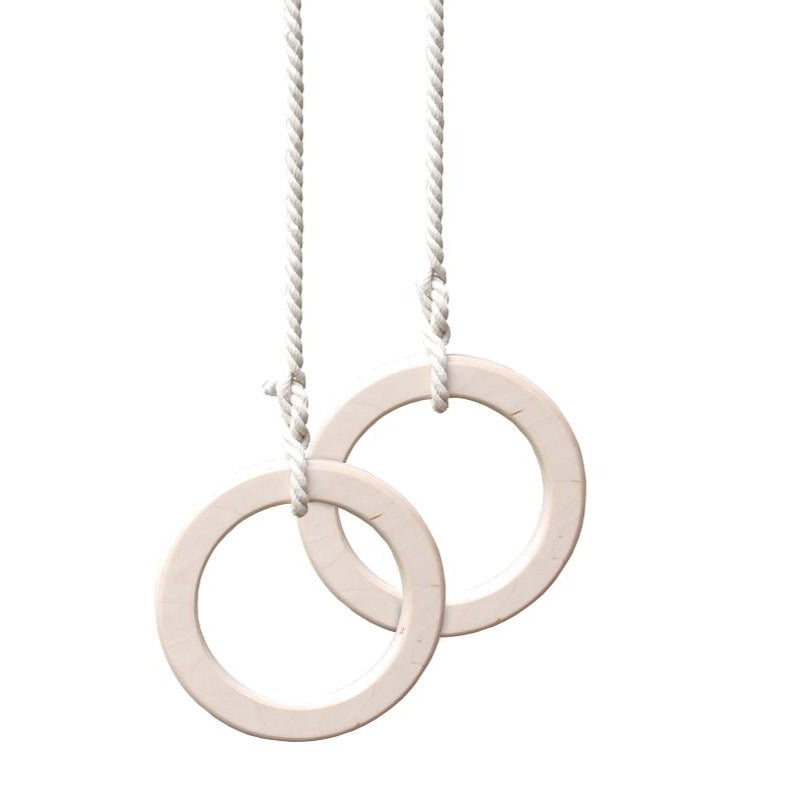
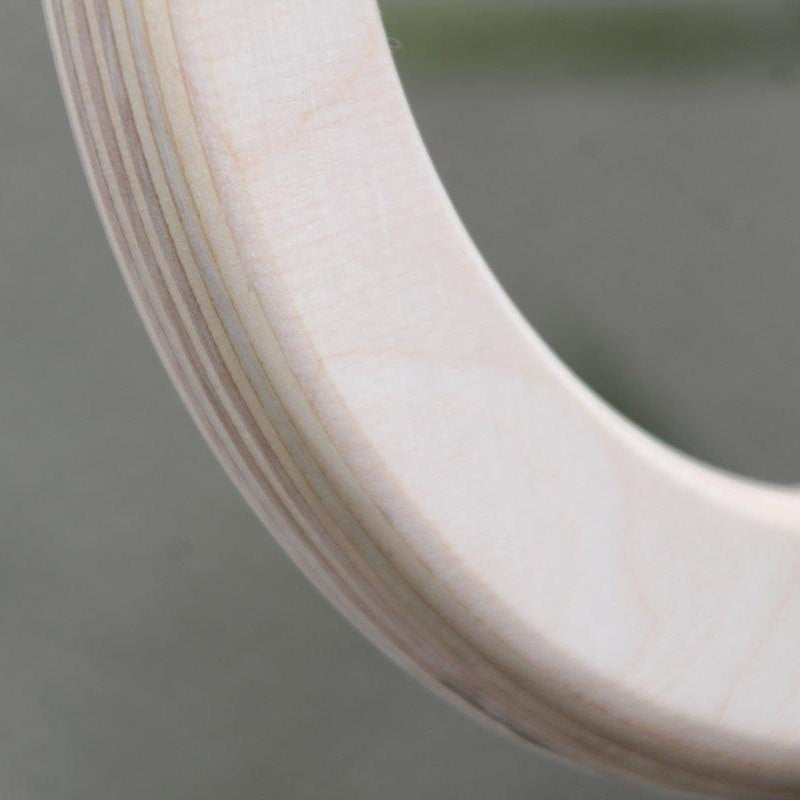
Gymnastic rings - rings made of wood and natural rope perfect for the wall bars - set of 2
€49,00
Unit price perGymnastic rings - rings made of wood and natural rope perfect for the wall bars - set of 2
€49,00
Unit price perOur gymnastic ringsÖÖturnthe children's room, playground or wall bars into a jungle and every climber becomes a swinging monkey. These beautiful, handmade rings can be easily attached anywhere that swings can be attached. But above all, of course, on our wall bars Giraffenling. Simply knot the thick natural rope. The rope is really soft and woven from natural cotton and is nice and thick, making it easy to grip, so you can simply swing the rope over a beam.
Features: can be hung on our wall bars and on any beam soft natural cotton rope
Can be combined with: Giraffenling wall bars
Age recommendation: suitable from 2 years
Material: Untreated birch plywood Cotton rope
Dimensions: Rings each approx. 19.5 cm in diameter, rope approx. 115 cm long
Showing 20/30
Entdecke Kletterling
Kletterdreiecke sind nur der Start in eine bewegte Kindheit. Du findest bei uns Kindermöbel, Sprossenwände, Sitzsäcke, Sofas, Schaukeln und noch so viel mehr.

Familienunternehmen mit Herz
Persönlich beraten
Wir beraten dich persönlich in Entwicklungs- und Einrichtungsfragen bequem zu Hause. Schon ein paar leicht aufzustellende und sichere Bewegungselemente, wie ein Kletterdreieck, verändern die Auslastung deines Kindes und damit seine Stimmung zum Positiven. Doch das ist nur der Anfang, mit uns kannst du euer Zuhause in einen Ort verwandeln, in dem dein Kind jederzeit seinem Bedürfnis nach Bewegung und Entspannung nachgehen kann und dann passiert etwas Magisches, wie von Zauberhand zieht Gelassenheit bei euch ein, in deinem Kind und in dir!
Wir sind Isabell, Erik und Kosmo. Gegründet haben wir Kletterling aus der Not heraus: Qualität wird so oft mit Marketing-Blabla vorgetäuscht. Wir wollen so viel Transparenz, wie möglich ist. Aus welchem Material ist mein Kinderspielzeug, woher kommt es und wurden Chemikalien verwendet? Wie steht es um die Sicherheit und wird es wirklich in Europa produziert? In China produziert, in Deutschland zusammengebaut und dann Made in Germany, gibt es bei uns nicht. Alle Produkte stammen von kleinen Herstellern aus Europa, denen wir hier ihre verdiente Plattform bieten. Dabei hapert es meist am Kundendienst in einer fremden Sprache, den wir komplett übernehmen, weil wir es lieben, mit euch im Austausch zu stehen, was heutzutage leider immer seltener wird.
Außerdem kaufst du bei uns mit sicheren Zahlmethoden in Deutschland bei einem deutschen Unternehmen ein, was dir ein gutes Gefühl und Sicherheit bringt, damit du dich voll auf das konzentrieren kannst, weshalb du hier bist: Das richtige Bewegungsspielzeug für dein Kind zu finden.
Danke für dein Vertrauen!
- Isabell & Erik
Kategoriebeschreibung
Wall bars: Your guide to fitness & fun at home
Wall bars are more than just a piece of exercise equipment: They're a versatile training tool that promotes physical development while being fun. In recent years, wall bars have become increasingly popular, particularly in early childhood education and home training. This is due not only to the flexibility and variety of exercises that can be performed with wall bars, but also to the fact that they can improve important motor skills and physical fitness.
But what makes wall bars so special, and how can they best be integrated into everyday life or into children's play and learning environments? In this article, we delve deeper into the world of wall bars, explore their benefits, and offer practical tips on how to best use this versatile piece of equipment. Get ready to expand your understanding of wall bars and discover how they can take physical activity to a new level.
What can you do with wall bars?
 A wall bar is a versatile piece of exercise equipment that is perfect for a child's room, a home gym, or even a gym.
A wall bar is a versatile piece of exercise equipment that is perfect for a child's room, a home gym, or even a gym.
With a wall bar you can perform a variety of exercises that improve both strength and mobility.
For children
- Playful climbing: Children love to climb.
- A wall bar in the children's room provides them with a safe environment in which they can develop their motor skills and balance.
- Combination with other play equipment: The wall bars can be combined with slides or a swing to create a small indoor playground.
For adults
- Fitness exercises Use the wall bars for pull-ups, leg raises, or back exercises. They're ideal for bodyweight exercises and can help strengthen muscles in a targeted way.
- Stretching exercises : The rungs provide the perfect support for various stretching exercises. This can be especially helpful for relieving tension after a long day at work.
Diverse application possibilities
Whether in the children's room to encourage the little ones' love of movement or in the living room for effective home workouts, wall bars prove to be extremely useful. With their wooden or metal construction and various sizes, they fit into almost any room and can be complemented with additional equipment such as a pull-up bar.
Those who regularly train on wall bars not only improve their physical health but also lay an important foundation for an active lifestyle for their children. With the right selection of exercises, wall bars quickly become the focal point for sports and games in the family.
How wide should a wall bar be?
 The ideal width of a wall bar depends on several factors, including the space available in your home and the exercises or activities you plan to perform. For optimal performance, you should choose a wall bar that meets both your space and your training needs.
The ideal width of a wall bar depends on several factors, including the space available in your home and the exercises or activities you plan to perform. For optimal performance, you should choose a wall bar that meets both your space and your training needs.
Standard measurements for different age groups
- Wall bars for children : A smaller width of approximately 60 to 80 cm is sufficient, as children need less space to climb and develop their motor skills.
- Wall bars for adults: For fitness and strength training, a minimum width of 80 to 100 cm is recommended. This ensures sufficient space for a wide range of exercises without restrictions.
Consideration of the intended use
The planned exercises also play a role in choosing the ideal width:
- Fitness and strength training : Here, it's important to have enough space to perform movements like pull-ups or leg raises without hindrance. A wider wall bar also allows for the installation of a pull-up bar.
- In this case, the wall bars should be wide enough to allow safe climbing and playing.
Adaptation to spatial conditions
Before making a decision, the room in which the wall bars are to be installed should be measured precisely:
- Room height and width: Make sure the chosen area offers sufficient space. Consider not only the current use of the room, but also future changes to the living room or children's room.
By considering these factors, you will find the perfect balance between space utilization and functionality of your new wall bars.
How high should a wall bar be?
The height of a wall bar is a crucial factor for the effectiveness and safety of your training or play. A height of approximately 2.30 to 2.50 meters is recommended for children's rooms. At this height, children can climb safely and optimally develop their motor skills. The same applies to wall bars for adults: A minimum height of 2.30 meters is ideal for performing a wide range of exercises – from pull-ups to stretching exercises.
The distance between the rungs, as well as between the top rung and the ceiling, is also important to consider. A distance of approximately 15 to 20 cm between the rungs is considered optimal for versatile use of the wall. The top rung should be installed at least 30 cm below the ceiling to ensure sufficient space for overhead exercises while also increasing safety during use.
If the wall bars are to be equipped with accessories such as a pull-up bar or slides , additional considerations regarding the height and positioning of these elements are required. A pull-up bar integrated into the wall bars expands the workout with strength exercises and should therefore be positioned so that it is easily accessible and offers sufficient freedom of movement.
While the choice of material—wood or metal—doesn't directly influence the required wall height, it can be crucial depending on your room design preferences. Whether in a child's room or the living room, the right height for your wall bars guarantees a safe and effective training experience for both children and adults.
By following these guidelines, you can be sure that your wall bar investment will yield maximum benefits. With the right approach, the wall becomes the central element of an active home—a place where fitness and fun go hand in hand.
What does a wall bar promote in children?
 A wall bar in a child's room isn't just a play device; it actively supports a child's development. Wall bars promote a variety of skills and characteristics that are important for children's growth and development.
A wall bar in a child's room isn't just a play device; it actively supports a child's development. Wall bars promote a variety of skills and characteristics that are important for children's growth and development.
Motor skills
When climbing wall bars, children improve their gross and fine motor skills. Reaching for the rungs and pulling themselves up trains hand-eye coordination and balance.
Physical fitness
Through regular training on the wall bars, children build muscle strength, especially in the arms, legs, and torso. This contributes to healthy physical development and can prevent posture problems.
Self-confidence and independence
Overcoming challenges on the wall bars builds your child's self-confidence. With each goal achieved, their belief in their own abilities grows. This also fosters a positive attitude toward independent learning and experimentation.
Concentration and endurance
Climbing requires patience, planning, and problem-solving. Children learn to focus on a task and complete it. These skills are not only useful in sports but also promote academic performance.
Social interaction
If you have more than one child or if your child is playing with friends, the wall bars provide an excellent platform for social interaction. Playing together develops team spirit and empathy through mutual support.
Conclusion
Deciding to install wall bars at home is more than just an investment in a piece of fitness equipment. They enrich family life and support the physical and mental development of all family members. Whether in the child's room or in your own training room, wall bars adapt to the needs of children and adults alike and offer a variety of exercise options. Make sure they are the right height and width to ensure safe and effective training. With the right planning and selection, your wall bars can become a central element of an active and healthy lifestyle. Don't miss this opportunity and take the next step towards a more active home. At Kletterling you will also find a great selection of other toys that promote your child's motor skills and development. Climbing triangles , a climbing wall or a climbing frame for the garden are great ways to support your child in their development.
Frequently Asked Questions
 What are the main advantages of a wall bar in a child's room?
What are the main advantages of a wall bar in a child's room?
Wall bars promote children's motor skills, physical fitness, and self-confidence. They also support the development of concentration, endurance, and social skills through playful climbing and movement.
For which age groups is a wall bar suitable?
Wall bars are suitable for both children and adults. They allow children to enjoy climbing while adults can engage in fitness and stretching exercises.
What is the minimum height of a wall bar?
For a child's room, a height of 2.30 to 2.50 meters is recommended to ensure safe climbing. For adults, a minimum height of 2.30 meters is ideal.
What materials are used for wall bars and does the material influence the height?
Wall bars are usually made of wood or metal. The material influences the design of a wall bar, but not the required height.
How important is the distance between the rungs and the ceiling?
The distance between the bars and the ceiling is very important, as it affects the effectiveness and safety of your workout. Adequate clearance ensures that the exercises can be performed correctly and safely.
Can accessories such as pull-up bars be attached to a wall bar?
Yes, accessories such as pull-up bars can be attached to wall bars. This expands the exercise options and makes wall bars a more versatile training tool for all ages.
Discover more in: Play & Climb
Top Categories: Seesaw | Tents & Pillows | Balance Boards for Kids | Balance Beams | Arches | Climbing Arch with Slide

